
Extracts from Previous ATARN Newsletters
Index
|
antiquities, archery |
Chinese Stone and Earthenware Archery Figures (Northern Wei, Five Dynasties, Song) |
|
archery, Asian traditional |
A Report on Traditional Archery in Asia n 1959. (Indonesia and Pacific) |
|
archery, Assyrian |
|
|
archery, circus acts, Mongolia |
|
|
archery, Korea |
|
|
archery, Manchu |
|
|
archery, Sapmi |
|
|
archery, Tibetan |
|
|
archery, traditional |
|
|
army |
|
|
arrow-making, Korean |
|
|
arrows, Indo-Persian |
|
|
arrows, Tibetan |
|
|
bow, child’s |
|
|
bow, han |
|
|
bow, Indo-Persian |
|
|
bow, Khotan |
|
|
bow, Khotan |
|
|
bow, Liao |
|
|
bow, pebble |
|
|
bow, pellet |
Pellet-bows |
|
bow, pellet |
|
|
bow, reproductions, Grozer |
|
|
bow, Scythian |
|
|
bow, Sinhalese |
|
|
bow, Song |
|
|
bow, strength |
|
|
bow, Tibetan |
|
|
bow, Turkish |
|
|
bow-making,Chinese |
|
|
bow-making, Korean |
|
|
bracer (arm guard) |
|
|
crossbow, Han |
|
|
crossbow, Han |
|
|
crossbow, mechanism |
|
|
crossbow, Qin |
|
|
crossbow, Warring States |
|
|
crossbow, warring states |
|
|
crossbow, Yunnan |
|
|
dog-shooting |
|
|
exhibition, museum |
Hong Kong Museum of Coastal Defence: Asian Archery Exhibition |
|
festival |
|
|
folklore, invention of the bow |
|
|
folklore, Zhang Xian |
|
|
golf |
|
|
grip |
|
|
horseback archery |
|
|
horseback archery |
|
|
Ju Huan hao |
|
|
kyudo |
'Kyudo: Die Kunst des japanischen Bogenschießens' .Felix Hoff. (Book Review) |
|
longbow |
|
|
majra |
Korean Side-arrow guide (Arabic and Turkish Majra) |
|
Malaysia |
|
|
materials |
Traditional materials v. Modern Materials for Traditional Archery |
|
museum, Korean |
|
|
patterns, quiver |
Quiver and Bow Case Patterns by Cherrie Anne Button (1), (2) |
|
Taiwan |
|
|
tepeliks |
|
|
thingies |
|
|
tools |
|
|
training |
|
|
twist |
|
|
writing fiction |
|
|
Xibe Manchus |
|
|
yumi maker |
February 1999
Asian Traditional Archery Grip on the Bow
From Soon See <soons@sharkmm.com>
I read in a book called Arab Archery (which is a translation of a manuscript written in the 15th century) that Arabic bow has its center located at the point which is one finger width below the top of the grip. In other words, one finger width of the grip plus the the top limb plus the top siyah constitute one half of the bow while the remaining grip plus the bottom limb plus the bottom siyah constitute the other half of the bow. This means the top limb is slightly longer the the bottom limb and the top siyah is slightly longer then the bottom siyah.
According to the author (whose identity is unknown) of the manuscript, a bow with this configuration is the best. (I don't remember exactly how he put it) After reading the book, I would assume that the author nocked the arrow perpendicular to the string (not pointing down or pointing up) and the arrow would pass through the point which is one finger width below the top of the grip.
I have not read any articles on Chinese Archery that mention anything about the top limb being slightly longer than the bottom limb and I would like to know if you have.
Stephen Selby
No, I have not seen such comments in Chinese texts. Chinese bows seem always to have been symmetrical, and Chinese regarded assymetrical bows (e.g. Japanese yumi) as an oddity. But a low grip seems to be shown on some early Chinese (e.g. Han) images on archeological remains.

Painting on a Western Han pottery urn. c. 100BC
Copyright Stephen Selby 1998
However, to confuse the situation slighly, the correct grip for shooting the stone-bow always required the bow-hand to be dropped well below centre. Sometimes, it is hard to see on archaeological remains whether a stone-bow or arrow-bow is intended.
Western Han Tomb brick showing a stonebow archer on horseback
Copyright Stephen Selby 1998
As far as I know, the Chinese bow of the Qing dynasty had both limbs of the same length. Correct. But I cannot be sure that the weights of the upper and lower limbs were equal.
Soon See
I also noticed from some photos (including the one in your articles published in Instinctive Archer)
Photograph by John Tomson. c. 1865
Repro. Copyright Stephen Selby 1998
that archers shooting bows of Qing dynasty nocked their arrows at the center of the string which made the arrows point upward. I am curious to know what you think about that and if you have tried that. I have never had good result with nocking at the center of the string which makes the arrow point upward.
Stephen Selby
No. Chinese archery manuals are explicit on the point that arrows may point straight ahead (preferred) or down, but never up. The photograph in my article may not be a helpful example: I suspect the archer was getting tired of holding at full draw for the photograph and started losing his stance!
Soon See
I personally think the best place to nock an arrow is at the center of the string. If both top and bottom limbs are of the same length then the (point of the) arrow would be pointing up (which I never had successful result with, the arrow would slap my hand). If the top limb is slightly longer than the bottom limb then the arrow may be perpendicular to the string. Please let me know what you think and what your experiences were.
Stephen Selby
My understanding of modern recurves is that the upper limb is more powerful than the lower one and therefore the arrow must be nocked above centre to compensate. I do not know the theory behind that. My own Chinese shooting technique is to ensure that the arrow forms an angle at 90 degrees to the string before drawing and that it passes over my thumb slightly higher than the centre of the grip as my bow-hand fingers need to have good contact with the front of the grip.
Tom Duvernay
In regards to Korean bows, the limbs may be of similar/same length, but strength will vary between upper and lower (as will brace height).
Bede Dwyer
I have the material from the Middle East on the asymetricality of bows. It appears in Saracen Archery, where McEwen made a reproduction of the bow and tested it, and in Arab Archery. Arab Archery has descriptions of old Arab wooden bows as well as composites. The bows depicted on Sassanian silver plates generally seem to have a larger upper limb and Latham and Paterson (Saracen Archery) related this to a Central Asian prototype. However, the differences in limb size were small compared to Japanese yumis.
Crossbows in the Qin Shi Huang Tomb
From Bede Dwyer <bededw@tpgi.com.au>
This is the body of a letter I sent to Edward McEwen after buying a
book on Saturday. It is reasonably self-explanatory, except for my comments about the
bowstring. For a number of years I have doubted reconstructions of Chinese crossbows with
two little bars on either limb on the belly side of the bows. I found an excavation report
which identified the shadows in the earth of the excavation as struts to give shape to a
canvas bow-cover. This was clear in the drawings from the site. So the struts existed, but
were not attached to the bow. This was in the excavation of the terracotta warriors.
I would be interested if anyone has turned up any more information on this model crossbow,
particularly how it was reconstructed.
The letter follows:
I have just bought a book with some really interesting photos in it. I do not know if you
have seen it yet , but the title is The Qin Terracotta Army Treasures of
Lintong by Zhang Wenli published by Scala Books and Cultural Relics Publishing House,
1996, reprinted 1998.
Stephen Selby
For good photographic reproductions, see 'Bronze Chariots and Horses of Qin Shi Huang's Mausoleum' Ed. Wu Yongqi et al. Tai Da Publishing Company. ISBN 962 7084 64 6. Here is part of a relevant photograph by Guo Youming (copyright), edited and enhanced by Stephen Selby, for private research and study.

Bede Dwyer
There are a group of colour photographs of the half-size model chariots and horses made of bronze featuring some detailed pictures and a few measurements of the crossbow and arrows that accompanied one of the chariots. The arrows are of two types: blunts and narrow broadheads. The fletching is painted white as are the blunts. The arrows have nocks and are unlike western quarrels. Three imitation feathers are mounted some distance from the nock, probably equi-distant from each other and having the same relation to the nock as western target arrows (i.e. not the "Oriental" style). The shape of the feathers is similar to plain Japanese fletching: rounded leading edge, parallel top and bottom, and trailing rear edge. There was a quiver mounted on the left front corner of the chariot body. There is also a narrow box with a hinged lid and a chain suspension for storing arrows.
The reconstruction of the crossbow is problematical. The major area of
controversy, from my viewpoint, is the string. In the photograph of the chariot as
excavated (a very flat chariot), the bow is detached from the stock and the string is not
visible. The reconstructed (read "put back together") crossbow has a bronze
bridle of cord connecting it to the stock. The hole in the stock for the bridle has a
twisted string run through it tied at either end to points one sixth of the way from the
respective bow tips. This string is a piece of twisted bronze wire and it runs straight
between its end-points. The shooting string is a smooth bronze object with thicker loops
at each end hooked over the tips of the bow. The end loops seem integral as there are no
visible knots. This thicker string runs over and touches the top of the stock. The stock
has a decorated lock and butt-cap with a substantial trigger guard. The stock has a
profile similar to later Han crossbow stock, with the exception of its pistol grip, which
is an unadorned vertical cylinder dropping from the stock to the rear of the trigger
guard.
The measurements are as follows:
bow 70.2 cm
bowstring 66 cm
stock 39. 2 cm
blunt arrow 35.4 cm
broadhead arrow 35.2 cm
blunt 2.2 cm
arrow box 38 cm (l) x 5.4 cm (w) x 11.8 cm (h)
When the dimensions are doubled, an idea of a real crossbow is arrived at without too much
trouble. The nocked arrows then are seen to be just under 28 inches and the bow would be
about 55 inches long mounted on a stock of almost 31 inches. The cross-sections of the bow
can be guessed from the photographs and they suggest a bow with broad lenticular working
limbs tapering to triangular (or pentagonal) tips. The point where the binding occurs
looks to be where the working limb stops. This bow is on the way to needing reinforcing
bone strips at the nocks.
Two bars project from the front of the chariot on the centre of the left side. They are tipped with curving hooks of the type, which were though once to be mounted on the stock of the crossbow to mount the bow. This is where the crossbow sits when it is not in use. The bow is held by the hooks and the trigger guard leans against the sloping frontpanel of the chariot. If the stock were slid between the two bars, with the bow underneath, then the archer could draw the bowstring up to the lock more easily. I had often wondered how a strong crossbow could ever have been braced in a chariot.
I hope you find this interesting. I have received an e-mail from Dr Grayson and I am going
to send him a copy of this information.
Stephen Selby
I have inspected the reconstruction personally, accompanied by one of the people who worked on the excavation, Prof. WANG Xueli. He made the point to me that no matter how many original crossbow stocks have been excavated, no prods have ever been found. Not even the traces of where they had been. He and I agree that the bows were never buried with the stocks. The Qin crossbow was simply a firing mechanism for the bow, which could be removed and used as a normal bow. Each such bow required three years to manufacture, and although they were sometimes buried with tomb occupants, the burial of large numbers of such hi-tech items with models of occupants (i.e. the teracotta warriors) would have been an improbable waste of strategic materials. The bronze model (1:2 scale) is therefore the only indication we now have of the form of the original.
Prof. Wang's restoration of an actual crossbow (i.e. not the bronze model), based on remains of crossbows he excavated, is as follows.
I think this looks quite reasonable, and I wonder whether the 'inner cord' was placed on the resored bronze model in mistake for the diagrammatic view of the string positions in Prof. Wang's illustration...
This is my own restoration of the actual crossbow in use -

Bede Dwyer
The picture of the bronze model crossbow you are placing on the web page sems to show a swelling of the tip of the bow to accept the bowstring. Do you remember what the shape of the tip was? Was it flattened from side to side with an indentation on the back of the bow for the bowstring?
Stephen Selby
Yes. This slightly oblique photo shows that more clearly.
There was flattening, but I don't think there was any intentation or string nock.
Bede Dwyer
I am curious to find the earliest appearance of the single nock on the back of the
bow as a method of attaching the bowstring. I think I sent you a photocopy of an article
on bone/antler bowtips in China from Wenwu.
Stephen Selby
Jade bow tips excavated from a Shang tomb at Anyang imply this sort of nock. Presumably the development of string nocks suggests the use of loops at the ends of the string, and maybe that further suggests the introduction of the endless loop as a method of making a string...? Also, I understand that a long, freely-moving loop would be necessary if long static tips (sayahs) were to work properly. So would that leave little alternative to using string nocks on the back of the bow?
Bede Dwyer
My question is now: why were there two string positions? From the photographs of the chariots in situ, I thought that the bow was cast in a braced state.
Stephen Selby
If there were two strings, it may be that they wanted the bow not to relax completely when unstrung. The smaller string might have inhibited the bow from relaxing to a position that it would be difficult to re-string when required without removing it from the stock and using a brazier and tepliks.
Bede Dwyer
The suggestion that the bows could be dismounted and used as hand-bows is very interesting. I admit that I was wondering along those lines too. Is there any indication in the texts?
Stephen Selby
I think that later (Han and after) crossbows did have specially-constructed prods. But
I believe the earlier ones used general-purpose bows mounted on a stock.
My main reason for thinking that is the way bows and crossbows are discussed in the 'Rites
of Zhou'. The "Rites of Zhou" (you have seen and commented on my translation of
'the bowyer') mentions crossbows several times. It dates from the late Warring States
period (about 450BC) and is thought to represent the system operating at that time in the
state of Qi. Although it contains detailed instructions for making different types of
bows, there is no mention of making crossbow prods or stocks as a separate exercise.
In the description of the duties of the 'Gao Ren' ('mat man'), the Rites of Zhou says:
"There are six types of bows in three categories; four types of crossbows in the same
manner.'
The section on the 'Si Gong Shi' ('bow and arrow manager') it says: "In distributing bows, arrows, crossbows and quivers, the 'wang' and 'gu' bows are for teaching shooting to penetrate armour, wooden reinforcement and shields; the 'jia' and 'yu' bows are for teaching target shooting, fowl and wild animal shooting; 'tang' and 'da' bows are for archery study, demonstration and exercise. As regards crossbows, the 'jia' and 'yu' are for shooting against fortifications; 'tang' and 'da' are for chariot battles and warfare on open ground..."
The lack of differentiations in the names of the bows suggests to me that the primary consideration was the basic bow type, and the bow was then attached to the stock as needed.
June 1999
In Peking, I spent some time interviewing an old Chinese bowyer about the history of his family's bow workshop, which started in the Qing Dynasty under the Emperor Qianlong (in about 1750) and operated up until the Cultural Revolution in 1966.
Some members have asked me whether Chinese traditional bows can be obtained nowadays. ATARN is now able to offer reproductions of Chinese traditional bows; but they are suitable only for decoration and historical enactment: not for serious shooting. I say this because they have been made recently using a bamboo core backed with glass fibre, decorated with lacquer and snake skin. This certainly gives a convincing appearance of a Chinese bow: but their shooting qualities are poor because of inferior materials and workmanship. The bows are ambidextrous and pull at about 28# - 32#.

The cost of these bows is US$130, plus shipping. Do not order these bows for serious archery purposes. Do order if you want something interesting on the den wall, for enactment, or for getting the correct proportions for making your own Chinese or Mongolian bow. I shall be bringing a few to Denton Hill in July.
Meanwhile, with ATARN's help, I am dedicated to helping to revive the ancient, traditional bowmaking craft in China, and I shall strive to bring you fully-functional Chinese bows and arrows in due course.
I also have a supply of pre-cut water-buffalo horn for bow-making. Each matched pair is about 60 cm long by 4 cm wide coming to a point at the top. They cost US$50 per pair plus shipping.
Pellet-bows
I had a chance to study some interesting traditional Chinese pellet-bows. The bow itself is quite light, backed with sinew but without horn. (One such bow, however, had been converted from an arrow-bow which had broken and is horn-backed.) They were decorated with snakeskin and often had tips carved in the shape of a monkey's head.
The most extraordinary part of the pellet-bow, however, is the string. It is made up partly from silk bowstring and partly from rigid bamboo straps. A small cup of carved bamboo covered with sharkskin holds the baked clay pellet. The bow is drawn with the bow-hand grasping the grip below centre, imparting and outward torque to prevent the pellet from hitting the grip when the string is released. The draw-hand thumb and forefinger grip arround the cup, holding the pellet in against it. This is easy because the draw-weight does not exceed 25#. The pellet cup is drawn back to the archer's eye, and the shot is made aiming at the target past the top of the grip (which is aligned level with the pellet-cup.)
Pellet set in the pocket of the Chinese pellet bow.
This sort of bow was popular for shooting at small birds. The shot is supposed to be non-lethal: the idea was to catch birds live: not to kill them.
Yunnan Province is home to 26 cultures (including Han Chinese, Manchus and Muslims.) Many of these cultures (Shan, Khmer, Dai, Miao, Nu, Bai and Jinu) are renowned in history for their use of the crossbow. In fact, historical and archeological remains show that these tribes used the stonebow and crossbow but not the conventional arrow bow. They were famous for their use of powerful poisons on their arrows.
|
Wooden crossbow from the Nu minority, Yunnan, China |
I was able to obtain three of their traditional crossbows, goatskin quivers and bamboo darts, as the Chinese government has recently banned all hunting in their areas as an urgent wildlife conservancy measure.
 |
 |
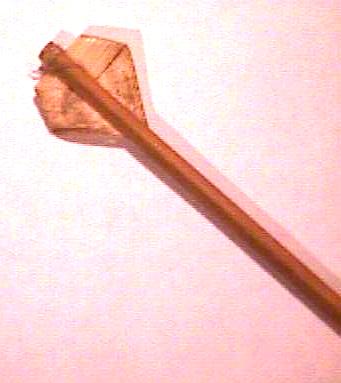 |
| Crossbow quiver of the Nu Minority of Yunnan, China | Nu crossbow dart (bamboo) | Fletching using bamboo leaf |
Later I shall put up an article on the crossbow culture of Southwestern China.
Chinese People's Liberation Army
 In Peking, I paid a visit to the Academy of Military Science of the People's Liberation Army, where I was able to study old books on Chinese archery in their archive. Staff at the Academy were very helpful and supportive of our work. After my visit, during which I introduced ATARN, staff at the Academy wrote in an email (in perfect English): "The website of ATARN is great and I believe that some people in our Academy would surely like it. "
Studying Chinese traditional archery and materials in the archives of the Academy of Military Science of the Chinese People's Liberation Army. |
November 1999
I had been thinking for some time of reconstructing the Han standard military crossbow based on the numerous bronze crossbow mechanisms (many in good working order) that appear on the market. Now I have actually done more than think about it: with the help of Ju Yuan Hao of Peking, we have actually made one.
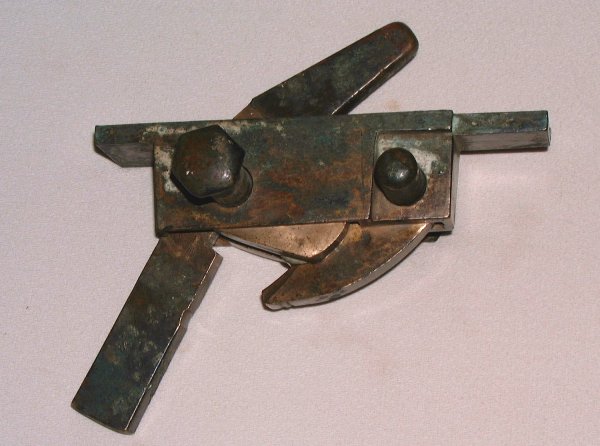
Han Military Crossbow Mechanism
 We derived the design from the bronze
model crossbow attached to the bronze chariot in the tomb of the Emperor Qin Shi Huang,
with dimensions as I have postulated in my book, 'Chinese Archery'. There is also a wealth
of illustration on Han dynasty tomb bricks and stone carvings to give us a good idea of
how these crossbows looked and how they were used. There are some reconstructions in Yang
Hong's 'Weapons in Ancient China' (Science Press, New York/Beijing, 1992), for example on
page 200.
We derived the design from the bronze
model crossbow attached to the bronze chariot in the tomb of the Emperor Qin Shi Huang,
with dimensions as I have postulated in my book, 'Chinese Archery'. There is also a wealth
of illustration on Han dynasty tomb bricks and stone carvings to give us a good idea of
how these crossbows looked and how they were used. There are some reconstructions in Yang
Hong's 'Weapons in Ancient China' (Science Press, New York/Beijing, 1992), for example on
page 200.

Ju Yuan Hao developed the design for the prods on the basis of a normal bamboo/horn/sinew composite bow with a draw weight of 60 pounds. (This low crossbow draw-weight was just for ease of experimentation: he will follow up with a weight of about 100 pounds.) The prods form a separate entity, mounted on the wooden stock and bound onto the end of it with thongs. The string is made of wound rawhide. The mechanism is an original Han dynasty bronze mechanism in good working order.
The result is a solid, workable weapon which takes down into a handily-transportable form. The bow itself stacks badly and is not of much use for shooting on its own.
 |
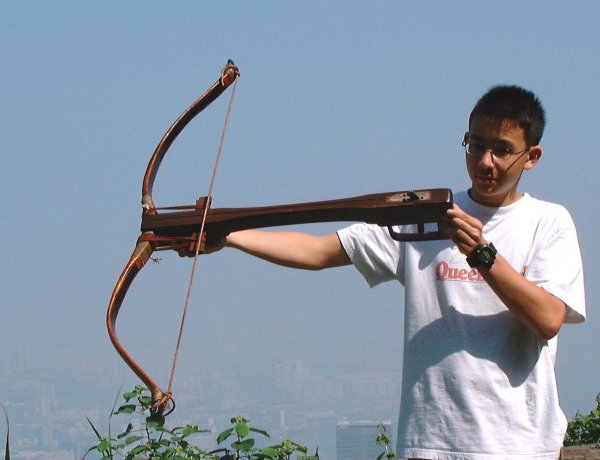 |
 |

There's a good chance we'll be able to manufacture this crossbow commercially at a reasonable price when we've got the kinks out. Obviously, we don't plan to equip every one with an original Han dynasty crossbow mechanism so we'll have to enquire about having the bronze mechansims manufactured for us at a reasonable price. The original mechanisms were cast and then hand-finished; but today it would seem preferable to mill them.
Please let me know if you have any advice on this project, so that we can get the crossbows really good.
Talking of crossbow mechanisms, a few mechanisms have turned up in North China which, on the basis of style and calligraphy of the inscriptions, appear to be Tang. The sight feature on all the specimens is in the shape of a stylized lion. The latch and trigger have turned up, although I have not yet seen a lock or the axles. I show the items below (if the image is too small, download to your terminal by right-clicking the image, and blow them up with your own graphics software. I will not claim copyright on them.)
Latch and trigger |
Details of the decoration |
Reconstruction of the whole mechanism |
An interesting feature of the latch is that all three specimens I have obtained have pits gouged from the sides as if to make them balance properly. One mechanism bares the maker's mark 'Er yu' while the other one has the mark 'Zeng'.
Please let me know if you have seen such mechanisms before, and any information you have on them.
February 2000
A Writer’s Dilemma
or
"I thought they all had Ninjas"
by
Gwen Huskins
I am the first to admit that historic fiction of any sort is a great challenge. Woe to any author who mixes names or locations. However, it seems to me that any historic fiction that does not take place in Britain or North America post-1066 requires extra effort. Research books are available, of course, but these for the most part ignore all but Anglo-Saxon cultures.
The Orient especially seems to be susceptible to misinformation, ignorance and to some extent, smugness. This attitude dates back hundreds of years. A good example is the self-satisfied description of opium smoking in The Historical Encyclopedia of Costume by Albert Racinet. Dr. Aileen Ribeiro points this out in her introduction. "…(Racinet was) becoming particularly indignant about the opium smoking habits of the Chinese Imperial Court: whether or not they existed, he seems to ignore the notorious involvement of the European powers in the opium trade with China."
On the opposite end are individuals whose education of Asia has come primarily from watching Karate Kid. This seems to be the most common problem here in America, thus the subtitle of this article. "Ninjas were everywhere, didn’t you know that?" is the general attitude and all other weapons of Asia that weren’t featured in Teenaged Mutant Ninja Turtles are ignored. I must admit that I was among the ignorant until recently.
The research problem I went to ATARN for was an inquiry on the Chinese repeating crossbow. This weapon is represented in movies (most notably the Shadow) and video games (most notably Age of Empires II) as a sort of medieval Chinese Uzi with the same power and destructive capabilities. It naturally never jams although that can be argued as being a cinematic necessity.
Another mistake that seems common is that even when Asian archery is represented it is assumed that European and Asian archery are exactly the same thing. This makes about as much sense as saying that since the Chinese and Europeans enjoyed silk their fashion is identical or that since Japanese and English swords are both made of steel then there is no difference between them.
The best idea for a historic novelist is to find an expert or a reputable history book and leave Hollywood out of it.
May 2000
Ju Yuan Hao also sends his greetings to ATARN Members. The son of the family, a man in his forties, has now firmly taken up the task of learning bow-making from his father.
'I am really trying to get into this,' he told me. 'I realize the weight of responsibility upon me. I feel rather like a monk who has taken vows. I am up at the flea market at five o' clock on Saturday mornings to see if there are any old broken bows about. When I can get them, I take them apart to learn how the old masters worked and then put them back together again.' (He has put a handful of old bows back into shootable condition, although some of the draw-weights are extremely heavy.)
'You probably don't realize what a challenge this is for me. In the old firm, there were a number of people involved and we outsourced a lot of activities. In the workshop in my father's day there were three or four people working on the bows, and then a number of people working on the decoration. There was a tradition of keeping these activities separate: the bowyers did not do decoration and the decorators did not make bows.'
'What's more, most of the materials came to the workshop pre-worked. We could take the parts of the horn that we wanted (just the flat, outside curve of each horn) and all the rest (save some scrap for the tips and string-bridges) went to the comb-makers' guild. For the siyahs, we needed elm wood with a slight curve to the grain. The woodsmen knew what we needed and we could always get it. Now all we can get is industrially-cut wood. You're not allowed to go around Peking cutting up trees any more.'
'Now I and my father are having to face the whole task of sourcing and selecting materials, as well as doing all the bow-making together with the decoration. That's a completely different situation from what happened in the past.'
'Another problem is that Father can't pull a bow any more, and his hearing is going. A maker of horn and sinew bows has to be able to hear the bow as it is pulled. Imminent failure carries warning sounds, and you can detect defects by tapping the limbs. But father can't tell me what to listen out for any more, so we sometimes have some dangerous catastrophes. I'm learning to pull a bow now: I can already manage fifty pounds.'
In a Peking antique market, I had an exciting find: a little iron model bow and arrow.
Liao model bow. Arrow shaft in front of the string: 3.8 cm.
Height: 11.7 cm. Max width of limbs: 0.65 cm.
This seems to be a Liao (Khitan) burial item dating from around 12th Century. The Khitans were the political predecessors of the Mongols whose name gave rise to the word 'Cathay'. This little bow was once gilded and a lot of attention seems to have been given to detail. The grip and the relative thickness of the limbs look convincing, as does the twisted rawhide (or gut) string. The arrowhead is typical of the Liao iron arrowheads I find in Peking. In the model, the arrow nock is a ring which fixes the arrow so that it can swing on the string. The arrow is triple-fletched. Ju Yuan Hao will make a full-size replica.
July 2000
I've been on the move again, and I'm holding down two jobs here, so time is hard to find. Anyway, my schoolteachers never accepted such lame excuses, and I expect you won't either.
I found an interesting bow in London. An antique dealer had had a Japanese yumi in his shop for months and couldn't shift it because it was too big for anyone to want to take it away. Originally he had two: one, dated 1737 in traditional Japanese dating, was a fine, lacquered bow and very valuable. The other was a much plainer bamboo-wood composite yumi of no great age. Finally, he let me have it at a knock-down price and it came in the luggage hold to Hong Kong.
A member asked me the other day how I take big bows by plane. Actually, I've done it a few times. Never box them up. Although it looks safe, airport staff have no respect for anything in an anonymous box, and serious damage may ensue. Instead, wrap the bow (unstrung) in several layers of bubble-wrap, paying special attention to the bow-tips, grip and string bridges if they are present. Let the 'bow shape' be visible to anyone looking at it. Check into the luggage hold, but as airline staff to put a 'fragile' sticker on it. I have had no accidents yet like this. (Don't try to take arrows as hand luggage: it sends security staff into a spin.)
Back to the yumi. When I got it back, I read off the Japanese maker's name and sent off a query to eClay and Yoshiko Buchanan.
They came back with the exciting news that the bow was a special one made by one
of Japan's leading recent bowyers, Higo Saburo. Higo made a number of special
bows that he was in the habit of giving away to valued friends and eminent
archers. eClay says that Higo made up a proverb saying that the archer should
"listen for the frost climbing up the ridgepole of a traditional Japanese
hut." That was a reference to the subtle cracking that a Japanese archer's
glove gives out as the string is drawn back.
To show my gratitude, I am presenting Members with a copy of something else Japanese that I picked up in London's antique shops: two magnificent Ukio-e ('floating world') woodblock prints of Japanese archery by the artist Chikanobu (1838 - 1912).
The prints, dated the second lunar month of Meiji 30 (spring 1898), depict Japanese archery games on foot and on horseback.
I donate these reproductions into the public domain, so members can copy them and distribute them freely (and turn them into Windows wallpaper!)
Target Archery with the Yumi. Woodblock print by Chikanobu, 1898
Horseback archery with the Yumi. Shooting at a running dog with a whistling
arrow. Woodblock print by Chikanobu, 1898
October 2000
Hasman Shah Bin Abdullah is a professor at the Universiti Teknologi MARA in Selangor, Malaysia. Over dinner, we discussed traditional archery and he came up with the following story.
"When I was a kid in Segamet, Malaysia in 1968-69, there was an old Tamil man who worked with the Public Works Department. We just called him 'uncle' in Tamil - I don't know what his real name was. Anyway, he used to make bows and shoot pellets from them. I and the other kids used to help him. We would go into the jungle to collect bamboo, and then he would cut the bamboo and soak it for some time in a mixture of three kinds of oil. I can't remember what oils they were, but I think one was something we called 'salajeeth'.
 |
"After soaking the bamboo, he would
put it in a container and bury it under the ground for a few weeks. When he dug
it up again, it was ready for the nocks to be cut. Then we would go into the
jungle again to search for the bark of a certain type of tree. When the bark was
dried out and beaten, it made an excellent bowstring. The strings would be
formed in a parallel pair with a basket woven in the middle to take the
pebble. The bows were too strong for us to brace: Uncle would brace them after
taking a few deep breaths to prepare himself for the effort.
"Uncle used to make pellets out of baked clay. We children were not allowed to shoot with these pellet bows. "If you don't know how to shoot properly with these bows, the pellets will shatter your knuckles," Uncle used to warn us. We used to have flying foxes (a type of fruit bat) in Segamet and Uncle could take one down with his pebble bows." Left: A White Karen from Northern Siam (Thailand) shooting with a stonebow. See picture archive. |
I took off a Saturday from a business meeting in Geneva to visit the workshop of Patrice Canale in Bordeaux, France. Patrice has been making a variety of traditional bows in modern materials and his repertoire includes Mongol-style bows. We spent and afternoon examining a couple of old, broken Chinese bows I had taken with me we shall try to see whether he can reproduce one in modern glass fibre.
Bordeaux is a beautiful city close to outstanding deer and boar hunting country. If you are interested in one of Patrice's Mongol bows, you can contact him at his firm, Euro Archery. (euro.archery@wanadoo.fr)
Sorry to come back to Chinese things; but some interesting old bows have been coming to me from Gansu Province in West China recently. Gansu is a dry province adjacent to Tibet, and it seems that bows are better preserved there than in Peking, partly because of the climate and partly because many people there still know about how to look after bows. One bow I recently obtained was an old, damaged Child's bow. The measurement from tip to tip along the limbs is just 123.5 cm. It is exactly two-thirds the size of a standard adult's bow of the same proportion and design, and perfectly made in the traditional way with horn and sinew, and decorated with lacquered birch bark.

Qing Dynasty Chinese half-size child's bow (123.5 cm from tip to tip along the
limbs)
Unfortunately, the bow is quite damaged. One of the horn tips has broken off and the wood has been squared at the break and a new tip carved into the siyah an inch or so below it, so that the length of the siyahs now differs by about one inch. (I have seen this sort of patch-up in many Chinese and Mongolian bows.) In the illustration above, I have used the computer to restore it to its original appearance. Based on a standard brace height, a Chinese bow has a string length between nocks approximately 0.855 of its length measured along the limbs. Therefore, the string length of the child's bow was approximately 105.5 cm.
I had the pleasure of interviewing
Zhang Shaojie, a performing artist who has devoted his life to performing feats
developed from the old military examination system. His performances included
weightlifting, pulling heavy bows and shooting with the pellet-bow.
Zhang is the fourth generation of performers and he is very well-known in China. From his great grandfather, Zhang Yushan, through his grandfather, Zhang Baozhong, and father Zhang Yingjie, he has developed performing skills based on the feats that candidates for the military examinations in the Qing Dynasty had to perform.
"We had our own performing troupe and a medicine shop as well. We used to perform in the streets behind the Temple of Heaven and sell our medicines to crowds attracted to our bow-pulling acts," recalls Zhang. Later on, we formed into a proper performing troupe in a circus performance. We had bows of over 100 pounds draw-weight and we performed feats of strength with several of these bows linked together."
"Another act was lifting a heavy stone. Actually, the stones were horse-mounting blocks called 'zhishi'. First we lifted them with two hand onto one knee, then after preparing, we lifted them high enough against our chests so that the audience could see the bottom of the stone. The we put them back on the ground."
So you thought you knew what a 'bow knot' was?
© Zhang Shaojie, 1999
"We used to make our own pellets for the pellet bow act. Everything went into them: hair, paper, lead and clay. Then we baked them hard. The act we performed required using a pellet to put out candle flames at a range of a few metres. My wife is the crack-shot at that. But now neither of us performs and we do not take on any students. It just takes too much time for practice. No-one has the time for that these days. And the other thing is, it's difficult to make an attractive stage performance out of shooting with a pellet bow."
"We used a pellet bow with two parallel strings. If the draw-weight is heavy, we can use a thumbring. You draw the string back to the corner of the right eye and aim over the left thumb at the target. As you release, you twist your left hand outward slightly to avoid hitting your thumb. Hitting you thumb is called 'jiao mer' ('calling out at the doorstep'). We couldn't take bows made in North China down to the south because of the humidity. My grandfather used to get lacquered southern bows made in Fujian."
Zhang Shaojie pulling a heavy bow during a performance. © Zhang Shaojie, 1999.
Zhang Shaojie is preparing to recreate his act for the symposium in May. He asked me what he would have to do to join ATARN. He was surprise to learn that anyone who regards him or herself as a traditional Asian archer is automatically am member!
A member has asked me whether I had pictures of tools used to make traditional Mongolian and Chinese Bows. When I was in Mongolia, I found that the bowyers were using western industrial tools; but with the assistance of Ju Yuan Hao, I have prepared the following group of photographs. (© Stephen Selby, 1999. Copyright reserved.)

December 2000
 As
usual, I am at a loss for anything to write about anything other than Chinese material.
But at least I'm not at a loss for Chinese material to write about.
As
usual, I am at a loss for anything to write about anything other than Chinese material.
But at least I'm not at a loss for Chinese material to write about.
This week, I have had a chance to examine some Western Han Dynasty (206 BCE - 8 CE.) archery equipment. Examining archery equipment that is over 2000 years old is an extraordinary event in the West; but in Asia, with a long history of burial of weapons interred in graves together with their owners, we occasionally get the privilege of examining such material. Last week, some Hong Kong antique dealers and collectors were patient enough to let me take photographs of interesting items. The problem with these items, of course, is that they all lack archaeological context.
The bow on the left is in fact one that I have owned for some time. I have examined carefully with a microscope. Although it has not been radiocarbon dated, I am convinced it is genuine. Dr Grayson has also inspected it and felt sure it was made by a bowmaker - not by a faker.
You have my permission to save the this, full-size image on your own hard disk, and then open it in your own graphics editor software. The view you have here is of the back of the bow. You should examine it at 1:1 scale.
The bow is 159cm long and 3.4cm and 1.4cm thick at the widest point. Looking at the descriptions of Neolithic European bows on p. 91 of 'The Traditional Bowyers' Bible', Vol. 2. (Ed. Jim Hamm, Bois d'Arc Press, 1993. ) the positioning of the grain most closely resembles that of the Holmegaard bow. Like the Holmegaard bow, there is some doubt as to which face was the back. The rounded grip suggests that the flatter side of the limbs formed the back; but the string nock is cut with a slant in a way that suggests the opposite.
The grip is cut at a point where there is a significant ring in the grain. Out along the limbs, the grain is very symmetrical. I have not been able to identify the wood. What is unusual in this specimen is that is has been preserved dry and has hardly distorted significantly in any dimension. The wood is very dense and if I strike it when it is suspended, it rings out with a clear musical tone.
I have examined many contemporary early Han images of shooting arrows with bows, and it seems clear to me that this bow would not have supported the draw-length in vogue for arrow shooting at that time. I think it more likely that this was a pebble bow, strung either singly to shoot pellets with a groove, or single- or double-strung in bamboo with a pocket. A pebble bow is only drawn to the corner of the eye, and this bow should have met that requirement (although with a prodigious draw-weight.)
Excavation of Western Han Chu tomb burials near Changsha illustrate lacquered self-bows with an identical design and length.
The Neolithic Ashcott and Holmegaard bows pre-date this specimen by some 2000 years. The similarity of design is, however, startling. Contemporary Han pictures of bows and archery equipment do not illustrate this sort of equipment. However, even around 1300 BCE, there were oracle bone script characters denoting pellet-bows. Excavations have also uncovered pebbles with a channel sawn in one face to take a string.
Han bows used in warfare against the Huns were clearly horn/wood/sinew composites suitable for shooting on horseback. Although we see these bows depicted in stone carvings, the convention at the time was to depict things side-on. We therefore have little chance to assess any detail about the thickness of Han bows. Although I have come across accounts of Han horn bows being excavated in burials, I have never seen an original one or even a good photograph. The best approximation is the type of bow excavated from the deserts of Turkestan, (for example, the Niya bows) which are normally of late Han or Jin design. There is some doubt as to whether these bows were 'Chinese' in any sense.
So I was particularly interested to come across a terracotta high-fired Sichuan funerary military figure grasping a bow in his hands. I have two Han pottery archers, but in both cases, the bow was made of wood and has long since rotted away. The bow with the Sichuan figures, however, is modeled in terracotta. The figure and the bow are both a little stylized: for example, the curvature of the soldier's boy is exaggerated and the bow is molded to the shape of the body.
All photographs copyright Stephen Selby, 2000. All rights reserved.
 |
 |
In these photographs, one is immediately struck by the breadth of the limbs. This bow is hardly different from a nineteenth century Indo-Persian bow that I have. The segmented band visible behind the bow does not seem to be a string. It is either a strap on the soldier's uniform, or some other device such as a bag for the bow.
Is the bow strung? Perhaps not. There is no sign of a string, and without any sign of string bridges, the alignment of the siyahs is rather unlikely for a strung bow. The general appearance of the soldier is more at ceremonial attention than in a battle position, so it is possible that he would have had his bow un-strung. (I have noticed that the Mongolians were always un-stringing their bows in warm weather as soon as they had finished a round of shooting.)
My final report is of a fine, late Warring States Period (c. 250 BCE) lacquered crossbow.

Warring States Crossbow: Side View. bout 65cm

Warring States Crossbow: Side View

Top view

Release mechanism housing

Seating for prod and peg for prod binding

Decoration forward of finger grip molding

Finger grip molding

Top of latch with bone or ivory arrow-guide

Front of stock with binding pegs for the prod
This crossbow is exceptionally well-preserved. The prod is not present and probably never was. The crossbow was in a basket, minus prod, accompanied by a small wooden box with partitions of a size that might have held quarrels (but there were no quarrels in it.) All the items are completely waterlogged. The latch, however, is made of non-corroding bronze and still moves freely.
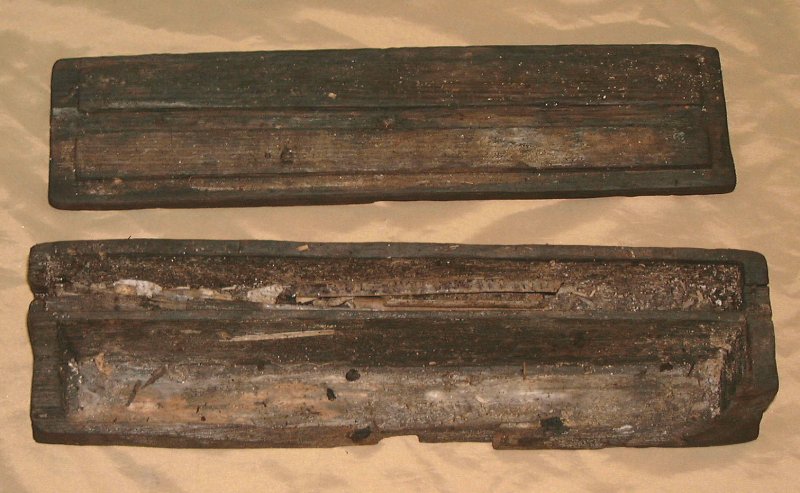
The wooden box excavated with the crossbow
Artistically, the painting on the lacquer is more reminiscent of early Han decoration, but the design of the mechanism is more archaic, lacking a bronze casing. The floor of the arrow guide surrounding the latch is made of bone. The channel of the arrow-guide is also lined with bone or ivory. Strangely, there is a corresponding channel on the underside of the stock.
I can only speculate on the composition of the prod. It is might have been horn and sinew. Other alternatives would have been a self prod or a number of layers of bamboo. There is no sign of ware. This crossbow has probably never been fired.
January 2001
 In
China, it is the custom to celebrate the lunar new year (Wednesday 24 January is
the first day of the Year of the Snake) by cleaning and decorating the house and
putting up auspicious new year pictures.
In
China, it is the custom to celebrate the lunar new year (Wednesday 24 January is
the first day of the Year of the Snake) by cleaning and decorating the house and
putting up auspicious new year pictures.
The new year picture on the left is a typical example, although it is unusual. It is a scroll painting which, I should say, dates from the late Qing Dynasty (around the end of the 19th Century) and a slip of paper bears the note "Master Zhang shoots the heavenly dog."
Who was 'Master Zhang'? He seems to have been the same person as 'Zhang the Immortal' (Zhang Xian) who was known from an account dating from the Song Dynasty. Meng Chang set himself up as overlord of the Later Shu kingdom. He took as his concubine the lovely "Lady Flower Stamen".
Meng Chang was defeated in 965 and his concubine was captured and taken to the Palace of the first Song Emperor, Tai Zu. She remained faithful to her husband and kept a painting of him pulling a bow and holding a pellet in his fingers. She hung the painting on the wall of her chamber and made offerings to it each day. When asked by the Emperor why she revered the painting, she deceived him by forging one of the characters of the title . claiming it was a picture of "Immortal Zhang", and that praying to it would make her bear sons. The picture later became the subject of folklore and was used as a symbol of bearing sons.

That is obviously the intent behind this painting, with all the young boys milling about his feet. But I have never seen any mention of him shooting at a dog. Is the black dog the cause a lunar eclipse? (A lunar eclipse is capable of making the moon turn red.)
If you look carefully , you will see that the bow is clearly a pebble bow with a double string, (and, indeed, there is no arrow to be seen.) In the enlargement on the right, you can see that he has a pellet held between his fingers at the grip, ready for the next shot.
February 2001
As a feature for this month, I thought I would show some pictures of Mongol/Khitan/Turkik bows from the first 300 years of the last millennium. That is, the bows that were current in the northern part of what is now China in the period from about 1000 - 1350 of the Common Era.
Last year, I showed a photograph of a bronze, model Liao bow.
This little model represents a bow that seems to have been coming into vogue in the Liao-Jin period, around 1000 CE. But this design may have been supplanting another popular design that is depicted quite consistently in artwork dating between the start of the Tang Dynasty and the end of the Song. It may even have had its antecedents in the Niya bows. The distinctive feature of the design was a relatively short working limb with very long, massive siyahs.

Another notable feature of the design is the depth of set-back of the grip, but with a very straight section at the grip itself. The siyahs are very long, starting from where the V-shaped patterning on the woodblock print (perhaps representing birch bark) stops. These bows required no string bridges and are reminiscent of the reconstruction of the Avar bow done by Fabian Gyula.
In fact, if you go back to my reconstruction of the Niya bow (almost 1,000 years earlier), the resemblance is rather striking.
We can see this design in the following images.
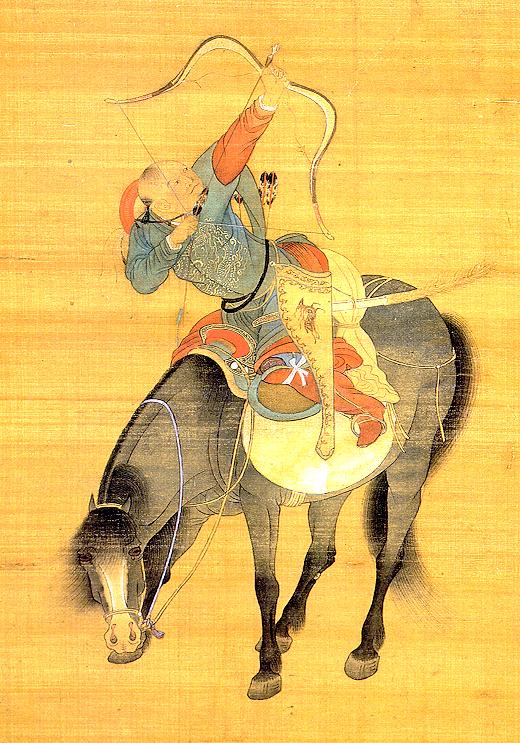
Five Dynasties (900-980)
Song. Chen Juzhong
From the preceding images, we can gather that the short, working part of the limb was quite massive and probably broad. The image of part of Liu Guandao's painting, with the servant of Khublai Khan preparing to shoot into the air, has one other strange feature: a fine thread running from the upper to the lower limb inside the string. When he releases, that thread is going to snap taut and the archer is either going to get a nasty cut across his palm, or else the bow will jump forward out of his grip. Anyway, that's his problem, not mine.
This month I am trying out the dangerous exercise of trying to shoot two birds with one pellet. The first 'bird' is to pass on some of my experiences of 'tradition' as it affects Asian archery. The other 'bird' is to introduce some Tibetan bows from Qinghai.

Buryat Traditional Archery near Hailar Banner, Inner Mongolia (Courtesy of © Jin Xiaofang) |
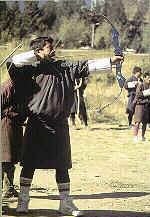
Bhutanese traditional archery (courtesy of ' © Tashi Delek', In-flight magazine of Druk Air) |
In the West, there is a lot of legitimate interest in the 're-creationist' aspect of traditional archery. But in the more distant parts of inner Asia where traditional archery remains a native tradition, I find few interested in faithfully recreating the past either in terms of equipment or in terms of technique.

Buryat Traditional 'cloth dragon' target (Courtesy of Jin Xiaofang)
A lot has to do with economics. Look at the three photographs above. There is no doubt in my mind that these activities are 'traditional', despite the fact that the archers have (a) obtained western bows and (b) adapted their style to the demands of western bows. Would these archers prefer 'traditional' bows? I don't know. Some will say that they would prefer traditional bamboo or horn and sinew bows, but they can't get them any more. Why can't they get them? Because no-one is making them. Why isn't anyone making them? Because the market for them is too small.
This slightly circular argument may obscure another point: many Asian traditional archers may grudgingly admit (although not to me) that western bows made with modern materials can be more accurate and consistent. Although many traditional archery practices are not primarily concerned with hitting the target, archers who miss do lose face in public. From attending some of these traditional events, it is clear that regularly but elegantly missing the target is not on the agenda. Once one archer has adopted western bows, what are the others to do?
An additional element is the investment of time and resources in maintaining bows and arrows made of traditional materials. Extremes of temperature and humidity affect such equipment greatly. In days gone by, when the bow was constantly at the nomads' sides, it was easier to keep them under constant minor maintenance. Now that they are not called upon other than for traditional sporting events, and are laid-up for long periods of time, looking after them has become more difficult.
There are exceptions, of course. In outer Mongolia, where archery is one of the 'three manly sports' at the national-level Nadam competition, traditional equipment, targets, costumes and songs are all de rigueur. The traditional technique, however, is largely optional. The bows discussed below also reveal a dedication to traditional equipment in Northern Tibet.
Why do Central Asian people persist with any traditional element in their archery, then? The answer does not seem to lie either in any nationalistic feeling of superiority about their equipment or their techniques. Rather, it seems to be to do with asserting a part of their national characteristic represented by archery. When I look further-afield to Korea and Japan, a different picture emerges: these two great archery traditions incorporate a layer of influence from China in which competition is secondary and ritual detail is an important element of the overall procedure.
March 2001
In recent months, ATARN Member Xu Kaicai (a Chinese national archery coach who travels very widely in China) has drawn my attention to some fine traditional bows from Haixi (Tib. Tsonub) Prefecture of Qinghai Province, West China. These bows are made and used by the Tibetan nationality.
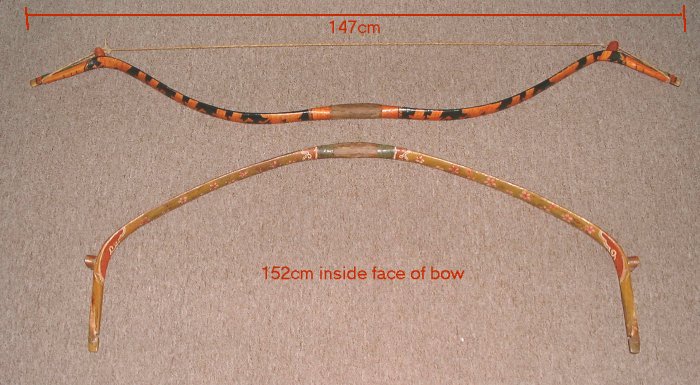
Two modern Tibetan horn/sinew bows from Haixi Prefecture, Qinghai Province,
China.
These two bows are close to Chinese and Manchu bows in their construction, although they are much smaller. The ethnic mix in Haixi Prefecture, Qinghai is complex, both because of a longtime population of Mongols and Tibetans in the region as well as due to forced emigration of Mongols from Inner Mongolia to Qinghai and Gansu at the time of Sino-Soviet tension in the late 1950s.
The bow is smaller than the 'women's size' bows now used in Khalkha regions of Outer Mongolia.

Limb detail and decoration
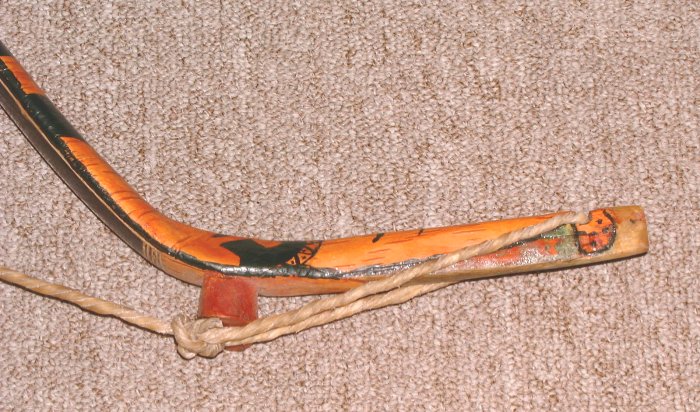
Siyah detail and decoration. Note the rawhide string.
The bow-tip and string nock reinforcement is in white sheep's horn. The string
bridge is made of wood.

Grip detail. The grip is covered with an unidentified vegetable bark or pith.

Decoration near the grip. All decoration is applied with a black lacquer
paint over natural birch bark.
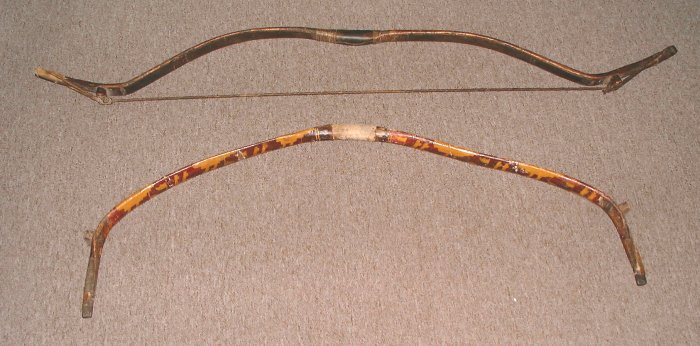
Antique bows of a similar design. The upper bow is over 100 years old. The
lower one is around 60 years old.

Modern arrows accompanying the bows. Length (nock to base of point) 78cm.
Point: 2cm. The arrows are barreled: 7mmØ at the base of the tip, 10mmØ in
the middle and 5mmØ at the base of the bulb nock.

Details of the arrow decoration. Cresting in coloured silk with lacquer
covering. Shaft decoration in peach bark.
When I talk of these bows being 'made' I am being slightly misleading. The four specimens I have examined (both new and antique) are all made with horn recycled from older bows. I would hazard a guess that in all the cases, the horn came from Chinese bows made in Peking or West China because the dimensions of the horn are identical to those of Chinese mounted archery bows.
The top bow in the first photograph is clearly brand-new. The construction is very sound and the quality of the materials and decoration is superior to modern bows now being made in Mongolia. The draw-weight has not been measured, but it seems to be around 60 pounds (27kg) at 28 inches (71cm).
In terms of decoration, all the bows show strong Chinese influences. The lower bow on the first photograph is decorated with a medlar blossom design (hai tang) - the Chinese rebus for 'elevated rank'. Other decorative elements such as the use of ray skin on the arrow-pass and the key-pattern near the grip are also Chinese. The oldest of the bows has the Chinese character 'wang' ('king') impressed in the horn tip. This may indicate a Chinese bowyer; but 'wang' can also be a sinification for certain Tibetan names.

Are these the bows represented in this illustration from the 1930s? The way
the string is attached to the limb below the siyah cannot be accurate. (Public
domain photo)
The older bow also has repairs done with sinew tightly wound around weak points in the limbs, as well as a wooden build-out below the string-nock to correct a slight twist in the limb. I am told that the oldest bow was the property of a Lama and was shot up until recently in religious sports festivals.
The arrows are almost more impressive than the bows. They are made of wood (probably a common scrub wood known in Chinese as 'liu dao mu' ('six channel wood'.) They are skillfully barrelled and a lot of effort has gone into decoration and finishing. They each have a forged and filed iron tip and an bulb nock.
Two things to say in conclusion. First, there is a fine bowyer out there in Haixi prefecture. I hope to be able to meet him sometime. Second, these bows (and indeed many bows that I have collected) demonstrate the importance of re-cycling of materials in traditional bow construction. I have one Qing bow, which incorporates wood in the siyah bearing a date of the Yongle period of the Ming Dynasty (1403-1424). As there is nothing to make me suspect that the inscription is a fake and the bow is clearly of Qing design, it is likely that the inscription is on a re-cycled part. In many other bows, the horn is of greater antiquity than the wood or the decoration.
April 2001
Members and guests of the Hu Rim Jung Archery Club
My Easter holiday this year with my wife and children took my to Kyongju, South Korea, where we visited Tom Duvernay. This was my second trip to Kyongju, the old capital city of Korea in the Silla Period. My whole family were overwhelmed by the friendliness and generosity of the Korean People (including Tom Duvernay, who - at least in archery terms - should be regarded as an honorary Korean.)
We spent a couple of afternoons at the Hou Rim Jung ('Tiger Forest Archery Club') and I had a chance to study Korean technique close-up. As Tom has already explained in detail elsewhere on ATARN, Korean archery is an ancient tradition with its own styles and precepts, many of which were influenced by China.
The archery range itself is 145 metres in length, commanded by a stone with an inscription in Chinese saying 'Silence During Archery Practice'. This precept is rather honoured in the breach; although things are not allowed to get too rowdy.
There
are three big targets and one small one. A hit anywhere on the big targets is
enough to score (greeted with the comment 'guan juhng' from the judge.) If you hit
the small target, though, you have to pay a fine of 10,000 Korean Won (a bit
over US$8).
In another informal game, players put KW1,000 (a dime) into a Kitty and then try to hit the small target. Anyone who hits takes KW1,000 from the kitty as his prize.
In more formal competitions, a judge sits at a raised table and the archers take their places at fixed positions. Each one shoots in turn as the judge calls his name until they have all shot a round of five arrows.
Shooting at this distance is a wonderful experience for someone like me, hemmed in by the confines of crowded Hong Kong!
Techniques vary a bit, with different archers varying in their stance. Some
position the arrow under the jaw with the string tight against the cheek, while
others keep the string well clear of their faces. All the archers use the
Mongolian draw, although left or right handed shooting is permitted.
|
|
|
During my stay, I visited Kyongju's renowned fletcher and bowyer.
Master fletcher Choi Geum Dong started his apprenticeship at the age of 17 and studied for ten years.
|
|
|
|
Choi obtains his arrow bamboo from the northern part of South Korea, cut into shafts of about one metre. After curing, the shafts are tipped with brass blunts and a wooden nock is inserted and bound forward of the nock with sinew. Before adding the pheasant feather fletch, Choi has to painstakingly straighten each arrow after heating it over a gas flame.
Master Bowyer Park Gihk Hwan's work has been well-documented in Tom Duvernay's film. Apart from providing a steady supply of beautifully-crafted horn bows, he is trying to create replicas of variant traditional Korean bows such as those presented by the King to generals on ceremonial occasions. He has even ventured into reproductions of Chinese bows.
|
|
|
A special tip from the master bowyer helps to prevent splitting along the grain of the bamboo when the V-splice of the siyah is glued in place: at the top of the V-splice cut into the bamboo, he makes a further very fine (1 mm) saw cut some two inches along the grain of the bamboo. This cut gets filled with liquid glue and helps prevent the tight binding when the bow is put aside to dry from causing the bamboo to split along the grain.
|
|
|
Korean archery is one of the strongest national archery traditions remaining in Asia today. The number of participants is swelling with the inclusion of university students among its practitioners, and this assures trade for traditional horn bowyers and fletchers (augmented by a brisk business in replicas made with artificial materials for novices to learn on.) The Korean Equestrian Association in Seoul boasts a team of horseback archers.
OBITUARY
It is with regret that I report the death in January 2001 after a short illness of Dr. D. Batchuluun, professor of sports medicine at the Mongolian State Sports Institute and a member of ATARN.

Dr. D. Batchuluun (standing on the left)
Dr. Batchuluun was a Mongolian national of Chinese descent who was a fluent reader of Classical Mongolian, Tibetan, Chinese, Russian and English. He was actively involved in research on inner Asian traditional herbal medicine.
It was Batchuluun's firm grasp of the English language and deep knowledge of Mongolian traditional archery that enabled me to bring detailed information about Mongolian archery to ATARN's pages and to Instinctive Archer Magazine. During my visits to Mongolia, he gave up many days of his time to accompany me around the country and interpret the explanations of bowyers and practitioners of Mongolian archery.
Dr. Batchuluun leaves a wife and teenage daughter.
May 2001
This letter announces a new article on Two Turkish Bows by Adam Karpowicz. The article describes two working reproductions of Turkish infantry bows that Adam made.
I thought I would add some photographs of an old Turkish bow made in about 1837. The length of the bow (measured along the limb from string nock to string nock) is 106cm.

The whole bow. 106cm string-nock to string-nock

Side view of grip

Decoration on back of bow limb

Detail of limb decoration

Bow tip with bone insert at the string nock and gilt decoration

'Chelik' or bone insert at grip between horn sections. (Note deliberate
roughening of the horn)

Horn belly of the bow limb. (Note deliberate roughening of the horn)

Signature of the bowyer, 'Ali Kawwsi'

Date (1837 in the Western Calendar.)
At first I was puzzled that a bow with such an artistic finish would have such crude roughening of the horn belly of the limbs. But perhaps the roughening is there for a specific purpose: to reduce glare from bright sunlight, which could impair the archer's aim. I checked using a Korean horn bow and found that at some angles, with the sun behind the archer, there can be an annoying glare.
Alternatively, is there any stricture in Islamic law against mirrors where the human face can be seen? Please would Muslim Members of ATARN let me know?
July 2001
Kay and Jaap Koppedreyer are back from Bhutan and Kay is promising us an article on Bhutanese archery and bow-making. I'm just putting this down on record so that she can't back out. As an encouragement, Kay, here's a nice picture of Himalayan archery - this is Dhanma, General to King Gesar of Hor, practicing a bit of horseback archery (Tibetan, around 1955.) I bought this painting in Edinburgh in the 1970s. It used to belong to the Tibet Scholar, Charles G. Bell.
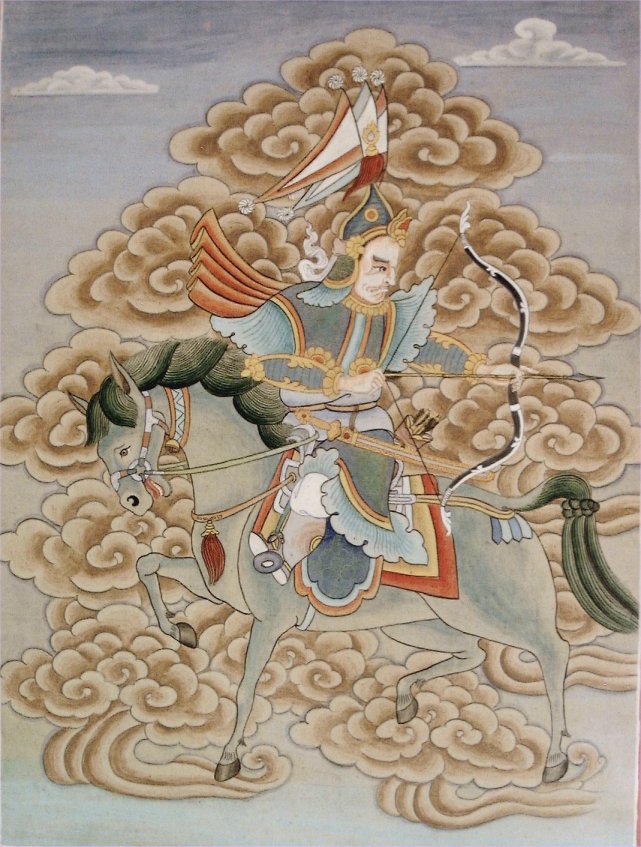
September 2001
My holiday in North Wales was spiced up by meeting with a group of traditional archers at Llanbedrog, led by Nigel Burras. Nigel was my earliest archery teacher and he took an instant liking to my little Korean FRP bow supplied by Tom Duvernay. We ended up doing a swap: my Korean bow for a working reproduction of my Han Dynasty Chinese longbow. It shoots at about 50# drawn to 28".

Copy of a Han longbow by Nigel Burras of Llanbedrog
After coming back, I had some email correspondence with Jang Yuhua from Taiwan, who collects and shoots traditional Chinese bows.
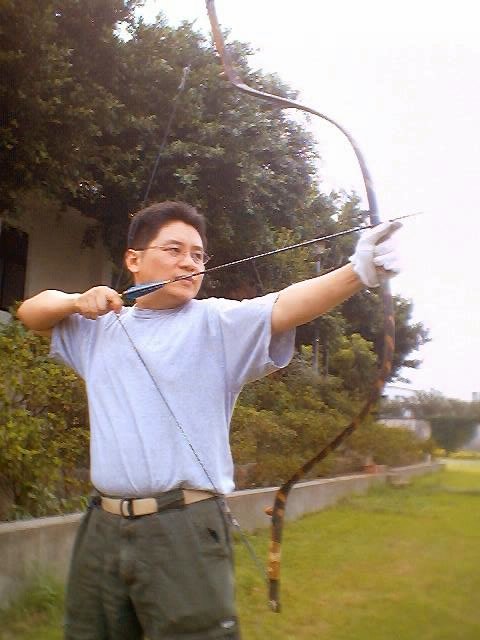
Jang Yuhua of Taiwan with an old Chinese horn bow
We were swapping some experiences with bracing heavy Chinese bows and dealing with twists. Yuhua kindly agreed that we would share this correspondence with other ATARN Members. Here it is -
Yuhua:
Stephen, I'm afraid that I can not make it to FD this year. I have hurt my back big time by trying to string a very heavy bow(100#+) by the "Korean" method.I should get some "stringing device" for my heavy bows; but I don't know what kind of device the Chinese used. Right now the only thing I can do is to carry the heavier bows to the range and use a device there to string them and shoot them. The device is made from steel and is for use with modern recurve bows to measure the length of bow string. It's just not designed for the "C" shape of horn bows. Although I could easily pull a 100# Chinese bow, there was just no way to get it strung.
Best Regards
Jang,Yuhua
Stephen: Dear Yuhua,
I'm so sorry you can't come to FD: I had looked forward to meeting you.
You should not string a heavy bow like that. You must use two people, a bench
and 'gong nazi' for stringing. Look at this old photograph to get an idea of the
method.
Here is a 'posed' picture of me using a bench and 'gong-nazi (tipliks) to prepare Chinese bows for stringing:

Remember that the very heavy bows ('hao gong') were not intended to shoot
arrows. They are only for drawing in the examinations.
Yuhua: From my experience a "C" shape horn bow with long
siyahs did draw much easier than a bow with short siyahs. It is so smooth you
can't feel much stacking. The force needed to draw it is pretty much the same
all the way through. It's a bit like a compound bow, yet much smoother than
that. For example, the "C" shape bow in the picture is about 120#, but
it draws like a 80# modern recurve and can deliver an arrow up to 300 meters.
Quite amazing!!

Stephen: I agree. The leverage from the siyahs allows stacking to be
avoided. The profile of the monkey bow is good. When a Chinese bow is in the C
shape, it is not ready to be shot. It has to be changed to an almost straight
profile using the 'gong nazi' before it can be strung and shot.
Yuhua: Stephen, you wrote: " When a Chinese bow is in the C shape,
it is not ready to be shot. It has to be changed to an almost straight profile
using the 'gong nazi' before it can be strung and shot. "
That doesn't make any sense to me. If a C shape bow has been heated, braced for a week and becomes like an almost straight profile, for sure it will loose a lot of power and won't able to perform a power "cast". The bow would just become "tired". I wonder if a bow has been treated like that, would it ever go back to its original C shape?
Stephen: In principle, your observation is correct.
But Chinese bows (in contrast to Korean horn bows) were designed for optimal
performance from a near-straight start when un-strung. A bow that has stood
unstrung for a long time is alright to string if the siyahs have an 'open' angle
(that is, they don't point inward towards each-other.) The relaxation into a C
shape with the siyahs pointing inward is a defect that arises over time from
excessive drying and shrinkage of the sinew. Over the winter, Mongolian nomads
leave their bows unstrung in a hut with frozen meat so that they will not become
too dried out. Shooting a Chinese or Mongolian bow from a C condition means that
the bow is performing at a heavier weight that the siyahs were designed to
stand, and risks over-stressing the sinew as well. (This information came from
Ju Yuan Hao.)
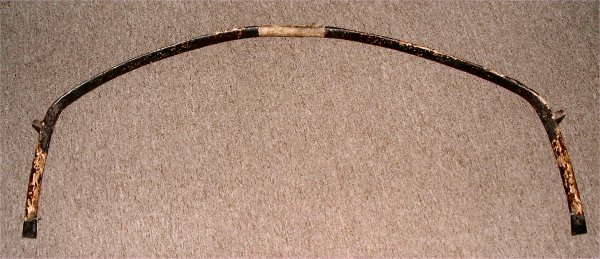
Of course, the bow should not be permanently strung.
In warm, humid conditions, the bow must be unstrung overnight and put in a
drying cupboard (pei gong xiang). In hot sunlight, even one hour may be enough
for the bow to soften below optimum performance. (Last year at Fort Dodge, in
very hot conditions, Munkhtesteg and Enkhbaatar unstrung their bows after every
round.) In the north, with cooler, drier weather, a light bow can be left strung
for a week, a heavy bow may be left strung for a whole season (if it does not
twist), and a strength bow used by a qigong master might not be unstrung for a
very long time, because it is such a nuisance to re-string it (as you have
discovered!).
Your concern about bows becoming tired and taking a set (following the string) are more relevant for wooden self bows or bows made with modern artificial materials. Chinese horn bows are much more tolerant.
Of course, one thing you must NOT do is to apply
force to bend the bow in the wrong direction. Doing that will split the bow at
the grip. Most of the Chinese bows I see have been damaged in this way, or by
being heated too much.
Yuhua: Thank you for the information. I could save some of my bows from
snapping at the siyahs in the future.
The other problem that bothers me is the twist problem. The way I deal with
it is to heat a strung bow then adjust it by hand. Is that correct? Or is there
some other ways to adjust it? Because a bow usually tends to go back to its
original twist angle after several weeks of use, I have to go through the
process over again. Each bow seems to have its own temper.
Stephen: Twist is a pain. Most of these natural bows are not perfect when
they were made, and you just have to live with their 'bad habits'. Often, the
twist is permanent, caused by a fault in the materials or uneven drying of the
glues.
I think you should heat the bow and remove the twist when the bow is unstrung.
The Mongolians have a special way of dealing with twist. They insert a 1/4" wooden rod across the angle of the limb and the siyah inside the loop of the string and fix it with tape. When strung, the rod can push the limb back against the direction of the twist. Another method I have seen on a horn bow from Tibet is to insert a ¼" slip of wood about 2½" long inside the loop against the string nock, with the aim again of distorting the strung bow against the twist.

1/4" dowel inserted into a Mongolian bow to
correct a twist (side view)

1/4" dowel inserted into a Mongolian bow to correct a
twist (front view)
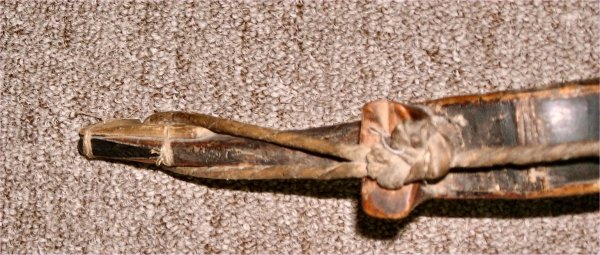
Sliver of wood attached to a Tibetan bow to correct twist.
Another piece is attached at the opposite side of the other bow-tip.
Note than with the Mongolian and Tibetan solutions, the bow can be shot while the remedial measure is in place. The Koreans use a completely different method for stringing and fixing twists in their horn bows. The methods described above are definitely unsuitable for Korean horn bows.
October 2001
I was at 40,000 feet over the Pacific Ocean on 11 September when four hijacked jetliners were used to attack the United States with such terrible effect. Our hearts go out to the bereaved families from 22 countries - and particularly those from the United States which suffered the worst losses.
Was it sheer coincidence that as these events unfolded I was reading of another terror attack, unprecedented at its time - the attacks of the Huns on Eastern Europe and Russia in 395AD? 'The World of the Huns' by Otto J. Maenchen-Helfen (Berkley, 1973) offers interesting material for those who like to read lessons from history. The Huns were poorly understood (and remain so.) No-one at the time could fathom their motivation: 'gratulabantur mortuis et vivos plangent.' (Glorying in the dead and lamenting the living.)
The Prophet, Muhammad, who possessed three bows, taught that skill in archery was a religious obligation (as reflected in sura viii. 62.) Some Islamic authors relate how the Archangel Gabriel had taught Adam that the bow is the power of God, the string is the might of God and the arrow the punishment of God. Chinese writers of the same period expressed the view that no man, while of sound body and mind, should ever give up the practice of archery. Laws to similar effect came into force at the time of English King Henry VIII. Countless other civilizations must have expressed the same idea in some way or other.
The tradition of archery has the potential to bring together people from all over the world. The most extreme exponents of Islam to the most moderate can choose to respect it, as, for that matter, can the people of North Korea or the USA.
More strident weapons of war will soon be heard before terrorism is eradicated. ATARN is dedicated to refining the bow and arrow as the weapon of peace.
The International Horse Archery Festival 2001 at Fort Dodge had the great good fortune to finish two days before 11 September. It has gained in stature and experience from the first festival last year, and careful planning with indoor facilities allowed the event to be totally successful despite poor weather at times.
This year visitors could witness the whole process of Kassai's training programme for horseback archery. The biggest surprise for many must have been that an important element of the training takes place without any horses. Kassai has developed a set of military-style archery exercises, which help the student overcome the first hurdle - the transition from a gentlemanly sport to a martial art. Such a transition is vital to developing the hand-eye co-ordination and manual dexterity needed to handle a bow and arrow on horseback.
This year saw more intensive coverage of Kyudo, with workshops, rapid shooting displays and lectures. We also gained a rare insight into the cultural significance of archery in Africa, through a lecture from Cecelia Imunu from Southern Sudan. Practitioners from the native American nations were also present to share their traditional knowledge.
I was surprised how many people were prepared to get up early and practice Qigong exercises. My early morning class also looked at the relationship between Qigong and archery, and tried out some of the basic techniques of Chinese archery.
Next year, the Third International Horseback Festival will be back at Fort Dodge. There may be some 'taster' displays of different foot archery traditions, and the organizers hope to attract some archery cultures who have not been represented at Fort Dodge before. And -as always - there will be the drama and excitement of archery on horseback!
Many of you will be excited to learn that over the weekend after Fort Dodge, I was in Peking making a film (together with the Hong Kong Museum of Coastal Defence) on China's last traditional bow-maker, Ju Yuan Hao. We had a spectacularly successful day's filming which has resulted in an hour of professional video footage, narrated by the bowyer and his son, which will be sub-titled in Chinese characters and English.
Do not expect step-by-step instructions here. We are making two films: one of just fifteen minutes for continuous showing at the new Chinese archery exhibit at the Hong Kong Museum of Coastal Defence, which will be opened in the Spring of 2002; and the other for distribution to archery enthusiasts. Both of them will look generally at the techniques and the cultural background to the bowyer's craft in China. We have covered history, social organization, raw materials, cutting with the adze, gluing of the horn, laying-down of sinew, covering with birch-bark and decorative conventions.
Ju Yuan Hao has a genius for organization and for telling his story. While you would learn more technical detail from Tom Duvernay's film of the Korean master-bowyer of Kyongju or T'an Tan Chiung's 1930s study of bow-making in Chengdu, there are some surprising new insights to be gained from Ju Yuan Hao's experiences.
For example, the Chengdu bowyer, Wu Shusen, went to some lengths to keep human bodily fluids out of the gluing process. Ju Yuan Hao, on the other hand, is convinced that human saliva is a vital element in the composition of glue. Indeed, he goes to the extent of sizing the sinew backing of a bow and the birch-bark to be applied to it with thin glue and letting them dry out first. Then he licks both thoroughly to cover them with saliva and sticks down the birch-bark like one might do when sticking a stamp on an envelope. He joked that an apprentice bow-maker has to be be prepared not only for foul smells but for the fact that bows taste bad!
Another story is a Chinese legend about the origin of archery. This story is not recorded in the Chinese classics. Ju Yuan Hao related that it was inscribed on the wall of the bowyers' temple in Peking (now demolished.)
The first Emperor, Huang Di, was travelling one day when he was confronted by a tiger. He rushed to a clump of trees and shinned up one of them. The tiger waited down below.
The tree where Huang Di had taken refuge was a wild mulberry. It's branches were strong and springy. He broke off a branch and cut it to form a bow. Then he reached over to the next tree. It was a willow and its twigs were straight. He broke off a twig, cut a nock in it and sharpened it to form an arrow. Next to it was a clump of bamboo. Its outer skin was strong and supple, so he reached over and stripped some off to make a bowstring. With this bow and arrow he shot the tiger in the eye and it ran away howling in pain. So Huang Di was able to make his escape.
The film should be cut and dubbed by April 2002. I shall make sure you are all told how to get a copy.
In London last week, I hadn't counted on the British Museum being so generous in letting visitors take photographs in the galleries, so I turned up without my trusty digital camera. Coming upon the Assyrian exhibits in Galleries 7 and 8, I realised my mistake: the wall carvings from the Palace of Ashurbanipal, King of the Assyrians in Niniveh contain a wealth of detail for archers and re-enactors. So I nipped out to the museum shop and bought a throw-away camera with a flash. Here are the photos I took.
A vassal state has made a tribute of bows and arrows.
But are the bow-limbs and arrows straight?
Looks alright. Let's get one strung up.
(Assistant on the right is preparing to fit the string over the nock.)
Shooting in battle. A guard is always on hand to protect the archer with a
shield.
We are looking at the archer's back (otherwise the draw-hand wouldn't be that
way around.) The archer is left-handed.
The archer's draw-hand
Ashurbanipal shooting on foot. Still left-handed and with a shield-bearing
bodyguard.
The archer's draw-hand. Nice wristwatch.
Two archers protected by a large shield.
Front view, and right-handed this time.
Elamite soldiers shooting down from a rampart. We are looking at the
archer's back.
Both soldiers are left-handed again. I could get to like these people.
Shooting from a kneeling position, again with a shield-bearing
bodyguard.
Left-handed archer seen from the back.
Bow-hand thumb seems to push hard against the upper limb of the bow,
with the arrow passing on the outside of the bow.
Bareback horseback archery with no stirrups.
Right-handed archer using a soft thumb-lock on the string assisted by three
fingers.
A note in the Museum said that horseback archers were each assisted by a rider
to hold the reins and pass arrows;
but I could not conclude that just from looking at the display.
Turning to shoot behind. Left-handed archer.
Ashurbanipal's palace at Niniveh was built around 645BCE. Some scenes are battle scenes showing a battle against the Arabs and the Elamite city of Hamanu during a revolt that took place from 652-648BCE. For further information, see Julian Reade: "Assyrian Sculpture". British Museum Press, 1998.
Following issue of this Newsletter, Bede Dwyer came up with a number of comments and criticisms. Here they are:
Are the archers really left-handed? The sword is worn on the left-hand side, the bow is held in the left hand and it is the palm of the right hand drawing the string. Look at where the thumbs are.
Ashurbanipal is shooting with his chest facing the viewer. That means his left hand is holding the bow and his right hand is pulling the string. The conventions of Assyrian sculptural relief were such that the hands usually maintained correct orientation to each other, but things like bow strings and arrows can disappear behind the body if they might obscure the face of the king. This is paralleled in Ancient Egyptian art too.
You have perceptively noted a "soft thumb lock assisted by three fingers", which is the standard way of representing a drawing hand from the front. Your left-handed archers are actually right-handed archers drawing past the back of their heads. The string and finger position is always shown accurately from behind, but rarely from the front. Your photos give examples of this.
Various theories have been advanced for the front view of the hand as being a Tertiary Release as described by Morse, but some reliefs show that particular finger position with the archer holding arrows vertically in the drawing hand. There are only two easy ways to do this: one involves holding the arrows with the little and ring fingers as do the Japanese, but that would require those fingers to be closed; the other is a Mediterranean Release with the thumb used to hold the spare arrows against the palm. If you tried this latter method with a Tertiary Release, you would drop the spare arrows as you released.
I once spent months going through hundreds of figures of archers in photos to establish some sort of statistical analysis of the hand positions in Assyrian sculpture. I originally thought the Assyrians used the thumb draw. Many people advanced that theory. Then I found Morse and progressed to the Tertiary Release where the thumb and curled forefinger hold the arrow nock on the string while the three other fingers pull directly on the string. However, the arrows held in the drawing hand and the fact that all archers shown from behind, where their hands were visible, have a three- or four-finger Mediterranean grip on the string forced me to believe that all the archers are using the same technique. The only thing that changes is how the artist represents it from different directions. I think that the bent index finger shows the separation necessary for the arrow nock, exaggerated to be sure. There is a technique of the Mediterranean Release where the tips of the fingers lie diagonally across the string. The bow string is sometimes under the fingers and sometimes in front of them.
Incidentally, it is easy to draw thirty-four to forty inches with one of those triangular composite bows. The one I tried made by David Betteridge did not stack at all and shot smoothly and accurately.
To continue the note of whimsy you introduced about the wristwatch, look for the "chopsticks" in the king's sash! In reality, they represent styli or small knives.
November 2001
The bows of India, Pakistan, Kashmir, Sikkim, Bangala Desh and Sri Lanka ('South Asia') are rapidly disappearing from their home environments. I have collected a few of them for our future museum exhibit in Hong Kong. Here are a set of photographs contrasting the construction of an 'Indo-Persian' bow from Kashmir thought to date from the early 19th Century, with a Sinhalese bow from Sri Lanka thought to date from the same time.
Both bows are clearly from an aristocratic background, as can be judged from their rich decoration.
This bow is 135cm measured along the belly from tip to tip. The maximum breadth of the limb is 4.5cm. It is a wood-horn-sinew bow with a thin leather covering along the working part of the limb. The leather is richly decorated in cream, black, red and gold paint, and then lacquered. The designs include geometrical patterns, peach blossom and chrysanthemums. The siyahs are made of an unidentified wood with sinew support. There are no horn inserts in the nocks. Sinew extends along the whole siyah up to one centimeter below the string nocks. The grip is strongly set-back and oval in section. There is a 1-cm sinew binding around the siyah where the longitudinal sinew coating ends. No inscription is visible. There are two original arrows.
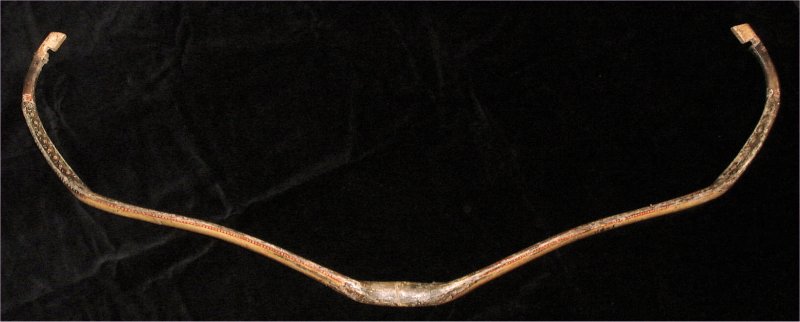

Back of the grip. I presume it was originally bound as the profile is very
narrow.

Decoration on the back of the limb.


Side view of the splice, siyah and tip.

Detail of decoration on the back of the limb.

Detail of chrysanthemum decoration at the back of the splice.

The two original arrows. Made of bamboo with shallow fletching.

Arrow nocks and fletching. No inserts in the nocks. No binding on the
fletching, but a layer of bark appears to have been applied below the fletching.
The cresting consists of three bands with ladder pattern edges, containing four
circular cartouches, each containing a black cross.

The arrow points. The heads are of forged steel, filed to a square,
bodkin-like point. An area behind each point has been covered in bark stained
with a green copper dye, with a band of ladder pattern at each end.
This bow is 178cm in length. The cross-section is round throughout. From a grip of 2.4cm in diameter the limbs taper in each direction to tips of 0.75cm diameter. 4.75cm from each tip there is a roughly-lacquered loop of hemp, which might either be the remains of a hemp string, or else an aid to tying on a separate string. The bow is made from a single piece of wood. Although the wood cannot be identified, it might, by analogy with native bows commonly found in Sri Lanka, be made of palm.
The whole limb is lacquered and painted in red, black and gold patterns of dots, bands and curlicues.

The entire bow. The slight curvature is consistent with the
original set of the bow.

One of the bow-tips with a hemp loop toward the end.

Detail of the curlicue decoration.

Detail of some of the stipple decoration

Stippling, bands and 'lotus flower' decoration on the limb.
December 2001
In November I was in Korea. I was lucky to be able to make short visits to the Korean Military Academy as well as the Bows and Arrows Museum in Paju.

Col. Ki-Hoon Kim of the Korea Army Museum kindly met me and took me around the facility. The museum comprehensively covers Korean military history. It is a wonderful opportunity to study Chinese military history as well, because there has been a long cultural cross-fertilization between the two cultures.
The Military Museum has an outstanding collection of archery equipment, covering bows, arrows, quivers, accessories, crossbows and archery-derived machines of war. The collection is well displayed and well-lit ─ but be forewarned that there are no labels in English!
|
|
|
What impressed me most was the group of young officer-cadets (both men and women) who were learning traditional Korean archery under the tutelage of archer/bowyer Kim Keong-won. Mr Kim is descended from three generations of Korean bow-makers. His father did not pass on his skills; but Kim Keong-won took the initiative to learn the craft from Bowyer Park Geuk-hwan of Kyongju.

Instructor Kim Keong-won demonstrating Korean archery
stance
|
|
|
I had a good chat with the Korean officer-cadets about the English longbow tradition and the points of excellence of the Korean horn bow. I also demonstrated some points of Chinese archery: they were quite amused at the thought of blind nocking an arrow.
A long drive took me, Tom and Nick Duvernay to Paju to visit the Bows and Arrows Museum set up by master fletcher Young-gi Yoo. We were shown around by his son, Se-hyun Yoo, who is a master fletcher in his own right.
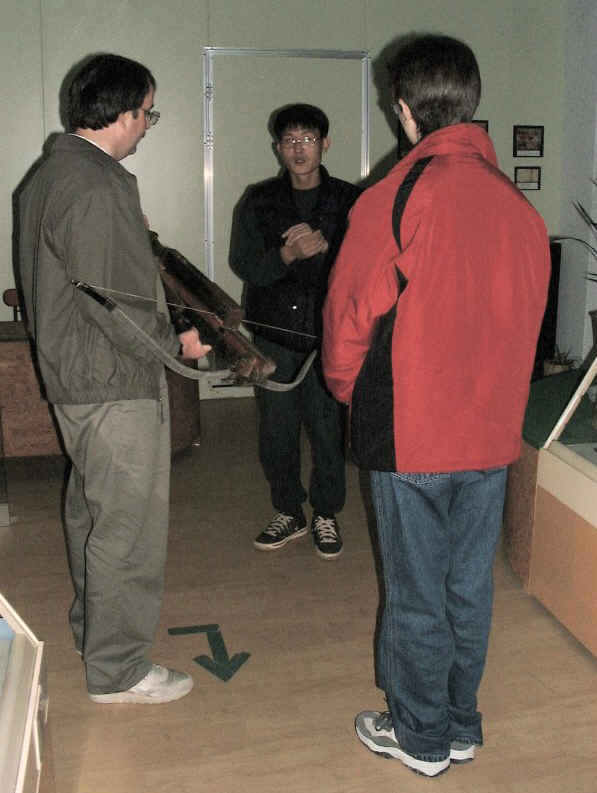
Tom and Nick Duvernay with Se-hyun Yoo
Unlike some other archery cultures in Asia, Korean bowyers and arrow-makers are fascinated by the bows and arrows of other cultures, as well as equipment that has been used in historical times gone by. This curiosity has led the Yoo father and son to explore Korean bow and arrow making in its broad historical and geographical context. The result is a museum which is rich in reproductions of historical equipment (particularly arrows and crossbows.)
Here, you can see a demonstration of six ground-mounted crossbows rigged to fire in unison. The forward movement of the bow-limb of one crossbow whips out a chock which triggers the firing of the adjacent one. The result sounds like a burst of muffled automatic fire.
|
|
|
Bede Dwyer introduced me to the use of the side-arrow guide (Arabic and Turkish Majra). I had a chance to study its use in the hands of an expert, Se-hyun Yoo. The side arrow is the logical extension of the idea of an overdraw. The tube - a fist longer than a full-size arrow, accepts a short dart. Such darts can achieve enormous speeds and better still, without the same equipment, the enemy can't shoot the short darts back.

How the dart lies in the arrow guide
The Korean arrow-guide has some special features. In some Middle-Eastern guides, the guide is a half-cylinder, so that the "wrap-around" of the dart does not exceed 180 degrees. The Korean guide has a wrap-around of around 225 degrees. Used with an ordinary dart, there is still a risk that if the dart is not well-seated in the guide at the release, it may jump out and hit the archer's wrist.
In battle, experienced archers used a conventional dart and relied on their skill to avoid such accidents. But learners used a dart which had a bulb in the shaft a distance above the point. Once inserted correctly into the guide, the bulb stops the dart from coming out of the guide. This prevents accidents, but makes for more friction between the dart and the guide, so that an plain dart was preferred for use by experienced archers.

How the arrow guide is held before the draw (ring and
little fingers are not used in the actual draw.)
At the release, the archer releases the string and arrow, but the guide stays
back with the draw-hand,
held by the loop around the middle finger.
Using an arrow guide is dangerous. In the last year, there has been a serious accident using one in Korea. Please be very cautious about trying to make and use your own.
Preoccupied with the prospect of his own mortality, The first emperor of China, Qin Shi Huang (259-210 BCE) was said to have sent ship-loads of young men and virgins to search for the island of Penglai where, it was said, the herb of eternal life grows. Whatever the young men and virgins got up to on their travels, it did not include coming home with and magical herbs!
The legends lived on to the Western Han Dynasty, when it was fashionable to bury incense-burners in the shape of the mythical island with the dead. Once lit, the smoke from the incense seeped out through holes in the cover of the burner and formed swathes of mist around fantastic scenes of immortals hunting deer, tigers, bears and mystical chimera.
I came across one such incense burner in Hong Kong last week.

Western Han (206 BCE - 8 CE) 'boshan' incense-burner.
The incense-burner is made of high-fired , unglazed gray clay. It is typical of the clay burial items made in Sichuan, western China, in Western Han times. The cover is in the shape of a conical mountain top. Animals are depicted (lizards, snakes, dogs, deer, an elephant and tigers) together with human-like Daoist immortals.
For us, the interest is in the Daoist immortals, some of whom are armed with crossbows for the hunt. Others are restraining dogs on leashes, or beating drums or cymbals.
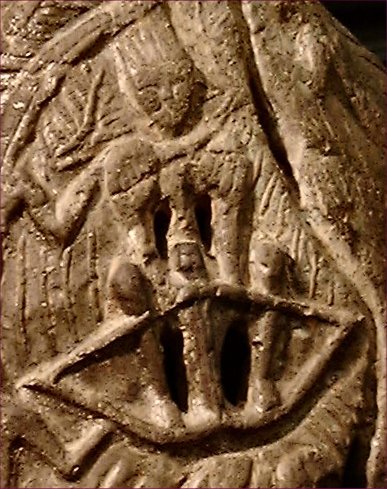
Loading a crossbow.
In the above photograph of the incised design, the raised teeth of the lock are visible at the top of the crossbow stock, and the general proportions of the crossbow prods to the stock, as well as the proportion of the whole assembly to the hunter, can be seen. (The human-like arm and leg on the left actually belong to an enormous lizard!)

An immortal with a special head-dress sits on a tree stump
beating a small drum or cymbal.
We should safely be able to assume that these scenes represent the way that the Han aristocracy went on hunting parties. A genre of poetry of that time, the 'Fu' style, often described hunting trips in the royal hunting parks in lavish language. If you look at some of the Chinese crossbows I have described on ATARN, clearly we are looking at hunting equipment for the aristocracy rather than a foot-soldier's weapon of war.

Going hunting with a crossbow
Again we get a clear impression of the size and proportion of the early Han crossbow. The hunter seems to have a wooden table or case strapped over his shoulder. It's too big for crossbow quarrels (but it would be handy for a hunting rifle and telescopic sight!) I wonder what it was used for...
I look forward to reading your answers on ATARNet.
January 2002
The 12th Asian Archery Championships were held in Hong Kong from December 10 - 15, 2001. At the kind invitation of Joe Lam I went to 'cover' the event for ATARN.
Needless to say, this was an competition with counter-weights, clickers, sights and shock-dampers. What was there for Asian traditional archers? My idea was to use this opportunity, when Hong Kong was being honoured with visits from the top FITA archers from Asia, to sound out their awareness and feeling for traditional archery in their own countries. The results were interesting, in some cases exciting and in others disappointing.
Myanmar (Dr. Khin Shwe, President of the Myanmar Archery Federation): "Certainly we have traditional archery. We have the Naga, Shan and Karen peoples hunting with bows and crossbows in the forest, using poison arrows."
Sri Lanka. (H. R. Wickramasinghe, Team Member): "The Weddas still live in parts of Sri Lanka, although much assimilated. Some time ago, when we were building up archery in Sri Lanka, we went to seek out Weddas who could be trained to shoot in the Western fashion."
Philippines. (Ramon Lim, President of the National Archery Assoc. of the Philippines): "The Aita tribespeople of Mindoro shoot with bamboo bows and arrows for hunting."
Korea. (Prof. Sung-Ho Um Ph D. Director, Korean Archery Association): "As you know, traditional archery is very strong in Korea. But perhaps you didn't know that traditional archery and modern archery in Korea only split in 1983. Before that, they were a single discipline. The Korean traditional bow has to hit a target at over 140 metres, so the bows have to be very heavy (around 40-50lbs). For this reason in Korea, children starting archery at about ten years old have to begin with western archery, and they don't get introduced to traditional archery until later when they are strong enough."
Kasakhstan. (Irina Korotraya, Team member): "Nyet. Nyichyevo."
Islamic Republic of Iran. (Abdol Vaheed Fadee Ebrahami, Team member): "There's no more traditional archery in Iran; but that is not to say we are not interested. Actually, our coach, Mr. Khosroo Shahbandi, is very interested in traditional archery and he has an old Persian bow in his home. "
There were other teams; but I didn't get a chance to interview them. I came away with a strong feeling that ATARN could do some outreach to Modern archers in Asia, encouraging countries who no longer have a strong archery tradition to research and try to revive some traditional shooting. I can see particular potential in the warm responses I got from Iran and Sri Lanka.
My interest in 'Thingies' continues unabated. You will recall my article from 2000, Thingies Up-close and Personal and the Follow-Up Discussion that ensued on the Discussion Forum. Since that time, ATARN readers have emailed me with their ideas.
In the meantime, I have been scrutinizing archaeological reports of new excavations of thingies. Several have appeared in the past two years. I have also purchased a further pair of thingies which are in their original, excavated condition and provide some interesting clues.
Archaeological reports have offered no new
evidence of thingies in the context of bows and arrows. However, a good report
was published in 'Archaeology' ('Kaogu') 2000.7 p. 13 of an excavation of a Shang/Zhou
grave at Tengzhou in
Shandong. Grave #4 contained a well-preserved two-horse chariot burial with a
single human skeleton in the usual position under the rear of the chariot. The thingie
in this burial was at the forward edge of the platform of the chariot, and not associated
with the corpse or any archery items. It was, however, associated with a dagger
axe and a number of belt-related items.
This consistent relationship between thingies and belt items suggests that Adam Karpowicz's view in his contribution in February 2000 were correct -
"... ...Based on the above, I believe the
thingies were tied to the soldier's belt at his waist. The reins would be hooked
over the projections, easily accessible in case the horses needed to turn, stop
etc. The base of the thingie is curved to
follow a contour of the soldiers belly and wide enough not to drop down when
tied. Traces of lashing were found at the junction of the base and the
projections."
His comment reminded me at that time of some very large thingies I have seen, which could hardly have been associated with a bow, but would have nicely fitted a large charioteer's belly.
Last year, I purchased two more thingies. Here are photographs of them.


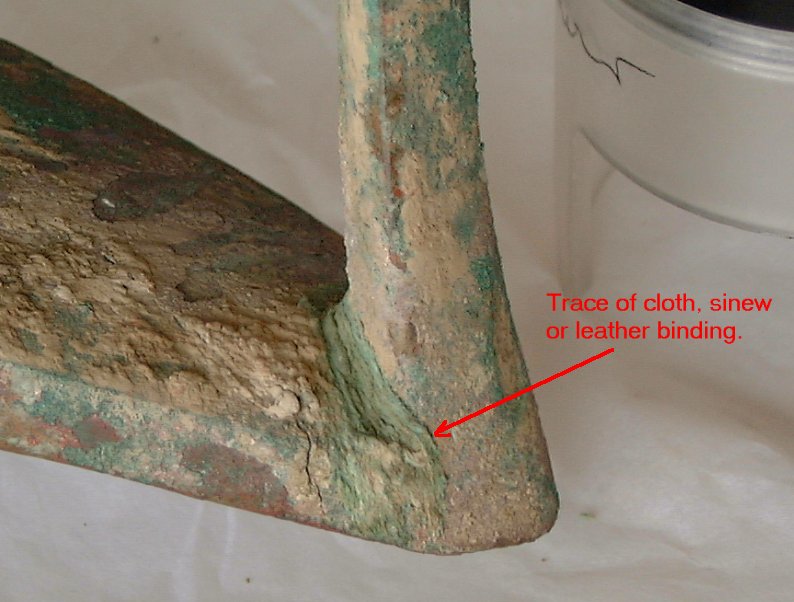
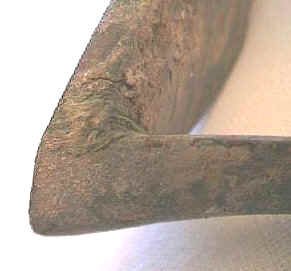 These
traces of bindings suggest a rather flimsy attachment to whatever was underneath.
Why would that be? The answer must be that a driver wanting to hang the reins of
two galloping horses would be keen to ensure that in case of an accident, he was
not firmly attached to the reins. A leather thong at the position indicated in
the photograph above would be sufficient to keep the thingy firmly on the belt,
but break off if the driver started to be dragged. It is similar to the idea
that if you tie a horse by a lead-rein in a stable, you tie the lead rein to a
string, and not directly to a bar, in case the horse bucks in a panic and breaks
its jaw.
These
traces of bindings suggest a rather flimsy attachment to whatever was underneath.
Why would that be? The answer must be that a driver wanting to hang the reins of
two galloping horses would be keen to ensure that in case of an accident, he was
not firmly attached to the reins. A leather thong at the position indicated in
the photograph above would be sufficient to keep the thingy firmly on the belt,
but break off if the driver started to be dragged. It is similar to the idea
that if you tie a horse by a lead-rein in a stable, you tie the lead rein to a
string, and not directly to a bar, in case the horse bucks in a panic and breaks
its jaw.
An ATARN reader recently drew my attention to a British Museum web page (http://www.ancientegypt.co.uk/pharaoh/story/main.html) with an illustration of an ancient Egyptian charioteer, Pharaoh Ramesses II, whose chariot reins were attached to his belt (although no thingies are in evidence.)
Unnecessary when riding a horse because other aids are available, thingies would be indispensable if you were a charioteer on a chariot drawn by two horses with simple reins. You would be able to wrap the left rein pair on the left hand horn of the thingy and the right pair on the right. You could keep mouth contact while your hands were engaged elsewhere, steer to left or right by rotating your hips and regain the reins quickly.
Someone needs to try this out. Not me, thanks. And at your own risk.
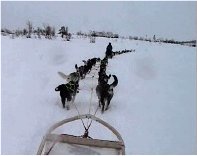 Hong
Kong is a sub-tropical place, so my ten-year-old daughter has never seen
snow. To cure that (with a vengeance), I took my whole family to the Arctic
Circle in Trømsø,
Norway for the Chinese New Year Holiday.
Hong
Kong is a sub-tropical place, so my ten-year-old daughter has never seen
snow. To cure that (with a vengeance), I took my whole family to the Arctic
Circle in Trømsø,
Norway for the Chinese New Year Holiday.
Norway is a beautiful country with friendly people. We visited a very nice village called 'Hell' (frozen over) and in Trømsø there are some excellent museums that offer a view of the pre-history and modern life of the European Arctic peoples - particularly the Sapmi (Saami - related to the Lapps).
The Sapmi followed reindeer herds on their migration paths, and in the North-west of Mongolia, in the Altai mountains, the Tsaatang people have many cultural parallels to the Sapmi, including riding reindeer and making birch bark sleds drawn by reindeer for carrying infants.
The Sapmi can be regarded as an Asian archery culture, given the wide range of their migrations. They used recurve bows made with wood and sinew, and such bows can be seen in rock carvings such as those found at Alta, on the Northern coast of Norway.

Rock carving from Alta, Norway.
But how old are they? Thousands of years,
or dating from Christian suppression of
Sapmi traditional beliefs
in the 17th - 18th Centuries?
Explorers in the 18th Century still observed these slightly recurved bows among the Sapmi.

Sapmi (Lapp) man (with bow over his shoulder)
on the frontispiece of an 18thy Century book.
(Trømsø University
Museum)
Displays in the Trømsø University also include a partial Sapmi bow and crossbow. Unfortunately, the bow was in too poor condition (only the wooden core remained) to allow for a meaning photograph.

Sapmi Crossbow, 19th Century.
(Trømsø University
Museum)
You will recall that some time ago, I described a bone insert from a bow dating back to the Khitan culture, which derived from the Huns and dominated north China in the 10 - 11th Centuries.
Recently, I obtained two more fragments of bows. I have to make it clear that I have no proof that these items are parts of bows. They were not found with other recognizable parts of bows.

This is the item I showed earlier. It appears to me to be a bow-tip
insert.
The new items are made of bone (not horn) and appear to be grip-reinforcements. Their general age and the condition of the bone suggests that they are contemporaneous with the insert described above. Although I have two, they do not seem to be a pair as they vary slightly in size and state of preservation. Apart from the shape, which would plausibly indicate that they formed a reinforcement to the grip and the lower, non-working parts of the limb, the items are clearly scored on the inner surface in exactly the same way that I have seen modern horn bowyers use to ensure maximum adhesion between horn and wood. Let the pictures below speak for themselves.
Front and rear views of the bone grip reinforcement.
(Both are views of the same item.)

Oblique view of the inside showing scoring.

The end of the grip reinforcement where it would have abutted the horn.

Lateral view of the reinforcement. Note the even depth.
Of course, I can accept that this item might have had another use. But the scoring seems to me to be a give-away. What other usage would have required such precautions to ensure a firm glue bond?
I look forward to hearing Member's comments. Please could you open correspondence on AtarnNet under 'hardware' if you want to have a discussion?
April 2002
A desert tomb in Jiayuguan, Gansu, Western China, has recently yielded up a wooden, model bow. Bede Dwyer and Grózer Csaba, who have both pre-viewed the pictures, consider that this bow is a full-scale model of a horn and sinew bow. The bow is in light-weight wood carved from two pieces. The two pieces unite at a splice at the grip. There is no sinew visible on it, and just a little birch bark remains adhering to the back of the bow.

The bow comes from near Jiayuguan in Gansu, China.
This map is reproduced from the Microsoft Encarta World Atlas in accordance with
the
licence conditions concerning use in free flyers not sold in any form or
context. Copyright reserved.

The two wooden components, with the grip splice to the right and the tips to
the left
Above is a photograph of the two parts of the bow. The main working part of the limb forms a broad plate, bearing a painted design on each.

Side view of one of the siyahs. The tip is broken off about 5cm short of the
end on the right.

Dragon painted on one of the limbs (belly side) in black, white, red and
ochre.
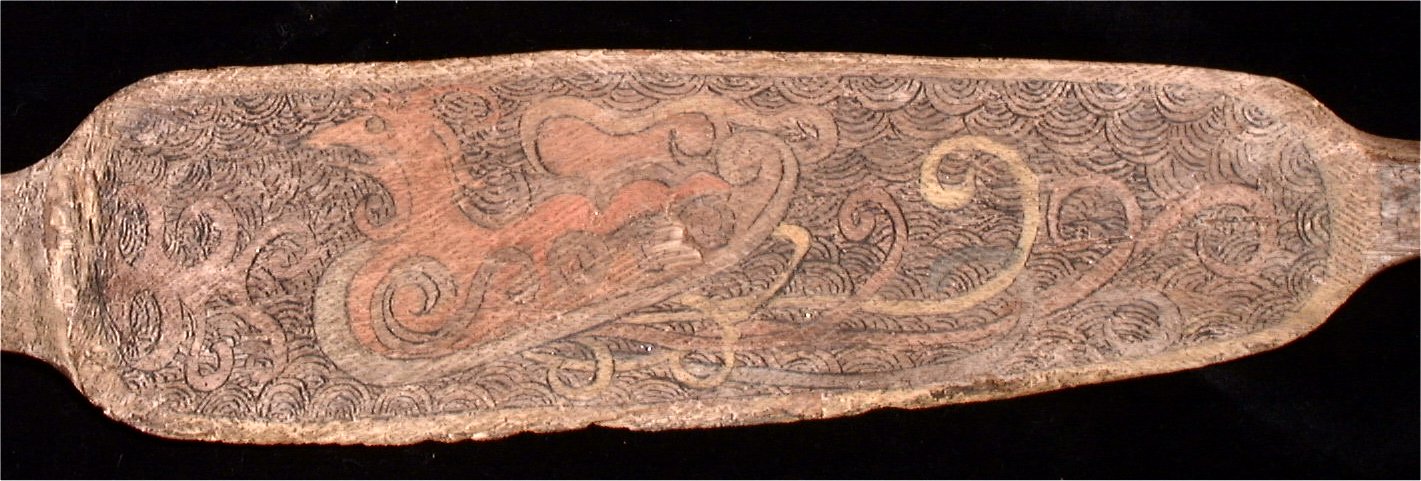
'Phoenix' painted on one of the limbs (belly side) in black, white, red and
ochre.
These dragon and phoenix designs should not be interpreted in terms of modern Chinese symbolism. This bow came from a group of graves dating from the Wei/Eastern Jin period, around 260CE. At that time, the dragon was the 'black dragon' -- a Daoist symbol of the East, while the bird was the 'red bird' -- denoting the South. Both symbols were derived from constellations, and continued in use from the Han dynasty. Such images would allow the soul of the deceased to rest in peace.
|
|
|
The black dragon and red bird from Eastern Jin tomb tiles.

Painted cicada design from the siyah of the bow
The cicada design on the limb also represents a hold-over from the Han Dynasty, representing a return to life for the deceased (because the cicada was thought to return to life in springtime from a dry, lifeless state in the winter.)

Floral design on the side of the grip splice.
The flower on the grip may be 'hai tang' (crab-apple) which rhymed with the word for 'high rank'.

The two splices placed together to form the core of the grip.
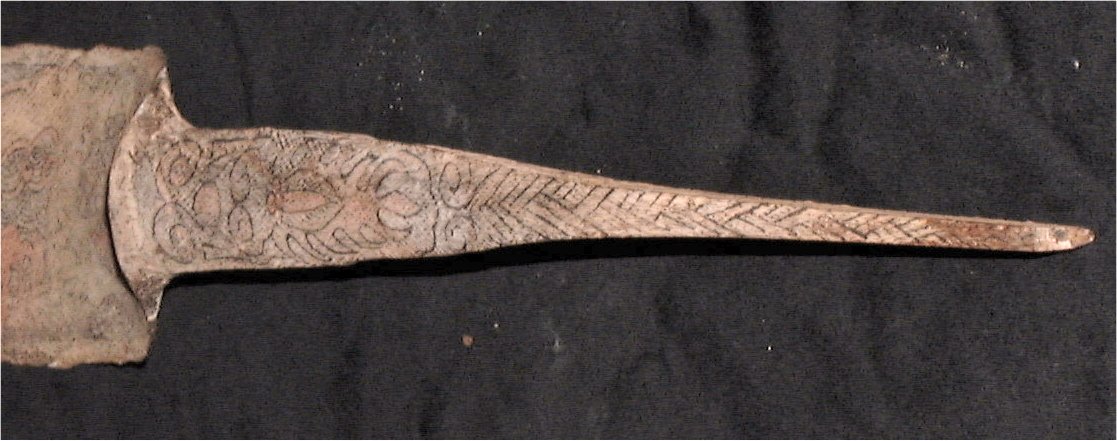
Basketwork pattern on the top of the siyah.

Two wood elements joined at the grip splice (vertical view).

Two wood elements joined at the grip splice (side view).

On the back of the main working parts of the limb, there are some remains of
blackened birch-bark.

Scraping on the wooden surface of the bow.
Every wooden surface of the bow - whether painted or not - has been scraped transversely in two directions, apparently with the teeth of a saw. I cannot work out why that should be. When wood is scraped so that horn or sinew can be attached, it is usually just scraped in one direction - lengthwise.
The original bow would have had bone reinforcement at the grip, and indeed the pieces that I have shown in previous newsletters would fit well (although they undoubtedly come from different specimens.)

Bow-tip reinforcement (not found with this bow)
Bow grip reinforcement (not found with this bow)
I was interested to see how the bone plates I discussed in the March 2002 newsletter (above) would fit to this bow. The following photographs show how:

Possible placement of the bone reinforcement for the face of the grip.
Two years ago, I reported about the Niya bow that was discovered in 1999. Since the Niya find shared the same late horizon with the Gansu bow - the Eastern Jin period - I was interested to see how they might compare.
First, this is how I would reconstruct the Gansu bow:

Reconstruction of the Gansu bow unstrung, with bone string-nocks and
grip-reinforcement.

Reconstruction of the Gansu bow string
And now my reconstruction of the Niya bow for comparison:

Reconstrution of the Niya bow (oblique, viewed from below)
Clearly, there are some striking similarities between the Gansu bow and the Niya bow. The design seems to have been very durable among the borderland people of China, and was probably closely related to the Song and Yuan bow designs in use in these pictures:
|
|
|
This is where the SVG file comes in. I have prepared a dimensioned drawing of the Gansu bow. If you have downloaded Adobe's SVG viewer plug-in, you can look at the bow and the plan in detail.
In fact, in the same group of graves as the one from which this bow came, there was a painted panel showing a scene of hunting with bows on horseback.

Scene of hunting with bows on horseback from the same date and
location as the Gansu bow.
Click here for the detailed dimensioned plan of the Gansu bow in SVG file
format.
I look forward to reading your views and ideas on ATARNet. Please start a new thread, 'Gansu Bow' under 'hardware'.
May 2002
ATARN is gearing up our out-reach in China.
From 12 - 15 April, I went with a television crew to continue working on a documentary about Ju Yuan Hao. This was a follow-up to a visit late last year, and we filled in some blanks that we had left in our last round of filming. All the items on our 'storyboard' have now been covered.
Next we went to a training session for young archers. The group are all undergoing intensive training in FITA archery for the 2008 Olympics. They do two hours' training every day, and a whole-day session on Saturdays!
Their club was an indoor range. It was rather cramped. We filmed the young people during their practice session, and then I took out a Ju Yuan Hao training bow (woefully weak, bamboo only!) and allowed the kids to have a go.
Their excitement was palpable. All these kids know that the bow and arrow are an ancient weapon of the Chinese people; but none had ever had a chance to handle traditional equipment. The TV crew interviewed them. Some said they would definitely want to learn traditional Chinese archery, because their type of regular FITA training lacked variety. They believed they could learn something from old Chinese techniques.
I took along Ting Ting, the great-granddaughter of the Chengdu Bowyer, Wu Shu Sen. She had never handled a bow of any sort in her life. With the young archers watching, I helped her to set up a shot and fire two arrows. Determined not to let her side down, she kept a perfectly erect stance and held the bow proudly.
Afterwards, when the TV crew asked her how she felt, tears rolled down her cheeks -
"I never realized what my ancestors had done in the past. It was such an emotional experience for me to handle a bow for the first time, knowing that my great grandfather had been a famous archer, and my grandmother had been a prizewinner in a national archery competition. I didn't know any of this until Stephen told me. How could we have abandoned such a glorious tradition in our Country. I am determined to learn archery!"
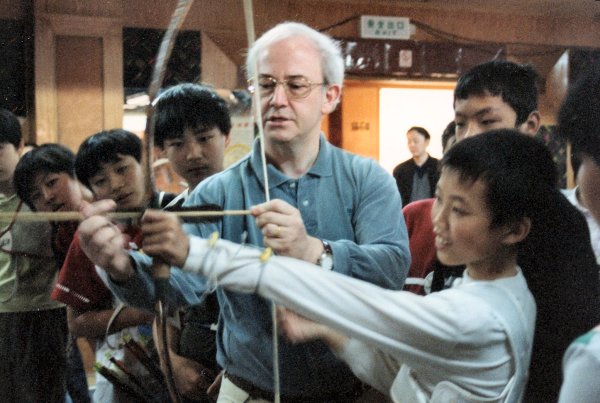
I have decided to hold a camp in Peking in the winter to introduce youngsters to traditional Chinese archery. Ju Yuan Hao's bows are too fine and expensive for beginner training for kids. I am ordering 100 very simple reproduction Chinese bows in glass fiber from a well-known factory (don't ask me the name or the price: it's a secret deal!). The bows will be donated to the Chinese National Archery Association to be lent out for training and practice by young archers. When the kids are used to them, they can order from Ju Yuan Hao if they want (and can afford to).
This project is going to cost more than US$10,000. I shall seek sponsors in Hong Kong; but I and the Chinese Archery Association would warmly welcome any offers of donations from ATARN Members to help out.
Another filming experience was not so happy. In the couple of days before its demolition, we filmed the old "Bow and Arrow Association Hall". The hall was originally the site of the ancestral temple venerating Xuan Yuan, the patron-god of the bowyers' trade in Peking. It was also a sort of guild hall for the bow-makers. The building was not particularly old, having burned down several times. It was last reconstructed in the 1960s, and used up until the Cultural Revolution for the annual ceremonies for the birthday of Xuan Yuan (24th day of the fifth month.) Some of the old people sitting around remembers the Association Hall. Seventy-five-year-old Mrs. Qiu had been employed as a cleaner and watchman for the Hall in the old days.
|
|
|
|
After demolition, it will no longer be possible to find the original location on which it stood. It is sad to loose yet another landmark of Chinese archery. But if we can start to build a love of traditional archery among young people in Peking, I will feel better about it.
This month marks an important development: I am undertaking a visit to Qinghai (north of Tibet) and Xinjiang to study the situation of traditional archery there.
Qinghai has regular, traditional shooting competitions among the Tibetan people. There are also one or two traditional bow and arrow makers there. In Urumqi, we hope to examine bows and arrows found together with the desiccated mummies of the Tarim Basin. Near Ili, there is a settlement of Manchus who still maintain a traditional archery festival (but using western bows.) There are also two craftsmen who used to make traditional bows, but have stopped due to lack of the proper materials. I have asked them to make me models of the bows they used to make, so that I can see the appearance.
Please be patient for the next newsletter, as it will take me some time to digest and arrange our materials.
BOOK REVIEW
Feliks Hoff, 'Kyudo: The Way of the Bow'. Shambhala Publications Inc. Boston/London, 2002. ISBN 1-57062-852-1. Paperback. 255 pages. US 19.95.

This volume by Feliks Hoff is an English translation of Hoff's book, 'Kyudo: Die Kunst des japanischen Bogenschießens' published in 1999 by Verlag Weinmann, Berlin.
I am not a Kyudo practitioner, so I am certainly not in a position to criticize the text. But the book is an instruction manual for the novice learner, and I have read it from that point of view.
Hoff's book is a methodical instruction manual for the Kyudo style of the Heki School. It goes through a brief history of Kyudo, the lay-out and etiquette of the Dojo (practice hall), the bow, bowstring, arrows, quivers, dress and accessories. Then it takes you step-by-step through technique, correction of mistakes, competition forms and examination forms, together with a description (without detailed explanation) of other special forms such as military shooting and yabusame (horseback archery.)
There are plenty of photographs and line drawings, vital to help the learner to grasp the subject matter. Most of them are clear, although sometimes the author tries to concentrate too much information into one diagram. An example is a diagram (p. 129) summarizing the effects of different errors on the outcome of the shot. The reader has to look up numbers on the diagram against quite a complex table of 80 different errors. Some errors (e.g. #74 'use of a glove that does not fit') are omitted from the diagram altogether (perhaps the glove comes off before the arrow even gets fired!) The diagram about aiming (fig. 11.4), while less complex, is labelled with transliterated Japanese terms that refer to various stages in setting up the shot, then jumps to an English term, 'full moon', that I could not find explained at all.
I was curious (although this is not a criticism) about the explanation of the step in which the archer has to 'turn the edge of the bow to the left' out of the path of the string at the moment of release to stop the arrow from 'being diverted considerably to the right at the last moment'. Such an action is not required in Chinese archery (or as far as I know, in English longbow shooting), although the arrow-pass is much more pronounced than on a yumi, due to the effect of the 'archer's paradox'.
That archer's paradox is at play in Kyudo is evident from the fact that the string is drawn well behind the archer's ear at full draw, without any risk of the string slicing it off. (I have tried this and I know it to be the case.) I remain to be educated on this point.
The appearance of Hoff's book begs the question of how it should be compared with Hideharu Onuma and Dan and Jackie DeProspero's 'Kyudo: the Essence and Practice of Japanese Archery.' (Kodansha International, 1993.)
This is a difficult question to answer other than at the superficial level that 'Kyudo: Essence and Practice of Japanese Archery' is a more luxurious publication in terms of production and is thus rather higher-priced ($32). I rather prefer the series of visualizations in the DeProsperos' book to the composite illustrations in Hoff. On the other hand, Hoff's exposition of the history of Kyudo is more satisfactory than the DePropseros' one, and Hoff explains many technical points in greater depth.
Both Hoff's and the DeProsperos' books end with a short essay by a master. In Hoff's case, it is by the Master Genshiro Inagaki and in the DeProsperos', it is an interview with late Master Onuma Hideharu. It is interesting that both are tangentially concerned with diplomatically divesting Kyudo of the some of the baggage of Zen loaded on by Eugen Herrigel and subsequently re-absorbed in Japan. (See the gentle debunking by Yamada Shōji: 'The Myth of Zen in the Art of Archery'. Trans. Earl Hartmann and Ed. William Bodiford. Japanese Journal of Religious Studies, 2001 28/1-2. ISSN 0304-1042.)
Recently visiting California, I was surprised to learn that joining a tuition class for Kyudo is no easy matter. Kyudo seemed so Californian. As it turns out, the aspirant student has to join a weekend camp and then rely on private practice and occasional refresher camps.
In these circumstances, good training manuals are vital to reinforce teaching and support self-learning. Hoff's book serves this purpose with great thoroughness. I am sure that students will find it a valuable addition to the very limited English-language resources currently available (basically DeProspero together with the 'Kyudo Manual' of the All Nippon Kyudo Federation. Tokyo, 1994, and the very brief 'Japanese Archery' by William Acker. Charles Tuttle, Rutland Vermont and Tokyo, 1965.)
You will recall my description of a Warring States period longbow in one of my previous newsletters. I have prepared a zoomable .svg image of the longbow here. Subsequently, I reported on ATARNet that a Hong Kong Museum of History curator, Mr W. F. Lai, had analyzed samples of the wood from the bow and found that the species is Cudrania tricuspidata ('zhe mu'.) This is the species mentioned in the Chinese Classics as being the most desirable for bow-making:
"There are said to be seven
materials for the construction of the bow-staves. In order of quality, they are:
Zhe
(Cudrania tricuspidata), Wild
Mulberry,
Chinese
Orange , Papaya (Carica papaya), Thornwood
, and lastly bamboo."
(Zhou Li (The Rituals of Zhou), Dong Guan 'Gong Ren Wei Gong'.)
In December 2000, I judged the bow to date from the Western Han period (206BCE to 8CE).
Now, thanks to the efforts of the Hong Kong Museum of Coastal Defence who have commissioned a Carbon 14 dating from New Zealand, we have a fairly definitive dating: the bow dates from about 2300 years ago - in other words the end of the Warring States period. Not only does the use of Zhe wood corroborate the details of the 'Rites of Zhou', the bow actually dates from approximately the time that the 'Rites of Zhou' was thought to have been composed in the State of Qi.
This means we must revise any idea that high-class bows were all composite bows in ancient China. (Yang Hong states that only bamboo bows have been found in the state of Chu - renowned for its archers.) That this is not just a scaled-down item for burial purposes there can be no doubt. Dr. Grayson has inspected it and feels that it was made by a skilled longbow craftsman. The shape of he bow and the use of the grain of the wood are surprisingly similar to the Holmgaard Bow excavated in Sweden. ('The Traditional Bowyers' Bible', Vol. 2. (Ed. Jim Hamm, Bois d'Arc Press, 1993.p. 91 )
June 2002
ATARN has just completed a mission to Qinghai and Xinjiang in the People's Republic of China. Led by the Vice-President of the Chinese Archery Association, Mr. Xu Kaicai, the mission was strongly supported by local governments and sports bodies, who made elaborate arrangements for our transport and accommodation.
Our 'team' in Qinghai, led by Mr Xu, consisted of myself, my wife, Anne, my sister, Sally, Trinidad Campbell (ATARN Member from Argentina who lives in Los Angeles), Qinghai senior provincial archery coach, Qi Guihua and a television camera crew from Radio Television Hong Kong.
During the trip, we were able to investigate traditional archery among the Tibetan and Hui Muslim people, traditional bow-making at the local level, historic bows and arrows excavated among the mummies of the Taklamakan Desert and the surviving archery tradition of the Xibe people - descendants of the Xianbi of Manchuria - who still speak and read the Manchu language.
ATARN owes a debt of gratitude to the local governments, sporting bodies, cultural and archaeological authorities of Qinghai Province and the Xinjiang Uighur Atonomous Region of the People's Republic of China, as well as to our warm and hospitable hosts among the Tibetan, Han, Uighur and Xibe people.
The fruits of this mission are too many to describe in one letter. This month I am starting off with a description of Tibetan traditional archery in Qinghai and local bow-making. Future news letters will report further on this trip.
Qinghai is a province of China that used to be known as the Amdo region of North Tibet. The population consists mainly of Han Chinese, Tibetans Mongols and Hui Muslims.
As among other cultural groups in China, archery was supressed in the 1960s as part of the Cultural Revolution 'Smash to Four Olds' campaign. Luckily, however, not all the old bows were destroyed. I saw ten traditional horn bows in use, some of which, with repairs and some re-cylcling, had been in existence for three hundred years. Bows are passed from generation to generation: only a 'good' son can inherit his father's bow.
In Qinghai, traditional archery has been revived on the imitative of a group of retired Communist Party cadres - indeed possibly some of those at whose behest it must have been suppressed in the Cultural Revolution! Associations of people are still closely supervised in China, and it took the dedication of these retired cadres with their high-level Party links to be able to set up the traditional archery association, known as the 'Qinghai Province Retired Cadres' Sports and Recreation Association.'

Qinghai Province Retired Cadres' Sports and
Recreation Association with the ATARN Delegation,
Qi Guihua, Trinidad Campbell, Sally Selby (my sister), Anne Selby (my wife),
myself, and Mr. Xu Kaicai.
Reviving traditional archery in Northern Tibet is not easy. There are not enough traditional bows to go around. Those who want to shoot often buy locally-made fiberglass western bows that cost around 600 Yuan (US$77) each. Many of the local villagers only earn around US$200 a year. People with an annual income of over 5,000 Yuan pay 500 yuan to join the Association, otherwise the joining fee is $50 Yuan. Anyone (not just retired cadres) is welcome to join.
The association aims to organize five to ten competitions a year. Each competition is a two-day event, with the first day held at the 'home' team's village and the second at the 'away' team. Transport over great distances and prodigious entertainment with lavish eating and drinking make these events expensive to mount, at a cost of about 5,000 Yuan (US$640) each time.
High in the hills of Ledu County (Tibetan Drotsang county, birthplace of the Dalai Lama,) we drove up the muddy road to Xinya ─ the village of the 'away' team. The 'home' team following in a bus behind us. At the border of the village, a reception committee met us with ceremonial 'hadag' white silk scarves, barley cakes and small cups of distilled barley spirit. Already the amplified singing of Tibetan folk music was audible in the distance.
The competition
There are just two teams in a competition, with up to fifty archers in each. Only men take part: Tibetan women are strictly debarred from touching bows. In their traditional belief, doing so means that they must refrain from sex for a period of time after the 'infraction'.

The target, set at 94 metres and up a hill.
The target is placed at 100 paces (in fact, 94 metres) from the shooting line. At the home match, the target was at ground level but in Xinya village, it was placed up a cliff at about 16 metres above the shooting line. The target face was a 3 x 3 metre cloth stretched over a wooden frame with a red spot in the centre. In earlier times, the target was made of willow twigs bound together to make a target face. A hit anywhere on the target cloth or on the wooden frame scores a point. All the archers in both teams take turns to shoot three rounds with one arrow in each round, and the score is tallied up with score cards.
Judges (one from each team) stand at the firing line and next to the target with a flag to indicate a hit or miss.
bow.jpg)
Blessing a bow outside the village Gonpa
Our first stop was at the village Gonpa (shrine) where a monk took offerings of money, the prayer wheel was turned, and all the visiting team's bows were taken three times round a fire burning outside the gates of the shrine.
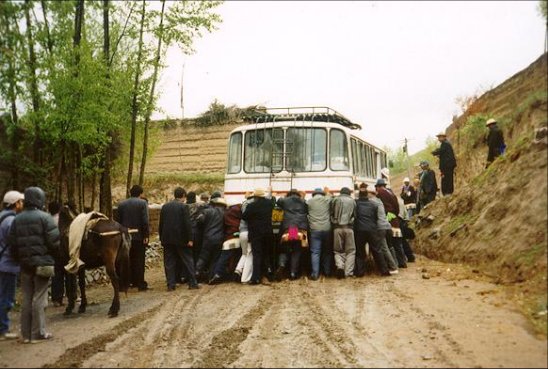
The away team encounters traction problems
The home team, together with an enthusiastic crowd of women and children awaited us at the shooting ground: a fallow field bounded on each side by a stand of birch and willow trees, with a clear view ahead to the target face up on the hillside.

Young spectators
Nothing starts until a large quantity of strong alcohol has been taken by both sides. Carrying trays of home-distilled barley wine, both men and women accost their guests singing in Tibetan "You are honoured guests from far away; we welcome you with fine wine." No-one may refuse a sip from each of the three glasses!

Young women in their best outfits have a keen eye for
eligible young archers.
Most of the archers and the on-lookers of both sexes are dressed in colourful Tibetan coats with white felt hats. The men's coats have long, hanging sleeves, and the archer's left arm is left out of his sleeve. His hat - which looks like a cowboy hat from a Western movie, has a popper which allows the rim to be clipped up on the right side out of the way of the bowstring.
As each archer comes to the shooting line, his team supports him with whistles and a short, yelping call that ends in a low hum like the chant of monks at prayer. The archer sets up his stance (sometimes with some advice from the team judge), aims and shoots.
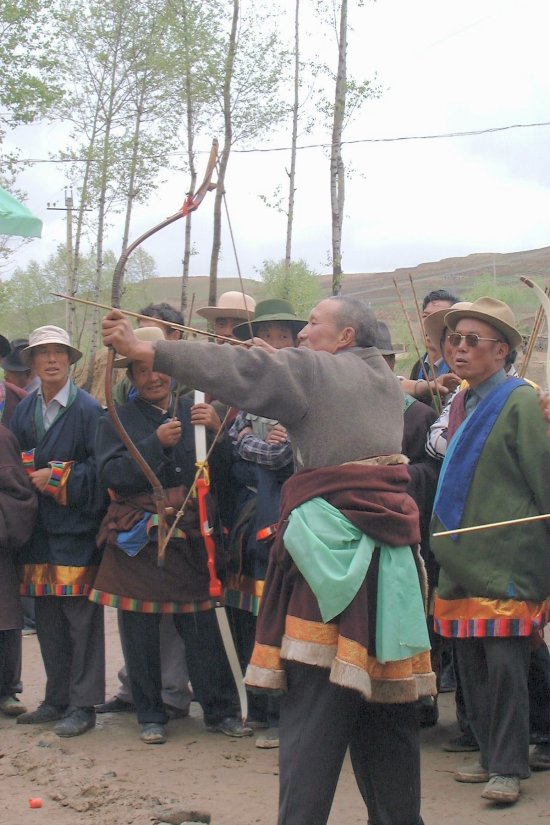
A low humming chant from team-mates helps to encourage
the archer on the shooting line.
Immediately, he jumps forward from the firing line in a show of bravado, anticipating his hit. If he hits, he leads his team in a dance up the archery range (oblivious to any shooting by the other team.)

The team dances out to celebrate a hit.
The dance is full of gusto: three or four steps with the long sleeves of the Tibetan coat twirled above the head, followed by stamping the feet on the ground with the sleeves twirled low. None of the set-piece Chinese adaptations of Tibetan folk-dance here! It is a war dance with accompaniment of a chant without words in rhythm with the stamping of the archers' feet.
The archer who scored has rushed forward with his bow, but a team-mate soon takes the bow from him while another leads the group of dancers. A third team-member waits at the shooting line to greet the dancers back to the line. Double whistles greet the archer who manages to score two shots in succession.
Remembering descriptions the Bhutanese archery competitions, I asked if there was any tradition of cursing the opposing team. Our hosts admitted that in some parts of Tibet, there were still such traditions, but they were frowned upon. Nowadays, archers are supposed to encourage each-other - not curse.
No attempt has been made to standardize shooting technique. The greatest variation is in the release. All the archers of both teams shot over the knuckle, but I saw two-finger draws, Mediterranean draws, pinch draws and two varieties of thumbring draw - both the Manchu and the Mongolian draw. Those who used thumbrings all had simple, cylindrical bone, copper or jade rings lined with soft leather or toilet paper, some with a red ribbon tied around for luck.
|
|
|
|
On the shooting line
Tibetan archers like to place their feet nearly at right-angles and lean into the bow at the draw, bringing the nock to the corner of the mouth. To cover the distance of over 90 metres, bows have to have a draw weight of at least 45 pounds. (I shot with a little 48-pound Korean FRP bow from Tom Duvernay that was greatly admired.)

One of Tom Duvernay's FRP bows from Korea was greatly admired
The fertility symbolism of archery among the Tibetans of Amdo is clear. Archery regularly takes place either at the Chinese Yuan Xiao festival (15th day of the first lunar month) or the Tibetan planting festival (25th day of the second lunar month.) The finely-dressed young men in the teams of archers, and the young women on-lookers in their Tibetan finery and jewels are a clear-give away. According to tradition, in the evening following the end of an archery competition, the shooting ground becomes the trysting place for the young men and women of the village.
VIDEO CLIPS
| 1 | 2 | 3 | 4 | 5 | 6 |
Bows
The Tibetan legend has it that horn bows first came to Tibet from China in the Tang Dynasty as part of the dowry of Princess Wen Cheng (d. 680) who was given in marriage to the King of Tibet, Songzan Ganbu in 642, bearing a dowry including Chinese technological secrets of agriculture, sericulture, building and paper-making.

Tibetan horn bows from Qinghai
Most of the horn bows I saw were identical to ones I had previously bought from the Qinghai area. Many were probably not made in the area, but imported from adjacent provinces. Depending on the profile of the splice between the limb and the siyah, one can detect bows originating both in Peking and in Xian over the past two centuries.
All the Tibetan horn bows have had their siyahs cut back from their Manchu-style originals. The Tibetans say that the long siyahs favoured by the Manchus slow the bow down too much. (This is undoubtedly true for Tibetan archery, with relatively light bows and light, wooden arrows.) Only rawhide was used to make the bowstrings.

Tibetan arrows from Qinghai
The arrows are finely-made barrelled poplar arrows with self-nocks, 78cm long with a 2cm iron tip. The maximum thickness is 1cm. The triple-fletching is 23cm in length with a maximum depth of 7mm. They are extremely expensive to buy at 100 Yuan each. Most archers therefore make their own or use commercially-available aluminum arrows.
I went to visit a local bowyer in Minhe County (Tib. Drotsang county.) Mr Ma is a Hui Muslim who used to be a fine archer in his youth. He could place three arrows in succession into a target at 100 paces. Now 65 years old, he repairs and occasionally makes bows together with his third son.

Ma Jnr. with some of the bows he made with his father.
There are just three local craftsmen who can repair horn bows. Due to a lack of raw materials, few bows are currently being made from scratch; but craftsmen will make up a new bow if they can find materials to re-cycle.
Ma charges 150 Yuan to mend a damaged horn bow. The most common fault is detachment of the sinew from the limb, for which the whole limb has to be re-built. If a new bow is made, the Ma charges around 350 Yuan for it. Due to maintenance problems, many Tibetans have bought a poor-quality, Chinese-made 'Zhonghua' brand fiberglass recurves (a design based on a basic Samick) at a cost of about 500-600 Yuan new.
Ma learned bow-making from another bowyer who lived far away in the mountains of an adjacent county. He uses a wood he called 'black ci' (black date. Also known by a local name, 'sha ji mu'. ) for the core and mulberry for the siyahs. If he can't re-cycle water buffalo horn from an old bow, he uses yak horn that he bends into shape after heating it in water. Usually, yak horn is not long enough and he has to use more than one piece. In that case, at least 2/3 of the centre part of the belly must be covered with a single piece of horn. Smaller pieces can be cut to make up the length at the grip and the siyah splice.
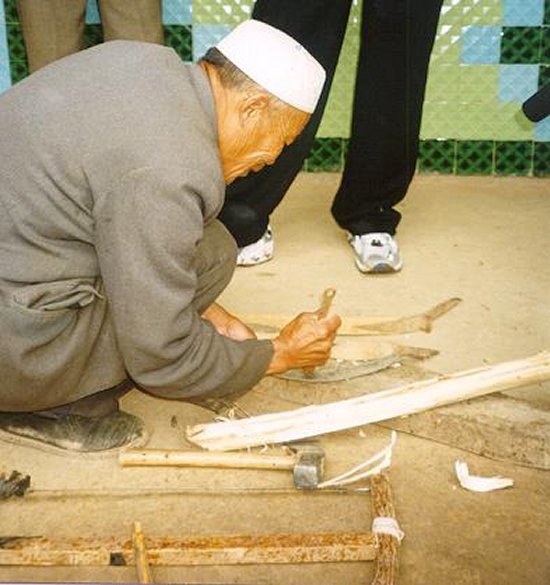
Mr Ma Snr. making a horn bow with minimal tools
His only tools are an axe, a saw, a file and a knife. He uses a commercially-available fish glue which comes in small granules, and heats it in water on a charcoal stove. Sinew is applied in seven successive layers with a minimum drying time of two weeks per layer. Before a new layer of sinew is added, the top of the previous layer is dampened with water and scraped with the oblique blade of the knife. (The resulting bows were around 70 pounds to draw when new; but settled back to 50 pounds over a period of time.) The grip is bound with a cork-like bark from the 'yellow ci' tree.
When the sinewing is finished, he tillers the bow by feel, bending the limb around his legs. He adds additional sinew to the weaker limb. (Limbs can only be tillered up - not down.) The string is then put on and if the two limbs bend unevenly, the more rounded of the limbs is bound to the string with a bow-bag so as to apply pressure to it and bring the bow back into shape.
Ma revealed that the Muslim Hui minority also organize traditional archery competitions at which Tibetans and Han Chinese join in. There are 15-20 archers in each team. Hui Muslims are not drinkers, so they make up for drinking by having elaborate picnics. Like the Tibetan archers, teams call out when the target is hit; but there is no singing or dancing. Muslims say that a woman must not touch a bow, otherwise the bow will never shoot straight again.
As with the Tibetans, young Hui men and women make dates to meet at the archery ground after the competitions.
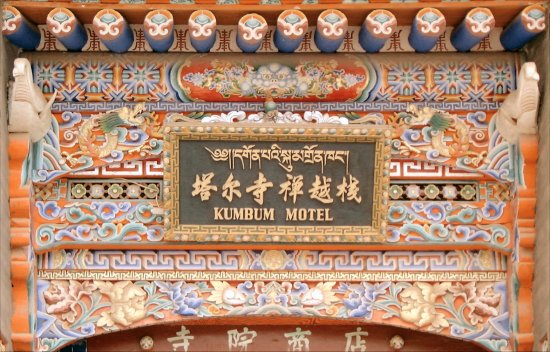
July 2002
Surrounded by other competitors and on-lookers, Alice is under as much pressure as she has ever been as a sportswoman at a golfing event. She has to get her shot out to over 220 yards. To do that, she will have to hit the ball off the tee with a driver about 45 inches long, striking the ball at 90-100 mph with a 'sweet point' about half an inch in diameter.
Alice Kwan is a Chinese golfer from Hong Kong. A petite four foot nine and weighing 97 pounds, she has had to overcome both physical and psychological problems to prepare herself for this golf driving distance competition.
She tees up; but now her mind is no longer amid a crowd of golfers watching her every move with a critical eye. She is setting up her shot in the middle of an empty golf course on a quiet Sunday morning.
"Anyone who is out in the parade ground under examination conditions is under enormous mental pressure. In such conditions, you have to remain calm and collected, just as if there were no examining officer watching over you and no crowds all around you: you must remain cool and calm. Just imagine yourself practicing by yourself out in the middle of nowhere; that will help you settle your mind and thereby bring you to the height of your powers; you won't let noises startle you or make panicky mistakes…"
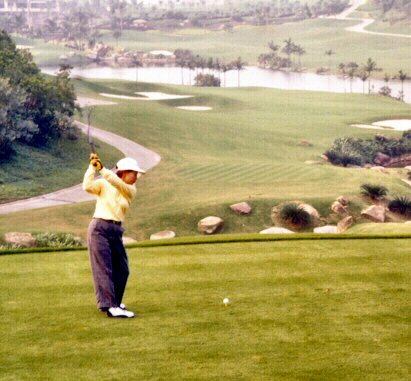
"Just imagine yourself practicing by yourself
out in the middle of nowhere."
The coach who gave Alice that advice died in about 1600: the Chinese archery teacher, Li Chengfen.
Alice is a determined amateur golfer who has worked for three years with her present-day coach. Although she had previously had some good achievements, her coach was not optimistic. Alice felt that the tempo and smoothness of her drive was good; but her coach felt that she faced serious limitations: "How far you can drive the ball is basically decided by your height and weight. With a height of less than five feet and weight under 100 pounds, you will be doing well if you could get a tee shot out to 190 yards."
That 'scientific' analysis stunted Alice's progress for six months. These were limitations - height and weight - that nothing short of a magical fairy-godmother was going to cure. Her coach had given her a good, logical explanation of the science behind his reasoning. The problem was not going to go away. Alice felt discouraged by her limitations, and her anxiety built up every time she set up for a tee shot.
____________
Alice's magical fairy-godmother showed up in an unlikely form: an encounter with the Chinese Classics. Leafing through my book, 'Chinese Archery', Alice came across the advice of Li Chengfen:
"When you are starting to learn, you have to bring your bow to full draw and shoot for distance. You are better off aiming high and passing over the mark than aiming low and falling short. Grasp shooting for distance first, then work on your accuracy from close in: don't set yourself too limited a goal!"
Li Chengfen's teaching, 'don't set yourself too limited a goal,' contains a direct allusion to the Analects of Confucius:
"Ran Qiu said: 'Although I do not wish to abandon your teachings, I don't have sufficient ability to put them into practice.' Confucius replied, 'Dropping out half way through on the pretext of not having sufficient ability is nothing more than you yourself setting limits to what you can achieve!'
In these two quotations, Alice saw her own predicament. She had accepted an artificial limitation. The secret was in the word 'distance'. Every time she thought of 'distance', in her mind's eye was a 'distance within'. Li Chengfen was telling her to raise her eyes and make that a 'distance beyond.'
The coach's scientific approach, aimed at calculating a maximum point or limit of motion, is good for devising a training programme or explaining the performance of a golfer. The trouble is that having committed to a scientific approach, what does the trainer do if science indicates that a dead-end has been reached?
____________
The Chinese people have always had ambivalent feelings about science that leads to limitations. The Chinese historically have regarded their civilization as one in which man is able to dominate his environment. Taming the great rivers when they flood, inventing agriculture and clearing wastelands, driving the Great Wall up to the peaks of mountains and into the depths of valleys was the core value of Chinese civilization. It was the 'barbarians' who lived a miserable life outside the borders of the tamed world, at the mercy of nature, driving their herds from place to place to avoid the elements.
In Chinese folklore, the first ruler to bring civilization to China, Huang Di, himself started off at the mercy of nature. This story was written on the wall of the Bowmakers' Guild Hall in Beijing: Huang Di was out in the countryside one day when he encountered a fierce tiger. Forced to take undignified flight up a mulberry tree, he watched the tiger prowling below. Within reach of the mulberry tree grew a clump bamboo and over the limbs of the tree, a creeping plant.
Seeing that the mulberry wood could easily be bent, Huang Di broke off a limb and used some of the creeping plant to make a string, then he snapped off a length of bamboo to make an arrow. With them, he shot the tiger in the eye and escaped.
From then on, says Confucius' commentary to the 'Book of Changes', Huang Di used the bow and arrow to bring all under heaven within his control.
____________
Alice set aside science and applied Confucius. Borrowing Li Chengfen's approach, she set a distant target beyond the scientific 'limit' of 190 yards without getting obsessed by whether she could drive a ball past it. Immediately, she felt liberated.
Li Chengfen's other teaching was about mental pressure. How could Alice control her emotions? Li's answer was to do two things: first, to make a conscious decision not to allow the outcome of a shot to affect your emotion. Quoting the Song Dynasty general, Su Xun, Li said:
"The essence of generalship is in controlling emotions. He shows no pleasure in praise, nor irritation when provoked; takes no pride in victory nor anticipation of defeat. If Mount Tai were to crumble before him, he would not flinch; if a tiger or rhinoceros were to break cover behind him, he would not turn a hair."
The second element in the approach is to analyze and store the physical sensations surrounding the good shots, while analyzing and discarding the sensations surrounding the bad ones. Li reminded Alice of Confucius's teaching: "any error on the target face had its origin in the archer: not in anyone else."
The sensations surrounding the good shot are stored away for recall when setting up the shot while the sportsman is under pressure. It is a process described by one Chinese writer as 'removing the flaws from jade': the craftsman rubs away at the flaws, leaving an perfect piece of jade.
____________
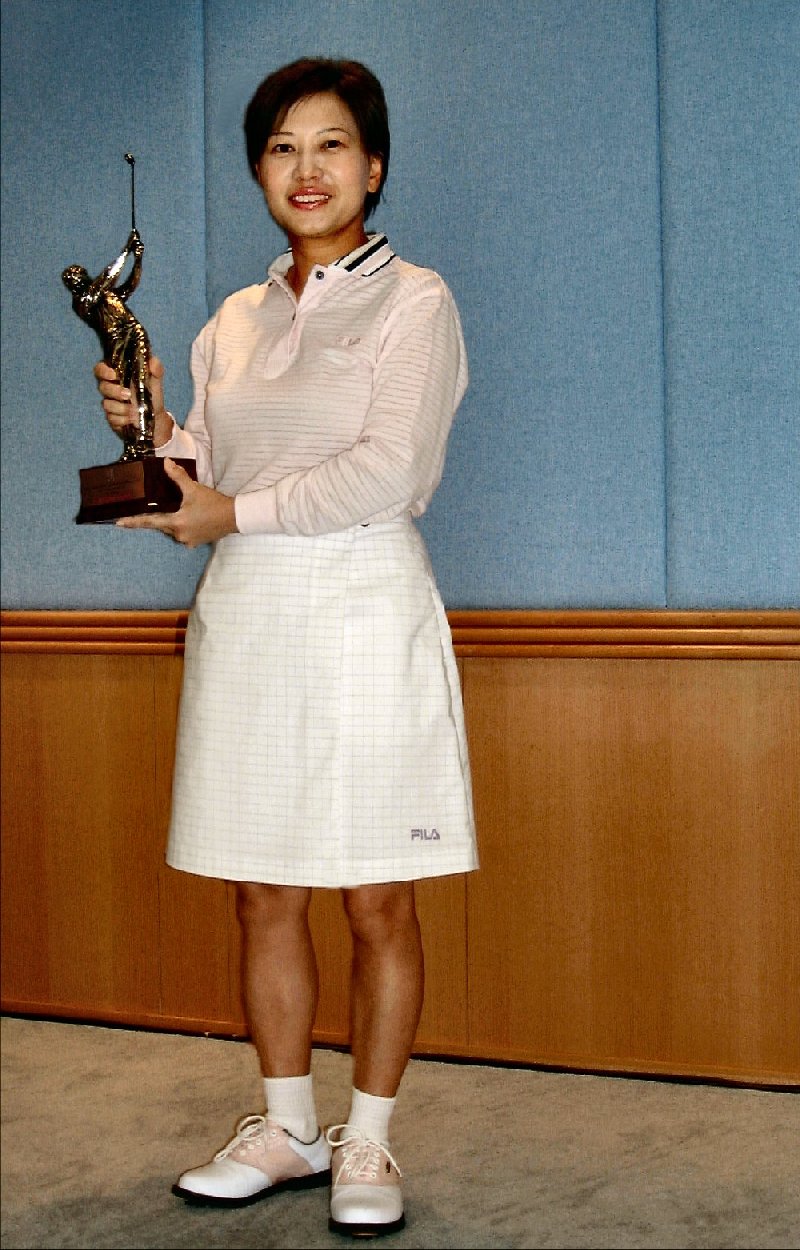 Competitive
sports require an enormous investment of effort and strength. But at the point
of release, strength and effort must come to an end and the shot must be
executed in a state of peace. Ancient Chinese writers said, "Draw the bow
in a state of tension and release it in a state of relaxation."
Competitive
sports require an enormous investment of effort and strength. But at the point
of release, strength and effort must come to an end and the shot must be
executed in a state of peace. Ancient Chinese writers said, "Draw the bow
in a state of tension and release it in a state of relaxation."
We all know that Chinese people value the balance of 'yin and yang'. But few in the West understand that yin and yang don't settle into a natural state of balance like an evenly-weighted pair of scales. The balance of yin and yang is like an acrobat on top of a pole. To get up the pole, the acrobat must exert himself; but once there, the slightest untoward motion or emotion will topple him off.
Chinese writers listed things that could cause one's performance to topple: wanting to shoot too much; not wanting to shoot at all; being in a hurry to reach the archery ground; being in a hurry to finish shooting.
Alice studied and applied the lesson of Li Chengfen:
"You are on the road to battle, the sky darkened with flags and pennants, the ground shaking with the crash of gongs and cymbals, the sun obscured by the blades of the enemy, the dust churned by the hooves of the advancing nomads' horses. With each thump of your heart, your hands shake and a chill enters your body. The hand that on a normal day can shoot through seven layers of leather armour must not let you down on this day!"
She emptied her mind and thought back to her practice sessions, her mind freed of any limitation, swinging her club on an empty course in the sunshine.
Alice won the competition with a drive of more than 230 yards.
(My thanks to Alice for the technical details, and for letting me reveal her weight!)
Last month, I described my travels to Qinghai (Amdo) and Xinjiang. While there, I was given the opportunity to study a number of bows preserved in Xinjiang's Institute of Archaeology and the museums at Urumqi and Turfan.
I had the chance to study three types of bow, all three of which had at one time or another been buried like mummies in the frozen, dry sands of the Xinjiang deserts. One of the bow groups I studied dated from the very end of the Han Dynasty or into the Wei-Jin period. That is, from around 250-350CE.
On studying this group of three, almost identical bows closely, a couple of points became immediately clear.
First, the description of the Niya bow in "Archaeological Treasures of the Silk Road in Xinjiang Uygur Autonomous Region" Ed. Ma Chengyuan, Yue Feng. Shanghai Publishing Translation House, 1998, in conjunction with the illustrations in the January 2000 edition of the Chinese archaeological journal, 'Wen Wu' (2000/1), had been misleading. All the illustrations had concentrated on a side view and had failed to do justice to the form of the bow when seen from the front. Furthermore, the person who did the drawings of the Niya bow also faithfully reproduced the effect of the distortion of the wood on the original item, but in the process gave an exaggerated impression that the length of the limbs were very different. In fact, optically, the limbs on these bow are identical in length.
The second point was that, clearly, the bows I was observing were full working bows of the same design described in my previous letter on the Gansu Bow. These bows show beyond doubt that my Gansu Bow was a full-scale model in wood of a bow that would normally be made of wood, sinew and horn.
The second point is of some importance in itself. Despite reading frequently of 'model bows' placed in graves, the 'Gansu Bow' is only the second certain example I have come across. (The first is a Liao Dynasty wooden model of a bow and box quiver .)
My examination of the three bows in the Museums gave me a chance to glean some data and correct general wrong preconceptions about these bows. However, everything I examined was behind glass and I was not permitted to take photographs (although I could sketch to my heart's content.) Even my measurements had to be estimated (supplemented by earnest attempts by the archaeologists with me to recall actual measurements.) The golden opportunity came, however, when a junk dealer in Xinjiang sold me one half of an original bow (together with one half of the original string and six arrows) that had come from Khotan. So identical was this bow to those I had seen in the museums that I have no hesitation in saying that this 'Khotan bow' provides a basis for a detailed description of the 'Niya Bow' genus.
I have been generously helped by Mr W. F. Lai, Conservator of the Hong Kong Museum of History. He helped with the measurement process and has undertaken the X-ray photography. In a later newsletter, he will provide identification of the wood and other materials used in making the bow. At this point, I'll cut the cackle and let you see photographs of the bow, with my observations.
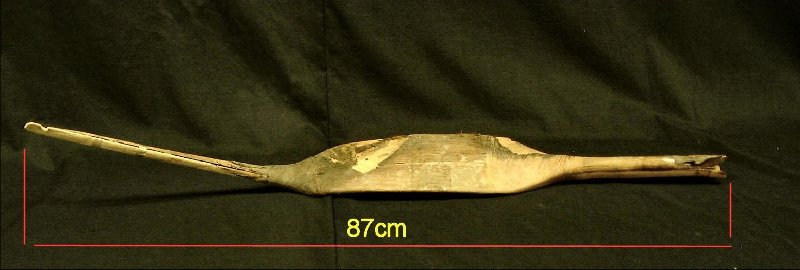
The half bow, oblique back view in natural lighting. The break
is at the 'right-side' grip/limb junction.

Back view. Bone limb reinforcement present on one side only. A
triangle of silk adheres to the top of the limb.

X-ray through back of the bow. (Composite of three.)

Close-up of the back of the limb. A piece of adhesive tape
lies vertically across it. The top right edge may have been scorched.

Side view of the grip, limb and siyah with surface
measurements.

X-ray through grip, limb and siyah

Detail of sinew reinforcement at limb/grip junction and bone
plates reinforcing side and belly of grip.
(The profile of the back of the grip is formed with sinew.)

X-ray through the limb/grip junction.
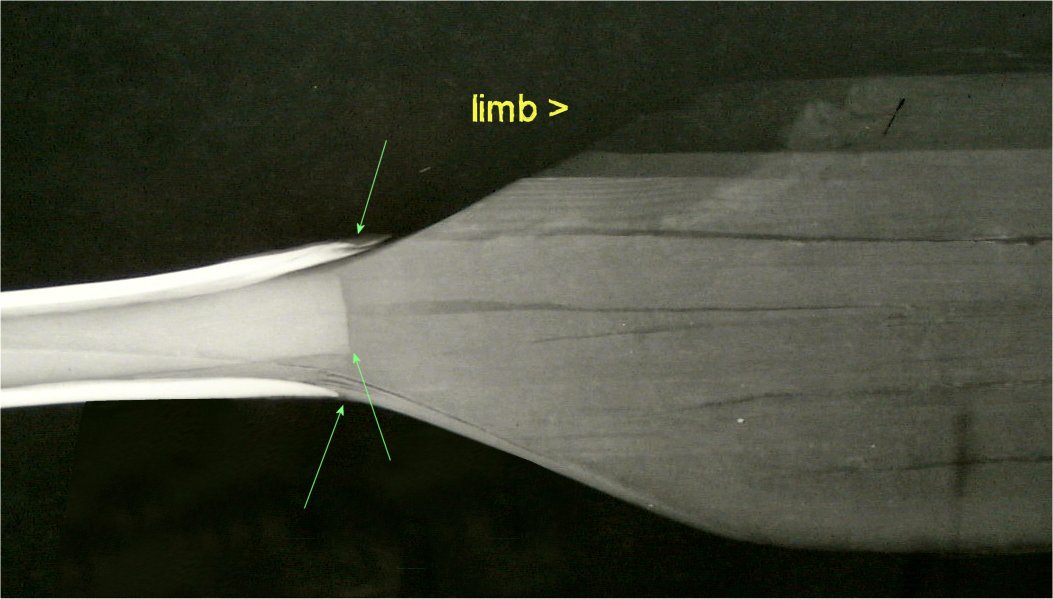
X-ray through grip/limb transition

The belly of the limb, formed of five horn plates over wood.
(Adhesive tape across the middle.) Lowest plate is missing.

X-ray through siyah/limb transition from back. Sinew
(see picture below) hides additional bone reinforcements .

Detail of siyah/limb transition with sinew reinforcement.
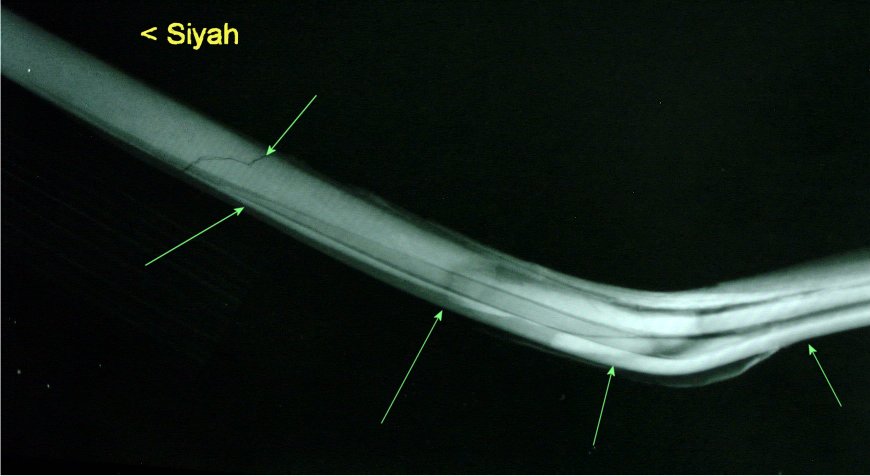
X-ray through siyah/limb transition from side shows up an
extension of horn along the belly of the siyah.

The bow viewed from the tip looking towards the grip

Looking from the grip to the siyah

The bone reinforcement to the tip/siyah. I surmise that the
extent of the wooden core was originally the same as the bone reinforcement.

This photograph provides clues to the construction of the
grip/limb transition.
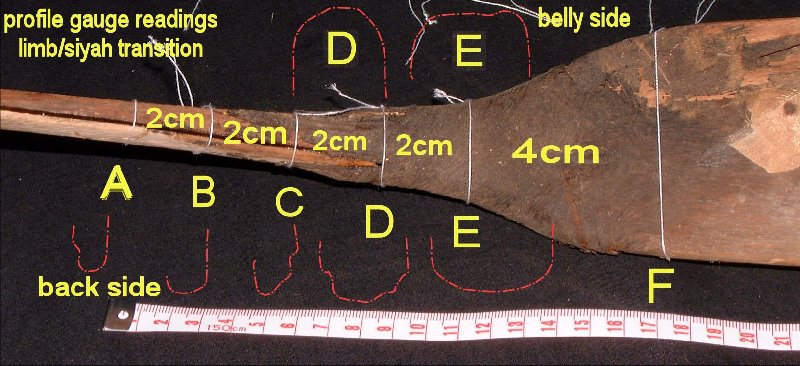
Cotton thread tied at measured intervals, with contour
gauge readings from the back (and belly at D, E.)

X-ray through grip from the back shows splice of limb/grip and
interstitial wood insert in the grip.

What remains of the original string.

The loop seems to have been formed like a modern bow string and
then wrapped in the skin of a small, furry animal.

Six original self wooden arrows. But the points have all been
snapped off before burial.
Arrow Measurements
| Length(cm) | Max. diameter(cm) | Min. Diameter(cm) |
| 80.4 | 0.995 | 0.770 |
| 74.4 | 0.910 | 0.610 |
| 60.6 | 0.910 | 0.605 |
| 76.8 | 0.910 | 0.605 |
| 75.8 | 0.910 | 0.605 |
| 61.0 | 0.895 | 0.715 |
| 78.4 | 0.905 | 0.710 |

Self-wood bulbous nock. Painted, but no sign of reinforcement
or inserts.

Here, I use computer magic to repair the bow and supply dimensions. This
exercise assumes symmetry around two axes.
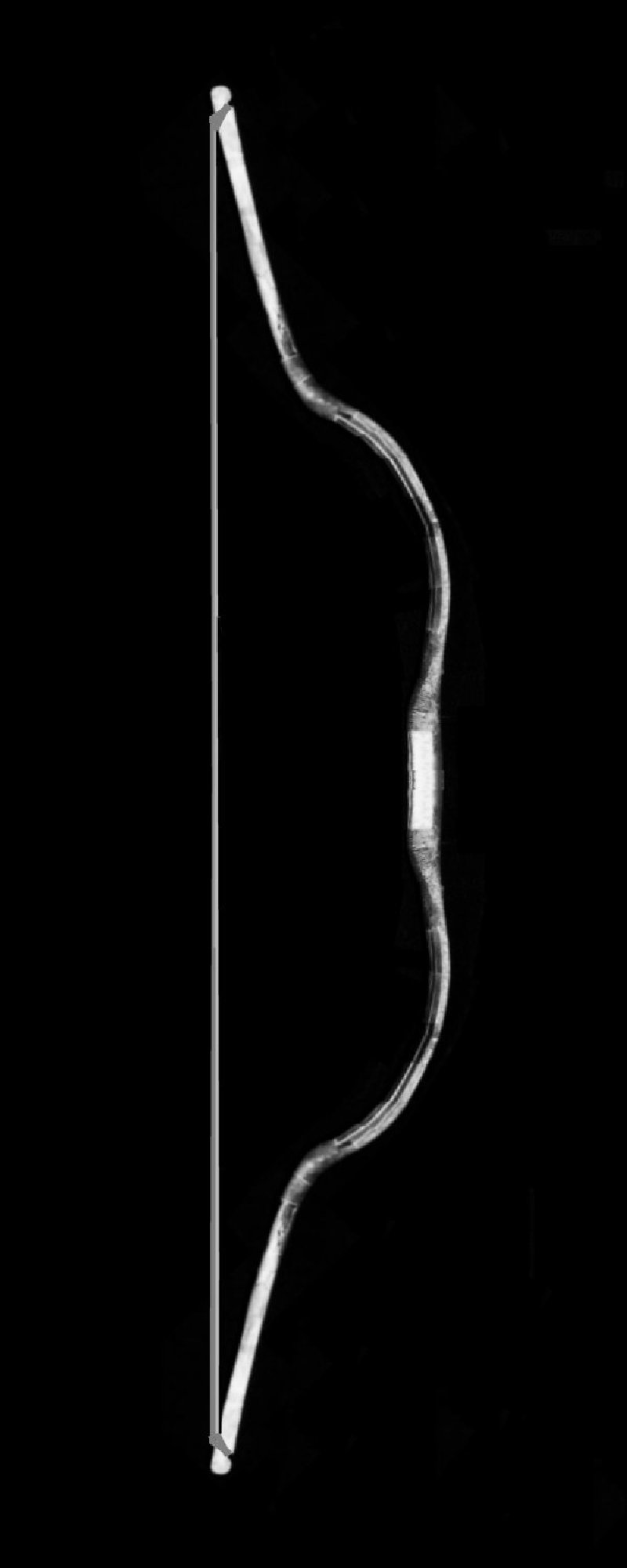
More computer magic: ready to shoot!
Archaeological and historical background of the Khotan bows.
A bow of identical design to the one I have just described was excavated at Niya on 11 October 1995. A coffin containing four male mummies and two bows was exhumed unopened and then examined in relatively ideal laboratory conditions in Urumqi in the following months. The description of the contents of the coffin from grave #4 at cemetery #95 at Niya was published in "Xinjiang Wenwu" ('Xinjiang Cultural Relics') Issue No. 2 of 1999, p. 27. There is some further comment in Wang Binghua (with Victor H. Mair), "The Ancient Corpses of Xinjiang", Xinjiang People's Press, 2002. ISBN 7-228-05161-0. Further background information (in Chinese) and illustrations is provided in Liu Wei: "Chinese Civilization in a New Light" Vol. 4. Commercial Press, Hong Kong, 2001. ISBN 962-07-5307-0.
The Niya site corresponds geographically to the location of a culture which occupied the Niya area throughout the Eastern Han and Western Jin periods, around 200-350CE. Situated in the remote desert, Niya was once irrigated by the Niya river, fed by the melting snows of the Kunlun Mountains.
In Chinese literature, the people occupying that region in those times were known as the 'Jingjue' (精絕). The 'Official History of the Han: Record of the Western Regions' (漢書西域傳) records that the Jingjue were one of 36 large and small vassal states in the West of the Empire. 480 households with a total population of over 3,000 people were recorded. Their armed forces amounted to 500 men. The Han government posted four officials there for administrative purposes. An invasion of the region by the Tuguhun in the fifth century caused economic disruption. Water supply to the Niya river was cut of and the desert encroached. (Archaeological surveys by Aurel Stein in the 19th Century and surveys by Chinese and Japanese archaeologists since the 1950s suggest, however, that the area was abandoned over a rather short period, with many valuable items left scattered.) By the time that the Tang monk-explorer Xuanzhang passed the site in the 7th Century, it was already a ruin.
The mummified remains from Cemetery #95 generally display non-Chinese racial characteristics, with light brown or blond hair and high, aquiline noses. Men were around 1.65 meters tall. They lived in a prosperous community which enjoyed the best luxury products from both East and West. Foods preserved in graves show that their diet was mainly mutton, grains and dried fruits (in fact, much the same as present-day inhabitants of the region.) Particularly striking (partly because their spectacular state of preservation) are the embroidered cloths in silk and wool that the mummies are buried in. The people were literate. In common with other cultures in the region at that time, they kept civil records in the Kharoşţh-ī-Prakrit script, that originated in Northern India.
Several of the deceased at Niya had died violently. Males were buried together with grave goods which in most cases included a bow, bow-case, quiver and arrows. Bows were clearly standard, emblematic burial items for males. Most of the bows were composite bows such as the one described here; but simple wood self bows about 1.5m long were also found. Arrows were self wood barreled and either had blunt wooden points, or else had had metal arrowheads removed before burial. Women were buried with make-up kits and items related to sewing and weaving. Where coffins were placed above previous burials, the previous burials were sometimes burned.
Coffin #4 from cemetery #95 also contained a piece of brocade with a vivid design of mounted archers using bows that were consistent with the design of the bow described here. Another mummy discovered nearby had a brocade bracer on his arm, embroidered with the Chinese text "Five stars appear in the East: the Central States will benefit and the Southern Qiang will be punished." This brocade may be a gift from the Chinese court to minority tribes who helped the Chinese to suppress incursions from the Southern Qiang (Tibetans.)

A piece of brocade with a vivid design of mounted
archers using bows consistent with the design of the bow described here.
(Based on an illustration in Xinjiang Wenwu"
('Xinjiang Cultural Relics') Issue No. 2 of 1999.)
You may copy and make non-commercial use of this drawing.
Commentary
Feeling a sense of déja-vu? Open 'The Traditional Bowyer's Bible', Vol. 3 at page 82. Look at Tim Baker's suggestion for a theoretical design for maximized performance of a composite bow. Someone got around to trying out his design... 1,700 years ago.
In this bow design, the working limbs amount to little more than spring-leaf hinges. From the X-rays, we can see that the bow needed careful reinforcement at the edges of regions where the working sections and non-working sections are spliced. We also see that the central horn plate of the belly extends half-way up the siyah. As far as can be ascertained, the wooden core consists of two pieces of wood, each carved in one piece from the tip to the grip, with a short interstitial piece of wood between them.
While Tim Baker anticipates the short, rectangular working limb, he does not anticipate the spoon-shaped hollowing of the limbs (which is corroborated by the Gansu bow.) Without actually constructing this bow, it is difficult to understand the purpose of such a feature. Personally, I could imagine the hollow-profile limb giving rises to enormous stresses at the edges. What happened in reality?
One element of the design helps to deal with a problem that we observed in the area where these bows were made: there is little prospect of obtaining long sections of good, consistent horn and the principal woods are light and lack hardness and sappiness. The short working limb permits the use of short plates of horn. The addition of slivers of bone (horse or camel) as reinforcement allows construction of very light but strong non-working sections. I would go as far as to say that this bow is principally constructed of bone, horn and sinew: the role of the wood core in the construction is limited to a scaffolding to facilitate the assembly of the other materials.
For a further interactive discussion of this bow, please look for the new discussion topic on ATARNet.
(Follow-up discussion up to 21 July 2002 can be seen here.)
November 2002

'Monkey
King'
I have wanted to learn the pellet bow for some time. I find it a
particularly difficult technique: you extend the arm and draw the string (a
double string with a cup to hold the pellet) back to the eye. Then just before
release, you must torque your bow-hand sharply outwards from the line of the
shot so that the pellet will not hit the grip. Doing that while maintaining
accuracy is beyond me at present. Will anyone who has experience in shooting
with pellet bows write to me (or better still, post on ATARNet) with some tips?
|
|
|
One highlight of my visit to Peking was to meet with the General
Secretary of the Chinese Archery Association, Mr Zhou Yuan. The Chinese Archery
Association is presently entirely concerned with the promotion and regulation of
FITA-rules archery in China.
However, Mr Zhou has shown keen support for research in traditional
archery – both that of the Han Chinese people and of the Chinese national
minorities such as the Tibetans, Mongolians, Xibe and Ewenki. Accordingly, the
Association will establish a "Committee for National Archery" under
its auspices. The Committee has invited me to arrange a series of 'train the
trainer' sessions in Chinese traditional archery. The sessions have been
supported by a grant from the Rotary Club of Hong Kong North, who have sponsored
the purchase of 30 bows in modern, man-made materials, suitable for initial
teaching for beginners. (I believe that initial teaching needs to start with
fiberglass bows. Once people have mastered the correct basic technique, they are
free to order horn bows from craftsmen in China and elsewhere.)
Our first training session will, appropriately, take place in December
in Qufu, the birthplace of Confucius. (Did you know that he was an archery
instructor?) The second will take place in the Spring in Nanning City, Guizhou
Province.
I am also discussing starting a training course in Chinese archery (two
hours on Sundays over ten weeks) in Hong Kong, starting in January 2003.
Csaba Grozer wrote to me asking if he could tell ATARN Members of some
new developments in his manufacture of traditional-style bows. I am passing
on Csaba's information because
I know many Members are interested in his bows; but ATARN is not an endorser
and we do not receive any payment from Csaba. I will always welcome and
publish commercial information that will be of interest to ATARN members.
OLD SCYTHIAN BOW
This bow is small and inexpensive, but it can be drawn up to 31", and
it's
fast.
HUNGARIAN BOW OF THE MIDDLE AGES
It's a great feeling to draw this bow. The string feels tight, and pulled
past a certain point it feels like it has a give to it. The bow can be drawn
up to 36" without any problem, but it also works at 28". This bow
is very
fast.
This bow is made with a special lamination technique, from special
components. On account of the special materials used, this Hungarian bow
looks like a composite Hungarian bow. It has a "C" shape when it
is
unstrung. It absorbs vibrations very well.
HUNGARIAN BOW DECORATED "A"
This bow has already existed. I made a little change in this bow.
"TRH" LAMINATED TURKISH BOW
This bow is made with a special lamination technique, from special
components. (They are neither glass or carbon fibers, nor polyester or
epoxyte.) The outer layer is a tendon-like material, and the inner layer is
a
horn-like synthetic material. On account of these materials, the bow is easy
(soft), and very fast at the same time. It has a long draw-length
(34"), and
an excellent ability to absorb vibrations.
In the 'Commercial' section of
ATARN, I'd like to advertise raw
materials for making traditional horn bows - particularly water buffalo horn,
glue and sinew. Questions about sources of supply continually get posted on
ATARNet. If you are a supplier, would you send me some advertising copy? I don't
plan to make a charge; but of course, any contribution to ATARN would be
welcome.
By
Bede Dwyer
Introduction.
This is written to give a historical context to
the information that Stephen Selby brought back from the museum in Urumqi on
some ancient bows. They have not been widely published in Chinese or English,
but they are very significant for the study of archery history.
Stephen supplied me with the descriptions, but my imagination supplied
the reconstructions. I also redrew his sketches so any errors are mine.
The
Location
Shanshan County, to the east of Urumqi, is on
the Northern Route of the Silk Road, which splits in two to pass the extremely
arid Takla Makan Desert. To the East is the Gobi Desert; to the west is the
Tarim Basin, which drains the mountains to the north. Its watercourses
eventually evaporate in the Takla Makan. Subeshi (Subeixi) is situated to the
east of the famous Silk Road town of Turpan (Turfan). Since early exploitation
by foreign archaeologists in the nineteenth and early twentieth century, the
area has continued to reveal amazing relicts of the past. Modern Chinese
archaeologists have revealed more details of the ancient inhabitants and their
ways of life. The unique dry conditions have preserved usually perishable artifacts
and even the bodies of some of the people buried there.
What have surprised many in the West were the
European features of some of the bodies. However, ancient Chinese historians had
recorded the variety of races on their northwestern border as far back as the
Han Dynasty. This area was both a trade route and the point of contact many
people from different environments and cultures. People farmed and traded in the
oases and nomads visited both for trade and warfare.
The Artifacts
Stephen Selby examined several bows in Urumqi
that were of various designs and from several periods. One type of great
significance to the history of archery was very similar to bows familiar in the
West from Greek, Persian and Scythian [i]
art. I will discuss why this is not so surprising below, but firstly I will
describe one of the bows.
The bow in question possessed a feature that is
no longer common in modern composite bows. It was thick and narrow in the
cross-section of that part of the limb where it bends. Unlike later bows, with
their broad lenticular or rectangular bending sections, this bow had a
triangular section with the apex on the belly side of the limb. The back of the
bow was slightly convex and formed the base of the triangle. At the centre of
the bow, the limbs are 4 cm wide. For a greater part of the limb it had this
unusual shape.

Figure 1
Cross-section of centre area of bow.
Another feature that was rare in more recent
traditional composite bows was that the tips were smoothly recurved. The
recurves had string grooves on their belly sides like modern target recurve
bows. The cross-section of the recurve was more like a slightly flattened oval.
For part of this there is a groove on one side as just mentioned. This feature
is totally unlike the bow tips on later composite bows. The term we use for bow
tips, “siyah”, is not really appropriate [ii].

Figure 2
Cross-section of recurve.
In outline, the bow looks like the Classical
Cupid’s bow of Greek and Roman art. This is not an accident. Despite being
found in the modern confines of China, this bow represents a survival of the
ancient Scythian bow, which was used from Italy in the west to the north of
China in the east. Roman armies might have carried them even further west.
Remains of later Roman archery equipment have been found in Britain, both grip
scales and laths for the ears. However, the Scythian bow would leave no telltale
laths in the archaeological records. Even in the heartland of the Scythians,
modern Russia and the Ukraine, very few identifiable remains of bows remain.

Figure 3
Subeshi Bow and Sections (Not to scale)
Stephen viewed several bows in the Museum in
Urumqi. Two in particular recall Scythian bows of the West. Both were displayed
with bowstrings and arrows of about the right length [iii],
though they may not have originally associated with these particular bows.
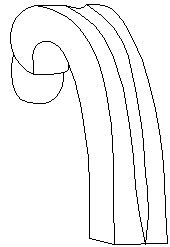
Figure 4
Simplified drawing of bow tip from belly side showing string groove
Stephen measured one bow and found that it
measured about 130 cm around the curves and 119 cm in a straight line from one
end to the other. The centre of the set back grips is 53 cm from on end and 66
cm from the other. This is a straight-line measurement. The centre of the bow
was 4 cm wide and tapered to 3.5 cm at the mid-limb. The limbs were bound with
thread [iv]
below a layer of lacquer. If the materials are really silk and Chinese lacquer,
then the use of these materials clearly suggests Chinese craftsmanship. Silk
wrapped and lacquered bows have been excavated in Warring States and Han tombs [v].
However, the bow was found in a cemetery primarily containing people of
European features [vi].
Whether the bow was finished or recovered by a Chinese artisan or complete
constructed by one is hard to say at the moment. However, Stephen advised me
that the thread could not be identified under the layer of lacquer and the
nature of the lacquer itself has not been determined yet. The bow is dated
approximately 600 BCE, but may be later. The Scythians were prominent in the
West between 750 BCE and 300 BCE. After that time they went into decline though
enclaves survived into the current era in the Crimean peninsula.
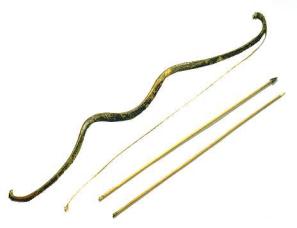
Figure 5
A Scythian style bow from Subeshi in Shanshan County, Xinjiang

Figure 6
A sketch of how a bow may have appeared strung and drawn
The sketch of the drawn bow is tentative and
almost certainly incorrect in detail. The bow would have had a greater bend
closer to the handle than I have drawn. However, the degree of this will need to
be determined by experiment. Scythian artwork often shows the parts of the limbs
I have crosshatched horizontally bent almost parallel to the arrow, as in a
Korean bow. Stephen’s
measurements of the bow indicate the stiffness of the bow was varied by reducing
the width rather than by changing the shape of cross-section. Judging by the
sections at the recurves, they may have been flexible enough to straighten out
partly at full draw. However, in art, the representations usually show a
prominent recurve at the tips when the bows are fully drawn.

Figure 7
A Western Scythian style bow reconstruction by David Betteridge
At least one of these bows was buried in a
combined bow case and quiver that the Greeks called a “gorytos” (γωρυτός
written gorytus in Latin). This piece of equipment was common from Scythia and
Greece in the West to Siberia in the East. Although there were obvious
variations between the Eastern and Western version of this equipment, they
shared a number of key features.
The quiver was attached to the outside face of
the bow case when the bow was pointing backwards.
About two-thirds of the bow was inside the case.
The arrows are usually slightly shorter than the
case, although the quiver portion of the gorytos can be shorter than the whole.
The main decoration of the gorytos is on its
outside face, the side to which the quiver is attached.
The bowstring was uppermost when the bow was in
the case unlike later bow cases for the strung bow.

Figure 8
Drawing of a gorytos of the Eastern type
It is worth mentioning too that there are many
indications that a soft leather or cloth cover could be slipped over the upper
end of the bow to protect it from the weather. This would cover the top part of
the gorytos down to the suspension point. It is clearly shown on the Persepolis
reliefs and in many Greek vase depictions.
The leather tab on the bow case part of the
Urumqi Museum gorytos may represent another way the gorytos could be worn. If a
strap ran from the upper edge suspension point of the gorytos to the hole in the
tab, the strap could be slung over the left shoulder. This should make the
gorytos hang diagonally across the back and position the openings of both bow
case and quiver next to the right shoulder. This is pure speculation.
The Origin of the Scythians.
Warlike horse nomads are first mentioned in the West in
Assyrian documents in the eighth century BCE. These Cimmerians were eventually
over thrown by the tribes the Greeks called Scythians. They raided extensively
in the Near East and eventually allied with the Medes of western Iran to destroy
the Assyrian kingdom. According to the ancient historian, Herodotus [ix],
the Medes then murdered the Scythian leaders at a banquet and drove their forces
out of the Middle East. The Scythians retreated to the Pontic steppe through the
Caucasus. Reading the account of Herodotus, you might be excused for imagining
that the Scythians were a group of longhaired, bearded barbarians of a violent
and emotional nature, who drank the blood of their enemies and were addicted to
cannabis-laced sweat baths. However, there is much more to them than that.
The first nomads of the steppe north of the Black Sea
mentioned in the ancient historians were the Cimmerians who seem to have
originated in that area. They were early nomadic pastoralists who adopted a
stock raising, wandering lifestyle as an alternative to mixed farming. The
Scythians appeared from the east and started driving the Cimmerians before them.
The Cimmerians raided south through the passes of the Caucasus and ravaged
Anatolia. Some scholars believe that the Scythians originated in southern
Kazakhstan [x].
Therefore Scythian-style culture could have radiated east and west from a common
centre.
The Scythians were predominantly horse archers. Because
of the vast area they dominated, archaeological evidence for them is
geographically dispersed. So much so, that it would be difficult to prove racial
or linguistic uniformity, even though we can see lifestyle and artistic
continuities between these sites.
At one end of the geographical range, gold vessels
provide illustrations of the horse gear and equipment used, while at the other
end frozen tombs provide actual saddles, bridles and the corpses of horses.
Herodotus wrote about their daily life and, until the discoveries at Pazyryk in
the Altai Mountains, he was generally believed to be unreliable about the
Scythians. However, many strange details of his narrative have proved to be
true, such as hemp-enriched steam baths and the habit of scalping their enemies.
The Scythians and people in Scythian dress were widely
depicted in Ancient Greek art. The Achaemenid Persians [xi]
included eastern Scythians (the Sakas) among the tribute bearers in the
bas-reliefs at Persepolis [xii].
The bows discovered in Xinjiang are as important to the study of archery as the
frozen tombs in Pazyryk were to the general studies of the Scythians. Until
these discoveries were made, only fragments of Scythian bows and representations
could be studied. Of archery equipment, only metal fittings for the gorytos, a
combined bow case and quiver, arrowheads and a few parts of arrows survived. (I
have not included any illustrations of the typical Scythian three-bladed, bronze
arrow heads here because I do not know if any have been found in association
with these bows.)
The typical Scythian warrior was a horseman who used
archery as his prime offensive weapon. On his left side he wore a gorytos. The
arrows were typically tipped with two or three-sided bronze arrowheads. At the
western end of the steppe the arrows that survived were usually between 55 and
60 cm long [xiii]. At Pazyryk, however,
broken arrows were reassembled to suggest a length of 80 cm. From western steppe
tombs, large gold plates were excavated which were evidently the covers of the
outside faces for the wood and leather gorytoi. In art, the gorytos was usually
two-thirds to three-quarters the strung length of the bow. The gorytos plates
for which I have measurements are about 45 cm long. The whole gorytos was
probably about 55 to 60 cm long, making it about the length of the arrows found
in the same area.
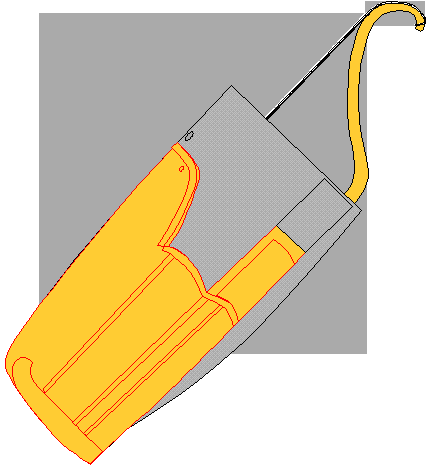
Figure 9
Simplified view of a Western Scythian Gorytos.
Another characteristic feature of the Scythians was
that they used an early form of saddle. This basic saddle consisted of two
quilted, stuffed cushions sewn to a cover with a gap down the centre between
them. Each cushion was reinforced and decorated on its front and rear faces.
This helped keep the front and rear of the saddle higher than the middle. A
strap was attached at the front and another at the rear of the cushions to
reinforce them and cover wooden spacers than kept the cushions apart. A third
strap went over the centre of the saddle and it was used to attach the girth and
the breast strap. There were no stirrups and no rigid tree to hold the shape of
the saddle. However, it was a great improvement of the basic saddle blanket,
which had been its predecessor. A felt pad was sewn underneath it and it was
usually covered with a decorative saddle cover.
These saddles are depicted in Scythian gold and silver
work from Russia and the Ukraine, in Siberian gold buckles, and on the pottery
horses of Qin Shihuangdi’s cavalry. Real examples were found frozen in the
tombs of Pazyryk [xiv] and a dried-out saddle [xv] near the burials of our
bows and gorytoi.
The Medes and some Persians are shown in the Persepolis
reliefs wearing gorytoi that are longer than those of Saka tribesmen in the same
group of reliefs. In both cases, there is a cover over the projecting part of
the bow, so details of its shape other than its profile are impossible to see.
The exception is that there is some detail of the recurvature of the bow because
the bow was strung and carried belly-up. The soft cover of the bow shows a
rounded profile. In the same group of reliefs other Persian soldiers are shown
using a longer bow without a setback handle. They carry a large shoulder quiver
instead of the gorytos.
In the collection of the Urumqi museum there are bows,
arrows and gorytoi of the longer eastern type, but obviously related to the
western Scythian equipment. Some features of the gorytos are similar to one
depicted in an architectural decoration in the old Parthian capital of Nysa in
Central Asia. Of particular interest is the use of multiple pockets for the
arrows on the outside face of the gorytos.
Some of the gold gorytos plates from Russia have
surviving bases in the form of an elongated teardrop with the narrow end facing
upwards. There is usually a ridge down the centre of the base showing the
separation of the bow case and quiver sides of the gorytos. The gorytos in the
Urumqi museum [xvi] has only a supporting
wooden rod rather than the two- or three-sided wooden frame implied by the
shapes of gorytoi in Greek and Scythian art and the gold plates with their
bases. The Nysa gorytos looks more like the Urumqi example because it has a
rounded base rather than the flat one of the Western types. This is also true of
the gorytoi on the Persepolis bas-reliefs.
The Scythian Bow.
There is a complex of weapons associated with the
Scythian lifestyle. They include the bow, arrows and gorytos. In the West the
arrows almost always had socketed, three-bladed heads and were made of bronze [xvii].
There is also a short sword called by the Greeks, an akinakes, which was worn on
the right side with the chape of the scabbard sometimes tied down to the right
thigh. Another common weapon is a narrow-bladed battle-axe with some resemblance
to the Chinese dagger-axe (ge) and ancient Near Eastern weapons. Spears and
javelins are also common in tombs. Increasingly discoveries in Eastern Europe
are adding weapons and armour to this catalogue. The use of scale armour is much
more prominent than once thought and long two-edged swords are also more
frequent.
The shortness of the bow is
an obvious convenience. Though much is made about the usefulness of short bows
on horseback, the early horse archers depicted from Assyria have medium-sized
triangular composite bows, which they drew to the right shoulder. The Qing
dynasty Manchus and the Japanese, used quite long bows and long arrows in the
last period of military horse archery. So the convenience of a short bow could
easily be overridden by other factors such as the ability to deliver a large
heavy arrow. The Assyrians moreover did not even have the advantage of the basic
saddle of the Scythians, but instead used a saddlecloth. However, the gorytos
did enable easier mounting without stirrups. It is always shown with the bow
pointing backwards when it is in use. Another feature of the short bow in the
West is the large number of arrows carried in the gorytos. The tiny bronze
arrowheads are found in numbers above fifty with the remains of gorytoi in the
Ukraine.
The recurved tips are a new
development in archery at the time, though you can see that they had ancestors.
The Assyrians and Elamites used triangular composite bows with bird’s head
shaped nocks for the strings. Since the string loop had to attach to the
bird’s beak on the back of the bow some form of basic groove was probably
carved in the tip of the bow to lead the string over. Prior to that narrowing
the tip of the bow abruptly to make two shoulders formed the string nock. On
some Ancient Egyptian bows this was carried to the extreme of having the nocks
of the bows carved into representations of Pharaoh’s enemies, their shoulders
the shoulders of the nock, their head the peg-like nock itself. Every time the
king drew his bow he strangled two of his enemies in effigy [xviii].
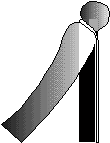
Figure 10
View of an Ancient Egyptian bow tip

Figure 11
View of a late Assyrian bow tip.

Figure 12
View of the tip of a bow from the Achaemenid palace at Susa.

Figure 13
View of the tip of the bow from the Urumqi Museum
Set back centre sections have
been used in many places at many times, but before the introduction of the
Scythian bow, they were usually the characteristic of a bow that was under
braced. They were used to increase the bow’s power stroke on the arrow by
bringing the belly of the handgrip closer to the string. Under braced self-bows
were designed to reduce the stress on the braced bow, prolonging its life. In
the Scythian bow, they were probably introduced to shorten the draw, while still
maintaining an optimum amount of limb bending. Then
you could carry more but shorter arrows and still get good performance out of
your bow. Another effect was to increase the physical
length of the bows while retaining a short “strung’ length.

Figure 14
Cross-section based on parts of a Scythian bow from
the Three Brothers Kurgan and fragments from Sivush.
The fragments of a western
Scythian bow from the Three Brothers Kurgan [xix]
have a circular cross-section of three layers wrapped in birch bark. Other
fragments of bows are similar [xx].
This is consistent with a derivation from the ancient Near Eastern bows. Most of
the bows from Tut‘ankhamūn’s tomb are much thicker compared to their
width than we would now make a bow. While they have some reflex [xxi]
in their unbraced state, they have nothing like the reflex seen in later
composite bows. The various Greek representations of Scythians and Greeks
bracing their bows show positions that would not work with bows that are very
reflexed.
The Egyptians had separate
bow cases for their bows mounted on their chariots, but the Assyrians just
stuffed them into their quivers. In both areas, the quiver was worn on the back
when it was not attached directly to the chariot. At some stage, someone decided that a bow case attached to a
quiver would be a good idea. With the small Scythian bow and arrows, the
resulting object was not too unwieldy. The advantages were obvious: the bow was
protected from the weather and the points of the arrows.
The case also prevented the bow from being distorted, yet it was ready to
hand already strung. Drawing short arrows across the body was no great trouble
(the Plains Indians in America, when they reinvented mounted archery did a
similar thing). However, that brings us back to the Urumqi bows. Their arrows
were not short and there is some evidence that even in the West these larger
Scythian bows were in use [xxii].
The Urumqi gorytoi [xxiii]
are almost a metre long (90 cm) and the arrows are about 80 cm long. So too were
the arrows from Pazyryk. The Siberian gold belt plaques show people drawing to
the ear. Perhaps they were nearing the outer edge of utility for a gorytos.
Coupled with this large size, these gorytoi do not seem to hold as many arrows
as the smaller Western ones. This could mean that the archers needed fewer
because their larger arrows were more effective. It could also mean these were
hunting quivers and they did not have to carry many arrows. The arrows had a
mixture of wooden, horn and metal tips.
The Scythians at War.
The Scythians were primarily cavalry fighters. They
rode into battle and fought on horseback. Herodotus describes their tactics when
fighting the Persian army led by Darius the Great. They used traditional
scorched earth tactics and retreated before the large Persian army, successive
leading the Persians through each of their subject states so that their own
lands were not ravaged. After various taunts directed at the Persians, they
informed Darius that they would stand and fight if the tombs of their ancestors
were desecrated. This was the last straw for the Great King [xxiv],
who turned around and went home. Scythian horse archers had consistently
prevented the Persian army from foraging and had left Darius little choice.
This was a tale of frustration from the Persian point
of view. The Scythians effectively contained the largest army of the Middle East
and actually used it to do their own dirty work by punishing their less
enthusiastic allies. Lest we underestimate the Persians, remember that they
transported this large army from Persia through Anatolia, across the Bosphorus
on a bridge of boats, through Thrace and onto the steppe lands of Eurasia. The
logistical skills, with which they consistently underpinned their great military
expeditions, are really remarkable. However, they were outmanoeuvred by the
Scythians and confined by their swarms of horse archers.
Against a smaller army, the Scythians could be much
more aggressive and use their weapons more directly. In later years, they were a
thorn in the side for Macedonia and it took Alexander the Great to defeat their
king, Ateas. This combination of effective archery and speed of manoeuvre led to
an arms race on the steppe. Armour became popular and the Scythians themselves
eventually became victims of their more heavily armoured relatives, the
Sarmatians [xxv].
These bows are significant for two separate reasons.
They provide use with examples of how an early type of bow looked and will
eventually help us learn how it was constructed. They also show us how
widespread the Scythian steppe culture was and how the Chinese were able to
absorb some of its technical innovation. If I have spent so much time on the
Scythians, it is because this archery evidence of their presence so far east is
remarkable and it shows that the great civilisations of the world were not as
isolated from each other as we often think.
Some Questions.
There are several questions raised by these bows and
their associated equipment.
·
How were they shot? What technique was used to
draw the bow?
·
How were they constructed? What materials were
used?
·
How effective were they? How did they perform?
·
Who made them and did they influence other bows?
·
What is the relationship between the people who
were buried with these bows and the various groups living a “Scythian”
lifestyle?
Various theories have been advanced about how the
Scythians in the West shot their bows. My opinion is that the most likely is a
variation of the Mediterranean release called the Flemish release where the
index and middle fingers draw the string with the nock of the arrow between
them. I think that the existence of armguards (bracers) in some later tombs in
the area supports this view. The Western bows were so short that this grip was
necessary. Some authors have suggested a Primary Release or a Secondary Release
could have been used, but the primary release is not very strong and the
secondary is clumsy with a very short bow.
However, the bows in Xinjiang are 50% larger and not so
restrictive on the position of the fingers. In fact, there are several features
of them that generate other problems when shooting. The centre section of the
bow is 4 cm wide and would be quite a handful for most people. The
archaeological evidence suggests that the people in the cemeteries were quite
large [xxvi]
and perhaps were not inconvenienced but the large cross-section of the bow.
Unfortunately, there are no X-Rays of these bows yet
and we do not know their construction. The majority of bows seen by Stephen were
in such good condition that their internal construction is undetectable. The odd
triangular cross-section of the bow in its central parts may reflect the shape
of the horn available [xxvii]
or it might be something else entirely. There is always the possibility that the
bows are meant as grave goods only, merely full sized models of weapons. In that
case we are only looking at the form of the original. Some comments [xxviii]
can be made however. The complex shape of these bows is not likely to be
accidental or the result of parallel evolution of designs.
The most likely construction is a horn-wood-sinew
composite. The cross-section of the bow would put very high stresses on the
belly of the bow. Even with the reduction of reflex that Betteridge advances in
an upcoming paper, composite structure is about the only way to make this bow
work effectively. Of course modern bowyers could combine diverse technologies to
achieve a workable bow, but these were not available to the dwellers of Central
Asian oases before the current era.
The binding of the bow would make a major contribution
to its strength. The many changes of curvature increase the risk of the
laminations of the bow separating from each other. In modern Mongolia, some bows
are bound from end to end with transparent thread like fishing line to prevent
de-lamination. In was common in later periods to bind points of high stress with
sinew in glue as with the section of the much later bow Stephen brought back
from Xinjiang. Other resins aside from Chinese lacquer could have been used to
waterproof and protect the sinew. We will not know until one of these bows is
subjected to much more intense study.
Another part of Betteridge’s analysis implies good
performance for this shaped bow. Historical evidence mentioned above also
supports the contention that the Scythian style of bow was effective in hunting
and war. Several people already have made reproductions of Scythian bows, but as
more material is published on the Xinjiang bows, their next bows will be more
useful for estimating the range and efficiency of these ancient bows. It is up
to the bowyers to expand our knowledge in this area and I do not doubt that they
can.
I think it is likely that the bows were made locally,
but the future studies of the artefacts themselves could reverse this view.
Perhaps the materials were imported in part. Maybe Chinese craftsmen applied
lacquer and binding to previously built bows to increase their durability. At
the moment, there is just not enough evidence.
If the local people made the bows, it is likely they
represent the eastern extension of the Scythian lifestyle. However, whether this
supposition is true or the people in this area simply used bows copied from
their more nomadic neighbours is a question that requires further research. If I
use a Turkish bow, it neither makes me a Turk nor proves that I am influenced by
Turkish culture in general. I might think it is a good bow and I might even
learn to make my own.
These bows’ influence on the construction other bows
depends on their exact dating. A bronze model crossbow from the tomb of Qin
Shihuangdi [xxix] has a setback centre
like these Scythian style bows, but was it the result of influence or
convergence? It did not have recurved ends. Later bows were made with setback
handles for many centuries. However, the recurved ends of the bow were lost in
the Old World of Europe, Asia and Africa until American bowyers reintroduced
them in the 20th century. The closest bow in appearance is the Korean
composite bow, but that has a long history of its own. The extreme reflex of the
Korean bow and its entirely different cross-sections rule out much historical
connection. Though many elements of steppe culture entered the Korean peninsula
and were absorbed by the local culture, it is unlikely that this bow is
responsible for later developments in Korean archery, which probably has more to
do with native traditions combined with Ming Chinese influence.
Conclusion.
The presence of Scythian-style equipment in a cemetery
on the frontier of China is not surprising in itself. The presence of the
mummified remains of people with Western features in the area is now well known.
What is exciting from the point of view of archery is that a group of complete
early bows has been preserved. The burials in various graveyards in the
immediate area contain a range of archery equipment from various times. Because
of the widespread Scythian nomadic culture, its interaction with the various
large states on the periphery of the Eurasian steppe is significant not just for
what it says about the Scythians and their relatives. The states on the borders
of the nomadic world reacted to the threat and the military technology of their
warlike neighbours. These reactions both provide insight into the nomads and
their settled neighbours.
While the bows themselves are clearly in the orbit of
Scythian culture, if the finish is lacquer and binding, then it is closely
related the Chinese technology. In Pazyryk, the same mix of influences is
visible. Chinese mirrors and fabrics are combined in tombs with Scythian
animal-style artefacts and Near Eastern carpets. We do not know all the answers
now, but discoveries like this by archaeologists are helping us learn more. At
this stage of the investigation of the early inhabitants of Shanshan County, we
cannot be sure whether all the people buried in these cemeteries were locals or
travellers who died there. Even the dates are not precise yet. No one can
predict what will be found next in China, Siberia or Russia. Nor do we yet know
what will be discovered when more research is carried out on these amazing
artefacts.
Archery was bound up with the everyday lives of many
ancient cultures and in these bows we can see a technological bridge between the
East and the West. The Scythians and the Saka and their various relatives and
imitators represent the first major exponents of mounted pastoralism known from
history. It is entirely appropriate that their choice in bows should be so
distinctive and innovative.
Acknowledgements.
I would like to thank Stephen Selby for letting me
examine the photographs of the bows and who originally found the book from
Xinjiang mentioned below for me. David Betteridge and I have long discussed the
development of ancient composite bows and he had already started making replicas
based on the artwork and Russian excavation reports before Stephen’s
investigation. He also permitted me to use a photograph of one of his
reconstructions in progress and lent me some of his research. Edward McEwen, who
discussed also the design of the bows, provided me with the first photograph I
had seen of one. Adam Karpowicz was responsible for me seeing Chernenko’s book
and had also given me insights into the technical problems.
Further Reading.
See the Brooklyn Museum of Art for an
illustration of a gold gorytos cover.
http://www.athenapub.com/8goldnom.htm
See the Wesleyan University site for a Greek
representation of a Scythian archer holding a bow.
http://mkatz.web.wesleyan.edu/grk101/linked_pages/grk101.scythian_archers4.html
Bibliography
Andrakh, S. I., A BURIAL SCYTHIAN WARRIOR IN THE
SIVUSH AREA, 1988:1, pp. 159-170, Soviet Archaeology. (In Russian with English
summary.)
Brentjes, Burchard, WAFFEN DER STEPPENVÖLKER
(II): Kompositbogen, Goryt und Pfeil – Ein Waffencomplex der Steppenvölker,
Band 28, 1995-1996, pp. 179-210, Archaeologische Mitteilungen aus Iran. (In
German.)
Cernenko, E. V., THE SCYTHIANS 700-300 BC, 1983,
Osprey Publishing Ltd
Chernenko, E. V., SKIFSKIE LUCHNIKI, 1981,
Naukova Dumka, Kiev. (In Russian.)
Christian, David, A HISTORY OF RUSSIA, CENTRAL ASIA AND
MONGOLIA, Volume I, 1998, Blackwell Publishers Ltd.
Dubovskaya, O. R., A BURIAL OF AN ARCHER,
1985:2, pp. 166-172, Soviet Archaeology. (In
Russian with English summary.)
Herodotus, THE HISTORY, various translations.
Mair, Victor, (Editor), THE BRONZE AGE AND EARLY
IRON AGE PEOPLES OF EASTERN CENTRAL ASIA, 1998, Monograph No. 26, University of
Pennsylvania Museum Publications, ISBN 0-941694-63-1
Mallory, J. P., and Mair, Victor H., THE TARIM
MUMMIES Ancient China and the Mystery of the Earliest Peoples from the West,
2000, Thames & Hudson, London.
McEwen, Edward, Miller, Robert L., Bergman,
Christopher A., EARLY BOW DESIGN AND CONSTRUCTION, 1996, Scientific American,
June.
McLeod, W., COMPOSITE BOWS FROM THE TOMB OF TUT‛ANKHAMŪN,
1970, Tut‛ankhamūn’s Tomb Series, III, Griffith Institute, Oxford.
Phillips, E. D., THE ROYAL HORDES Nomad Peoples
of the Steppes, 1965, Thames and Hudson.
Rudenko, Sergei I., FROZEN TOMBS OF SIBERIA The Pazyryk
Burials of Iron Age Horsemen, 1970, J. M. Dent and Sons Ltd, London, originally
published in Russian in 1953.
Wang Binghua (Editor), THE ANCIENT CORPSES OF XINJIANG,
2001, translated by Victor Mair Xinjiang People’s Press, ISBN 7-228-05161-0
Yang Hong, WEAPONS OF ANCIENT CHINA, 1992, translated
by Zhang Lijing, Science Press, New York and Beijing.
Zhuo Xuejun and Ma Chengyuan (Editors), ARCHAEOLOGICAL
TREASURES OF THE SILK ROAD IN XINJIANG UYGUR AUTONOMOUS REGION, Shanghai
Translation Publishing House.
NOTES
i]
The Scythians referred to here are also called Saka by the Ancient Persians
of the Achaemenid dynasty. In Latin this became the Sacae. Though these
people were related in life styles and in language, they probably saw
themselves as distinct as the Turks and Mongols do today. It is easy from
the perspective of two millennia to see things as similar that might have
been very distinct in their time.
[ii]
“Siyah” is an Arabic word used to describe the rigid ends of a Middle
Eastern composite bow. Usually siyahs had different cross-sections than the
bending sections of the limbs. Unlike the ends of modern Korean bows there
was little bending in a siyah.
[iii]
By “right” length I mean lengths calculated from both representational
evidence, mathematical formulae and experience with other bows. The various
reports on the finding of these bows suggest they were often found with
their strings.
[iv]
Stephen suggests this could be silk. Silk binding and lacquering of bows has
been reported from China in the Warring States period. Even staff weapons
could have their shafts reinforced in that manner.
[v]
See WEAPONS OF ANCIENT CHINA, pages 95-96, where bows made of layers of
bamboo wrapped in silk and lacquered are described from Eastern Zhou tombs.
[vi]
See THE ANCIENT CORPSES OF XINJIANG, page 109, where the contents of tomb M4
cemetery No. III (3) are described briefly and there is a photograph of a
bow and arrows.
[vii]
Unfortunately for copyright reasons we cannot use both photographs, but the
bows are very similar and the drawings are a reasonable guide.
[viii]
One from Stephen Selby’s collection is illustrated on the ATARN website (www.atarn.org),
but the unusual grasp might be explained by the fact that the bow is being
used to shoot pellets.
[ix]
Herodotus of Harlicanassus in Asia Minor is sometimes called the father of
history in the West. His great book was full of ethnographic details.
Several other Greek authors wrote about the Scythians, but there is little
detail on archery.
[x]
David Christian has an excellent bibliography in A HISTORY OF RUSSIA,
CENTRAL ASIA AND MONGOLIA, which makes it much easier to look up the various
opinions on the origins of the Scythians.
They are generally thought to be Indo-Europeans speaking some sort of
Iranian language. However, the bodies from Pazyryk show both Caucasoid and
Mongoloid physical features in one population.
[xi]
Cyrus II (ruled circa 559-525 BCE) of Persia founded the Achaemenid Empire
(circa 559-330 BCE) after conquering the Medes. He was killed fighting the
Massagetae in Central Asia, neighbours of the Saka. The empire fell to
Alexander the Great several centuries later.
[xii]
Persepolis was a ceremonial capital of the Achaemenid dynasty in the
province of Persis, now Fars in Iran. Mainly Darius and his son Xerxes built
it. The surviving parts are decorated by detailed bas-reliefs of the
ceremonies that took place there. Representations of most of the peoples of
the empire have survived and their clothing or the gifts they bring to the
Great King often can identify them.
[xiii]
See A BURIAL OF AN ARCHER, SKIFSKIE LUCHNIKI and A BURIAL SCYTHIAN WARRIOR
IN THE SIVUSH AREA.
[xiv]
See FROZEN TOMBS OF SIBERIA, Chapter 6, Means of Locomotion.
[xv]
See ARCHAEOLOGICAL TREASURES OF THE SILK ROAD IN XINJIANG UYGUR AUTONOMOUS
REGION, page 105. Plate 27 and page 255 for the saddle excavated from Tomb
No. 3 of No. 1 Graveyard at Subeixi, Shanshan County, Xinjiang.
[xvii]
There is a considerable literature on these arrowheads. In the past
Soviet archaeologists have elaborately recorded their many variations.
Speculations on how they were cast and the efficiency of their production
have been fuelled by finds of moulds and unfinished arrowheads still
attached to their sprues. Some details of the procedures can be found in
SKIFSKIE LUCHNIKI. An arrow shaft generally had a small tenon carved into
its end, which fitted into the socket of the arrowhead. These heads were
small and strongly constructed though some of the sockets were only 4 mm
wide internally.
[xviii]
See COMPOSITE BOWS FROM THE TOMB OF TUT‘ANKHAMŪN, Plate XV for
examples of 21 bow tips from Egyptian tombs for more detail.
[xix]
See SKIFSKIE LUCHNIKI, page 9, Fig. 1, showing part of this bow. It may have
only been a model weapon. My cross-section is derived from this
illustration.
[xx]
See also the article in Soviet Archaeology, A BURIAL SCYTHIAN WARRIOR IN THE
SIVUSH AREA.
[xxi]
By reflex, I mean the curvature towards the back of the bow that appears
when it is unstrung. By recurve, I mean the curvature of the tips of a bow
towards the back when it is strung. These terms have been used in this
fashion in archery literature for a very long time, but occasionally they
are confused in non-archery writings. The same thing happens with the terms
composite and compound. The first means put together from separate
components like horn, wood, and sinew. The second originally meant bows made
of similar materials glued together, such as Japanese bows and some bows
from Mediaeval Russia. Nowadays it means a bow with mechanical attachments
such as eccentric pulley wheels, while the old compound bows are referred to
as being laminated.
[xxii]
Some Greek vases clearly show large Scythian bows being drawn to the ear.
The normal draw shown in the West for Scythians was only to the left nipple.
While later authors derided this short draw, it was effective at the time
and allowed for rapid shooting.
[xxiii]
See ARCHAEOLOGICAL TREASURES OF THE SILK ROAD IN XINJIANG
UYGUR AUTONOMOUS REGION, page 104, Plate 26, and page 254, for a clear
photograph and description of a gorytos associated with a bow and arrows
from Tomb No. 2 of No. 3 Graveyard at Subeixi, Shanshan County.
The bow was 121 cm long, the arrows 82 cm and the gorytos was 93 cm
by 30 cm at its widest.
[xxiv]
The Persian Emperor was called the Great King, which is a literal
translation of one of his titles. In Greek this was rendered as
‘basileus’ or king.
[xxv]
The Sarmatians have an interesting history. Herodotus referred to the
Sauromatae as the eastern neighbours of the Scythians. Whether the
Sauromatae had a name change or the Sarmatians were a sub-tribe of a
confederacy is not really clear. Several authors have contributed ideas on
the subject, but it is really beyond the scope of this article. The
bibliography of David Christian’s book has many useful references to this
problem.
[xxvi]
See THE ANCIENT CORPSES OF XINJIANG, pages 103-109, for descriptions of the
bodies. The men were sometimes over 1.8 metres tall. This evidence is
discussed in an accessible way in THE TARIM MUMMIES Ancient China and the
Mystery of the Earliest Peoples from the West. I must point out that in
Sarmatian burials, archery equipment is sometimes found in female interments
too. While I have not found evidence of this practice in Xinjiang, it is
possible that bows have been found with female bodies or that they might be.
Not having read all the published material on the graves, I am at a
disadvantage in this area of discussion.
[xxvii]
This view came from a discussion I had with David Betteridge. It was based
on the likely availability types of horn in the area. Also we discussed the
logic of the design of Scythian and the Middle Eastern bows, which preceded
them in the West. These were usually as wide as they were thick. In Egyptian
bows, the horn was not always the full width of the belly of the bow because
it was inset in a channel. The relationship of these designs to the flatter,
bamboo-based bows used in the Eastern Zhou states in China is beyond the
scope of this article.
[xxviii]
These comments are based on conversations with David Betteridge regarding
the design of Scythian bows in the West and their relationship to the bows
discussed in this article. Over several years we have been researching the
development of early composite bows. Stephen Selby has been revealing the
discoveries in Urumqi and this has made a significant contribution to our
study.
[xxix]
Stephen Selby has discussed elsewhere (http://www.atarn.org/letters/ltr_feb99.htm)
the possibility that Chinese crossbows may have used hand bows for their
prods. A feature like a setback centre section has little point in a
crossbow, but has some advantages in a hand bow. This is an additional
argument for Stephen’s thesis.
December 2002
Asia is waking more and more to its traditions of national archery.
This year,
The Mongolian President issued a Presidential Decree to protect and promote traditional Mongolian archery. (I am trying to get hold of the text.)
A group of retired Communist Party Cadres in Qinghai (Amdo) Province have banded together to organize traditional Tibetan archery competitions on a regular basis.
The National Archery Association of the People's Republic of China has just issued an announcement that it will hold a training session on Traditional Chinese Archery in Qufu, Shandong Province from 10 - 12 January 2003 (and a longer course in Nanning, Guangxi Province after that.)
Kay and Jaap Koppedreyer have organised a group of US and Canadian archers to visit Bhutan in May 2003 to take part in a friendly exchange of Bhutanese traditional archery.
The Rotary Club of Hong Kong North has pledged financial support of US$4,870 to purchase traditional bows in modern materials to support training of young people in traditional archery in Hong Kong and China.
ATARN has joined with the Hong Kong Vocational Training Institute to provide a course of ten, two hour classes in Chinese traditional archery starting in January 2003.
Such developments are hugely encouraging (although they put a lot of pressure on me.) In particular, many of those areas which want to promote traditional archery are short of funding. A traditional Tibetan archery competition is a major event which requires US$650 in funding to mount, even in such a poor area as Amdo. I should like to appeal to any Members who feel that they could provide financial support to any events or training to contact me.
This month, I am honoured to be able to present an article specially contributed by a correspondent from Inner Mongolia, People’s Republic of China.
Yi Degang was born in Inner Mongolia in 1971. He graduated in Physics from the Inner Mongolia Normal University in 1994. He studied for his Master’s Degree at the University of Science and Technology of China in Hefei (Anhui Province) specializing in the Scientific History and Archaeometry. After gaining his Master’s degree in 1999, he has continued to do research for a doctorate with the cooperation of the Partner Group of the Max Planck Institute for the History of Science at the Institute for the History of Natural Sciences of the Chinese Academy of Sciences. His doctoral research is on the technical and mechanical aspects of the traditional Chinese horn bow.
Acrobatic Acts in Inner Mongolia Involving
Archery Performances
and the Manufacture of Bows and Arrows for them.
(For the original text in Chinese, click here)
Yi Degang
Copyright (Text and Photographs) Yi Degang, 2002
Horseback riding, archery and wrestling are traditional sports among the Mongolian nationality of China. These activities are de rigueur in the annual Nadam festivals held on the steppes. Archery has since ancient times been a sport among the Mongols, and the acrobatic performers of the Inner Mongolian Circus Troupe have taken this as a basis to develop a supremely skilled act of the highest level of difficulty based on the characteristics of Mongolian archery. In preparing this article, I have drawn upon interviews with current and retired acrobatic performers, archery acrobat You Desen (58), Strength bow performer Liu Xiangdong (53) and Bowyer Li Yuxiang (70) as well as other experts.
1. Acrobatic performances involving archery
According to the recollection of archer-acrobat You Desen, he learned moving acrobatic performances such as acrobatic bicycling when he apprenticed with the Chinese Acrobatic Troupe in 1954. After finishing his studies, he joined the Inner Mongolian Acrobatic, Song and Dance Troupe in 1958.
During the course of many performances on the grasslands in the 1960s, he had the chance to observe Nadam festivals and he became particularly interested in the archery competitions. The idea sprang up in his mind of combining archery and acrobatics in a performance and in 1977 he started creating proper performance programmes. The Mongolian national bows that he could see in those days were made from thick bamboo with sinew (but no horn), together with other components. You Desen obtained an old, traditional Mongolian bow from the Inner Mongolian archery team – by that time the archery team itself had mostly gone over to using modern bows imported from places such as Sweden – and they continue to use them to the present time.

Imported recurve bow as used now in Inner Mongolia
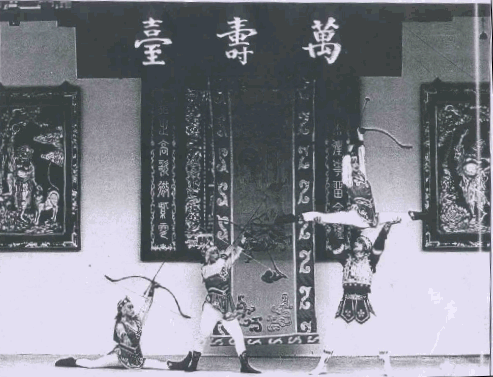
This archery performance developed by You Desen
and three female performers took
the 'Golden Lion' Prize at the 1991 Wuhan
National Acrobatics Competition.
You Desen and the other archery performers spent a lot of training time and effort both in improving their shooting accuracy and in developing some special shooting movements, such as shooting behind their backs, under their legs or while doing the splits. Such acts were the key to winning their acrobatic awards. Given that the target distances on stage have to be fairly close (say 7-10 metres), they choose relatively light bows to shoot with. Moreover, they cover the points of their arrows with rubber to make blunts. Taking his cue from modern archery equipment, You Desen developed an aiming device (a pin attached to the limb) so that he could line up his eye, the pin and his target more accurately. In his act, he can extinguish three candles placed in a row with one arrow, as well as candles held on the heads of three female performers – without damaging any of the props. This requires a high degree of accuracy. One point he specially stresses: the accuracy of his bows is affected by the environment and temperature of the location where the performance takes place – something he has to consider carefully when performing outside China.
In the early 1970s, acrobatic performer Liu Xiangdong had in mind to take up practice with a heavy bow, having seen Zhang Xiaojie's performances in the Beijing Acrobatic Troupe a number of times. As he couldn't find such bows in Inner Mongolia, he had to order one from Beijing. Around 1971, he went to Beijing accompanied by the troupe's props craftsman, Li Yuxiang, to visit bowyer Li Yuchun. It was said that the latter had previously worked as a bowyer in the 'Bowyers' Alley' in Beijing, but had been denounced as a 'rightist' and sent down to Baodi County near Tianjin for a period of time. Subsequently, Li Yuchun had returned to Beijing and so they went to his house there to order a bow.
When Liu Xiangdong explained his plan to Bowyer Li Yuchun, Li asked him what draw-weight he wanted. Liu asked him to bring out his heaviest bow for him to try. As it happened, a heavy bow performer from the Beijing Acrobatic Troupe, Cai Wenshan, was present. No one thought for a moment that Liu Xiangdong could draw one of the heaviest bows; but to everyone's amazement he managed to do so. Cai Wenshan said, "These Inner Mongolians grow up on a diet of beef: that's why they're so strong!" However, he commented that Liu Xiangdong's stance and method of applying his strength left a lot of room for improvement: he would need to persist in his practice for some time to come.
They went about assembling the necessary materials for the bow – long buffalo horn from Guangxi and bamboo from Ningbo – and brought them to Li Yuchun's home. Once again, Li asked what draw-weight Liu wanted, and Liu insisted on 18 'jing'r' (equal to 90Kg. Bowyer Li follows the tradition of the old Beijing bowyers in measuring the draw-weight of bows in 'jing'r', one jing'r weighing 10 catties), because the troupe was about to make a performing tour in Africa and Liu was afraid that Africans would be very strong and would be able to draw a lighter strength-bow with ease. In the end, seven bows were produced.
On his return to Inner Mongolia, Liu Xiangdong made a point of asking a Mongolian wrestler and a weight-lifter to try drawing the bow, but neither could draw it fully. That put Liu more at ease. After a lot of practice, Liu is now able to draw eight such bows at one time.

Performance at Ocean Park, Hong Kong.
Photograph courtesy of the archivist of the Inner Mongolian Acrobatic
Troupe.
On another occasion, the Troupe ordered a further six bows from Li Yuchun. From 1974 onwards, the troupe’s own props craftsman, Li Yuxiang, has been able to produce traditional Chinese bows and arrows by himself.
Before he went to order bows from Beijing, Liu Xiangdong had obtained an old, traditional Chinese bow from Ningxia Province. By taking this old bow apart, the troupe's props craftsman, Li Yuxiang, had been able to grasp the basic structure of such bows.
After several visits to Li Yuchun in Beijing to order bows, the troupe had the idea of getting Li Yuxiang to learn the trade. Now aged 40, he started working as a general assistant in Li Yuchun's workshop in Beijing for three months. While working, he had a chance to observe first-hand how the master worked his craft. At first the master didn't realise his assistant's real intention, but later he realised what was going on, he decided that it would be better to take Li Yuxiang under his wing and teach him properly. In this way, he continued for a further three months.
Returning to Inner Mongolia, he made a few bows according to Bowyer Li Yuchun's instructions, and then sent them back to Beijing for assessment. Once he had become proficient, he altered the design to suit Inner Mongolia’s heroic style, making the siyahs longer and broader.
After this, Master Li Yuxiang very quickly became proficient at making bows and arrows. The bows being used by the female performers in Illustration 2 were all monkey-bows made by him. Monkey bows were originally made for shooting pellets with; but pellet bow technique is particularly difficult and the skill has been lost. However, monkey bows can also be strung to shoot arrows like ordinary bows.
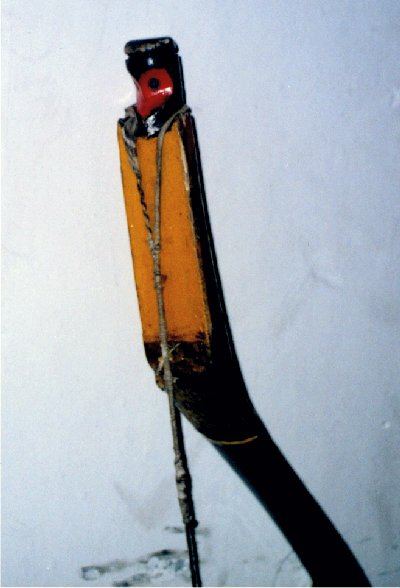
'Monkey bow' strung to shoot arrows.
Although in terms of construction procedures and materials shooting bows and strength bows are similar, the bamboo core is used differently: for strength bows, the skin of the bamboo core faces inward to form the belly of the bow, while for an archery bow it faces out to form the back. If there are sufficient materials, around ten bows can be produced in a single batch. If all the materials are to hand, the whole bow can be finished in two months. Normally, the process needs to take place in the spring and autumn, otherwise the flexibility of the completed bow will not be so good.
Li Yuxiang can make strength bows according to the requirement of the performer. For a bow of 10-12 jing'r, he can estimate the weight of materials required very accurately, so that the resulting bow will be within one to two catties of the target draw-weight. To check the draw-weight, the bow is fully drawn and a rod is used to measure the draw-length. Then the hook of a balance is attached to the string and the bow is pulled to the measured length while the bow grip is held down with the feet and the weight is then read off the scale. If the bow is too heavy to be measured in this way, the limb has to be tied down on a wooden beam held down by two men and the string pulled by three men pulling on a lever attached to the scale arm and pulling up the bow-string. If the bow is so heavy that no-one can pull it, then it can be tillered down to make it lighter. But with his many years of experience, Bowyer Li very rarely has to check the weight of a bow that he has made - every time it meets the requirement of the performer very well. After learning the craft, he has made bows for performers from other provinces as well.
Now Bowyer Li very rarely makes bows: the materials have become too hard to come by, and he has got too old for it.
January 2003
Csaba Grozer has been experimenting with new TRH laminated, composite bow-making techniques.

You can see two of these bows compared with bows from his existing stock. They are pictured against 15cm (6") squares.
Grabbing half a dozen different bows with varying draw-weights and draw lengths and comparing them on a chronometer is not as easy as you would think. I had to shoot from three meters distance with a 30" draw over the sensors of the chronometer and into a backstop net in order to get any sensible readings. Here is a tabulation of the results:
| Bow | Average recorded speed in feet per second |
| A 66" Chinese bow by Lucas Novotny of Saluki (50#) | 172.5 |
| Csaba Grozer's original Chinese bow design (45#) | 158.5 |
| Csaba Grozer's new Chinese bow design (45#) | 161.8 |
| Csaba Grozer's new Scythian bow design (45#) | 160.2 |
| Csaba Grozer's original Crimean Tatar bow design (45#) | 151.7 |
| Csaba Grozer's original Turkish bow design (50#) | 167.3 |
| Csaba Grozer's new Turkish bow design (50#) | 174.3 |
I have also taken the bows together with a set of six, matched wooden arrows and shot at my target using the same 30" draw, trying to get a feel for the differences.
You should note that Csaba has not attempted to add any decorative finish to some of he new bows. This made the two Turkish-style bows difficult to compare, because the lack of leather covering on the limbs of the new bow is bound to have an effect on the bow's speed right from the start.
And indeed it did. The new design felt very quick. It was also not so heavy to draw (stacked less), but there was another issue at play here: unlike Csaba's older Turkish bow, the new bow does not have a marked reflex when unstrung. I still regard the older Turkish design as superior, and the best value-for-money bow of this design on the market.
Csaba's 'Scythian' bow design is, by his own reckoning, a 'fantasy' design: it only bears a passing resemblance to known images of historical Scythian bows. But this little new bow is a real performer. It was fast and smooth to draw.
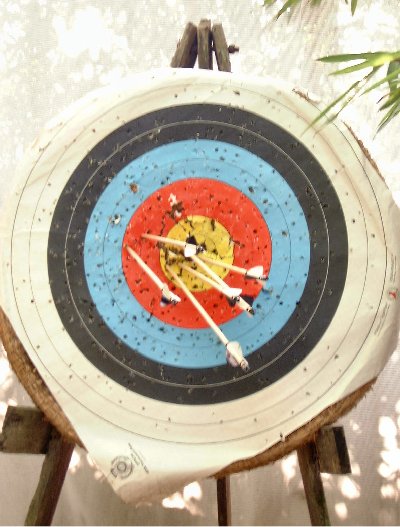
Grouping with the new Scythian at 15 metres. (thumb ring
draw).
I felt real power in the bow and a smooth draw. The grip is well built out so that there is no discomfort at full draw (a problem with the beautiful Krim-Tatar design, which has a very slim grip.) I think that the new Scythian design could have a great market as a generic horse bow (with no pretension of historical precedent.) Perhaps Csaba could go for a 'no-nonsense' black fibergalss limb with no leather cover (even more speed!)
Kudos to Csaba Grozer for pushing the envelope of traditional bow design with modern materials!
In 1954-55, Malayan resident N. W. Simmons traveled widely in Asia and kept a record of all he could find about local archery traditions. He published his findings in The Journal of the Malayan Branch of the Royal Asiatic Society [Vol. XXXII, Pt. 1, 1959] His article is an excellent snap-shot of traditional archery as he found it then, and I am taking the liberty of summarizing some of his report below.
Polynesia
Pitt Rivers had communicated about the use of bows for sport and ritual among chiefs on the Society Islands in 1914. Simmons speculated that the bows are used for displays of strength.
Fiji and Tonga
The use of bows and arrows in hunting was reported to have stopped with the Cession in 1876. Bows were made from mangrove wood (Rhizophora and Haplopetalon.) A groove in the wood of Fijian bows caused by the structure of the mangrove root has been misinterpreted by some writes as something made be the bowyer to allow an arrow to be gripped against the limb of the bow. The bows were 130-180cm in length with elegant nocks. The strings were made from the fibres of a variety of hibiscus and waxed. Arrows were made from a bamboo-like grass. Heads of the arrows were made of hardwood, bone, or reverse conical hardwood knobs for hunting birds in trees. Arrows were un-fletched with shallow nocks as are often found among people who use a short pinch draw.
New Hebrides
New Hebrides bows were similar in construction to Fijian and Tongan bows, but were a little linger (150-200cm) and string shorter, so that there there was a length of bow-tip visible at each end (although Simmons suspected incorret stringing by museum curators.) No nocks were visible. Apart from Mangrove, some bows were made of hardwood or palm, and plano-convex to oval in cross-section.
In the northern New Hebrides, bows were differentiated into fighting and ceremonial bows. Fighting bows were more robust, and ceremonial bows were asymmetrical (less bent in the lower limb) and somewhat recurved in shape like an Andeman bow. Arrows were made of long, bamboo-like grasses with shallow nocks (with a few exceptional deep nocks), both crudely fletched and unfletched.
Solomon Islands
Bows from Rennel and Bellona Islands were one metre or less, with elaborate carved nocks. Arrows were made from straightened twigs. Another bow design had an elaborate cap to permanently attach one of the string ends to the bow tip, formed to hold the string a short distance from the face of the bow and made of fibre hardened with breadfruit latex gum. The free end of the string had a whipped knot. In the South-east Solomons, some bows made from palm wood had their limbs decorated with red and yellow dyed rattan. The skin side of the palm wood was on the belly. Arrows were made from grass and had shallow nocks or no nocks at all. They were unfletched and the points were made of palm splinters. The bows were draw with a pinch hold, the index finger slanted across the string and the bow canted to the right.
New Guinea and Papua
The majority of bows are made from palm (Archontophoenix) called 'limbom' in Pidgin and are 150-220cm long, plano-convex or oval in cross-section, and have the skin of the palm at the belly. The nocks are conical at the tip of the limbs. In some areas, rings of plaited calamus were applied as nocks. Some isolated mountain communities (e.g. in the Goroka area) use smaller bamboo bows.
Another type of bow used in the Fly and Trans-Fly country was made from thick-walled bamboo staves bent skin to belly and were over two metres long.
Strings were made from four types of materials: calamus, bamboo skin, bamboo attached with cords or just cords.
A wide range of materials and designs were used for arrow points. Some were elaborate and presumably had a magical significance. The arrows were made of bamboo and were unfletched. Poisons used on all Papuan points were made from putrefying flesh. The Papuans did not use plant poisons, although they were aware of the very poisonous nature of some of their local plants (e.g. the Upas tree.)
Shooting was done with the pinch hold, assisted with the middle and ring fingers. The shafts of the arrows were very long and not matched, so that no attempt was made to fix the draw to any particular point, although some tribes with a warlike reputation did attempt to match their arrows and achieve a consistent draw length. The bows were canted to the right and sometimes held horizontally. The Fly and Trans-Fly people raised the bow above their heads and then brought the bow arm down to the draw. They also used bracers to protect the bow forearm. The accuracy of shooting observed among the Papuans was very low: they relied mainly on excellent stalking skills.
Over the past three years, I have tried to develop an Asian archery festival in Hong Kong. It is a truly roller-coaster experience. I have come so close, and yet it seems that even our fully advanced and generously-sponsored 2003 Asian Archery festival is under last-minute threat from the pneumonia outbreak that has dogged Hong Kong and other cities in recent months. Please keep your fingers crossed that the event can go ahead in May. However, if by mid-April we lack the confidence to continue with the event, we shall postpone it to an alternative date later in the year.
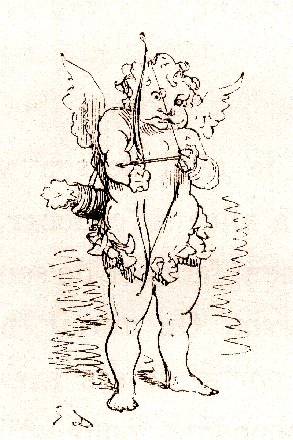
Gustave Doré "Cupid"
April 2003
For as long as I have been researching Chinese traditional archery, I have resisted holding myself out to be a teacher of the art. There are a number of reasons for that.
‘Chinese Archery’ can’t be easily reduced to a standard. The classic archery of ancient China spanned thousands of years with many schools and local variations. Talking about ‘Chinese Archery’ is about as meaningless as talking about ‘European cookery’. What is more, the art is truly dead for all practical purposes. What I have pieced together is a sort of ‘Jurassic Park’ of techniques. Probably, no authentic practitioner (were any still alive today) would recognize it as true ‘Chinese archery.’
Then there is the rather significant problem that I am not a very good shot. Students expect a certain degree of excellence (in hitting the target) from an archery instructor.
Things changed this year when the imminent opening of the museum exhibition about Chinese archery aroused a lot of local news coverage. The Museum itself wanted to get a training class set up and the press reports stirred up a lot of interest and demand for classes.
|
|
For all my shortcomings, it was painfully clear that I was the only person – qualified or unqualified – who was going to be able to teach classes. It was also a window of opportunity, because this time more than any was a good time to try to revive an interest in Chinese archery among Chinese people. The first question to be addressed was the equipment. Traditional horn bows were not an option: they are too expensive for beginners, they perform poorly or not at all at low draw-weights, and manufacturing enough to equip a class of fifteen students would take too long. Using a generous donation from the Rotary Club of Hong Kong North, ATARN purchased modern fiberglass reproductions of traditional Chinese bows with draw-weights of 30#–35#. Then came a short period of mild comedy in finding a location for the training. Archery is wrongly perceived as a dangerous sport, and I was at first pressed to consider insurance coverage. Insurers were in general not interested in taking on the cover. Those who were prepared to consider it wanted evidence that I was a qualified coach. What did that mean? Who would confer the qualification? They’re all dead. Clearly, it was not going to be possible to get insurance cover. Finally the Hong Kong Institute of Vocational Education came to the rescue, enthusiastically supporting the training (with some students drawn from their staff.) They provided an indoor games hall where training could continue in all weathers. I purchased a backstop net and we set up a range 6.5 metres wide (enough for three target butts) with a distance of up to 20 metres. The archery range was set up. |
Recruiting the students was easy: the initial class of 12 (the maximum number a single instructor can handle safely) was twice over-subscribed.
When it came to lesson design, I had the experience of being trained in ground-work in Kassai’s classes in Fort Dodge as well as observing traditional archery training in Korea. There was a lot to learn from Kassai’s methods, but other issues needed a very different approach from Kassai’s.
‘Martial art’ nowadays has a strong connotation of Asian hand-to-hand fighting skills. That is only partially-applicable to Chinese archery. Chinese archery is a battlefield skill: very different from how modern Chinese martial arts are taught today. I decided to build in a certain degree of military drill training into the programme; but to ensure that the training focussed on co-ordination, co-operation and tactical considerations, not just discipline. I decided that every demand on the student must be under-lain with an explanation of why it was required.
Another element of my teaching is that I teach ‘unarchery’. In unarchery, nothing is certain. Your target may move. You may be shooting from a moving platform like a horse. An enemy may be shooting at you. You may be reduced to shooting with a child’s bow, like Li Guang when he was captured by the Huns. In unarchery, the exact moment of release is not yours to decide.
I did accept from Kassai’s teaching that all forms of Chinese archery teaching should be consistent with the requirements of horseback archery. Should my students ever reach the point of being ready to study horseback archery, I do not want them to have to re-learn anything. Historically, Chinese traditional instructors shared such concerns.
Perhaps differently from other instructors, I believe that qigong has an important role to play in good archery technique. If nothing else, I do not believe students should draw a bow before they have physically warmed up with some qigong exercises.
Based on those ideas, I developed a standard 90-minute teaching plan like this:
Like Kassai’s training, all the archery instruction is carried out in the context of military drills by the students, who form up in columns. The initial military drill (accompanied by the beat of the drum, in the traditional Chinese manner) attunes the students to pace and co-ordination. The instruction continues in the style of the military drill. Students are motivated to move efficiently and with proper consideration for what others are doing: the more quickly and efficiently they move, they more chances they get to shoot. Fumbling wastes their time and that of the other students.
The final discussion allows students to seek elaboration on points that I had failed to make clear, without interrupting the flow of the practical training. I also use it to discuss tactical or philosophical points raised by the classical Chinese writers. It is, as Kassai has recognized, an important ‘cooling off’ session.
Most of my well-laid plans were disrupted by the outbreak of the ‘Sars’ atypical pneumonia in Hong Kong. Classes at the Training Institute had to be stopped with the closure of schools.
We moved into small groups of five and I hosted ‘supervised practice’ sessions at my home. This was the first time that students got to draw a bow fully, using a lightweight bow that I still had from my early days of training. It was also their first time in front of a target (up until then, all training involved just shooting into the backstop net.)
This brief period as a trainer has given me valuable experience. I hope to take the experience forward to intensive training sessions within the Chinese Mainland. I shall share my experiences below.
 The first session in the course covered an
introduction to qigong, followed by an introduction to bows and arrows
and shooting range safety. Students were not acquainted with each-other, so none
of the initial elements could be covered properly in the allotted time. The
basic qigong movements took almost half an hour to teach. Military drill
was ragged, and safety was an important issue that needed time and care to
explain.
The first session in the course covered an
introduction to qigong, followed by an introduction to bows and arrows
and shooting range safety. Students were not acquainted with each-other, so none
of the initial elements could be covered properly in the allotted time. The
basic qigong movements took almost half an hour to teach. Military drill
was ragged, and safety was an important issue that needed time and care to
explain.
But from then on, things came together quickly. Drills got smarter and more efficient. We started to look at stringing bows, nocking arrows and basic thumb release technique. I teach all students to string bows in pairs, one squatting and bending the bow around his knees and the other assisting. At first the students were terrified of the bows and took five minutes to complete the procedure and do their safety-checks. Now they can do it all in seconds.
Another area where I invest a lot of teaching time is arrow-nocking technique. True to Chinese military training principles, I do not permit an archer to grasp a fist-full of arrows against the bow. All students learn to take each arrow from the belt (mimicking a quiver), place it correctly against the bow, bring the arrow nock to the nocking point on the string and then slide it back onto the string with the bow-hand fingers while positioning the draw-hand thumb, all smoothly and without looking. This is the only battlefield-proven, sustainable method. The students do not readily appreciate the need for such a deliberate procedure for something as mundane as nocking the arrow. It is one of the most difficult things for them to master.
By contrast, all the students have mastered the ‘Mongolian’ draw naturally and without difficulty. I teach the draw without a thumb ring (the ring just clutters the technique in the early stages of learning.) There are a few complaints about sore thumbs (I hand out adhesive bandages to the weak-hearted). But our bowstrings have thick servings and I teach all the initial technique without letting students draw the bow back more than ten centimeters: just enough to plop the arrow off the string into the net and get on with nocking the next round.
Lack of strength in the shoulders and back is a serious problem with city people. On the first day I issued all the students with a loop of rubber tubing to exercise with. I keep explaining that "I can teach you to shoot but I can’t make you strong." They keep the rubber tubing and take it home with them; but they can’t take the bows back home to practice. Generally, the students don’t exercise enough.
The strong dedication of my students showed through when the pneumonia outbreak caused the closure of all schools in Hong Kong. They pressed me to continue the classes and so I arranged practice sessions at my home. For the first time they started to try drawing a bow fully. They quickly came to realize how much they would need to develop physical strength. But surprise, surprise: with four weeks’ worth of training in technique behind them, every student could hit a target with consistent shots (albeit not necessarily landing where they had planned!)
A number of students became hung-up on the idea that the string would hit their cheek if they released when the string was drawn back level to their ear. No amount of explanation would overcome their fears. Finally, one student got behind me while I was shooting and realized that at full-draw, my spectacles were fully two inches inside their imagined trajectory of the string; but, wonder of wonders, the string never touched them when I released. Magic!
There was also the normal crop of bruised forearms. I advise my students that the Disciple of God (may His name be exalted!) despises those who wear bracers on their arms so as to deny Him the opportunity to punish them for their bad shooting!
Another surprise is that a number of students, in the absence of talk of handedness and dominant eye, would tire of shooting with one hand and just change over to shoot with the other.
Although these guided practice session in small groups were not in the original plan, they have moved the whole group forward. Clearly, close individual attention is important and I must find a way to draw it into the overall teaching plan.
I face a further problem area: my initial order of thumb rings were on average too big for my Chinese students, who mostly have fine-boned hands. Half are women.
So far, I have not demanded that students come to a full draw so there is not a big problem: but that will soon change. I am placing an order for more rings; but it is a hit-and-miss affair ordering thumb rings by mail-order. (In Korea, a craftsman makes each archer a ring to measure on the spot, with half an hour’s work.) I am considering a crafty scheme to make elastic thumb rings for beginners!
Another problem is the arrows. I haven’t the time to fletch 50, 80-cm arrows. I ordered ready-made arrows from Quicks, but they are rather shorter than what I had hoped for.
For the future, there is demand already for another beginners’ class and an intermediate class for those who are currently studying with me. By the end of the current session, the beginners should have learned to draw a bow fully with a correct stance and release an arrow cleanly with a thumb ring draw. Accuracy in hitting the target is not on the syllabus.
For the intermediate level, I plan to teach the infantry archery examination syllabus, with basic accuracy in hitting a target at 20 metres and drawing a 60# bow three times with no arrow. The style will be based on the Chinese Ming style set out by Li Chengfen.
An advanced class would have to address the question of horseback archery. Hong Kong with its 150-year horseracing tradition, is a world-class center for teaching equestrian skills. There is an electric horse simulator at the Jockey Training School and a supportive local saddle club with a disused polo field that can be adapted to simulate the old Chinese examination ground with three targets. Even if we can’t get fully-fledged horseback archery started here, there is the opportunity for some useful groundwork.
May 2003
Tom Winter Associate Professor of Classics, University of Nebraska, writes:
"I now have my own Csaba Grozer old Scythian bow. I learned of it from your site; it occurred that you might be interested in some feedback.
I teach Latin and Greek at the University of Nebraska, and I wanted a reproduction for many reasons, including for my lectures on the Odyssey. Greeks, of course, used "Scythian" and "archer' interchangeably; In Athens, Scythian archers accompanied the equivalent of police, and any bow in a Greek vase painting would basically look the same as, or essentially - be -a Scythian composite recurve bow.
So I had to have one! (Another reason: the Scythian has the least mass at the tips of the types available at the Grozer website. This should be a factor towards getting the work of the draw into the momentum of the arrow.)
The draw: informed by your site, I experimented with the Mongol release, using some old fiberglass youth bows. I did decide that three fingers would pull more bow for me than my thumb ever would, but am a better informed archer for the experience. I recently switched to left-hand shooting. A daily diet of 100 arrows a day weather permitting, coupled with dry-drawing indoors in the inclement weather, have made my left draw-fingers noticeably thicker than the same fingers on the right hand. I think this has been essential to good shooting. Someone said it before in one of the archery classics: it's not the weight you can draw; it's the weight you can loose. And my drawing thumb would doubtless profit from the same training.

Tom Winter with his Scythian Bow (© Tom Winter, 2003)
But back to my Scythian: Last night, I was doing very well, plunking 17 of 22 arrows into a 16" circle at 24 yards with a favorite 45 lb longbow. (For me, this is good.) I switched to my old Scythian and got a surprise: with the 45 lb Scythian, aiming as with the longbow, my arrows were going about 20" higher. Using the Scythian at the same weight, my aim needed more gap between the pile and the gold. This done, I then put 17 arrows in a row into the 16" circle. Missed next three, ended with 19 of 22 into the 16" circle. Ruined two by hitting them. Now that I can group my arrows, I must stop shooting so many at a time!
Sum: my Grozer "old Scythian" is faster than my favorite longbow of the same draw weight, and at least as accurate, or more. My arrow stopper is 6 layers of carpet draped over a wooden sawhorse, and set in front of rising ground.
All best wishes, Tom Winter."
In 1738, The Manchu emperor Qianlong ordered a division of his Manchu bannermen to defend the border of China in Xinjiang where his troops had been fighting continued campaigns against the Muslim Uighurs. The troops that he dispatched came from the Xibe (pronounced "shee-ber") group, and were directly descended from the Ruzhen who founded the Jin Dynasty in China between 1115 and 1234.
The Xibe Manchus travelled with their families, enduring an arduous trek lasting three years, until they finally reached Ili (Yining) on the border of modern-day Khazakhstan. Although Ili is surrounded by the forbidding Tian Shan Range and the deserts of Central Asia, the Ili river plain is fertile and the climate is so mild that they can grow rice there. (The Ili valley is thought to be the place from which all domesticated apples in the world originated, and the last descendants of the famous ‘blood-sweating’ horses can be found high in the surrounding valleys.)

The Tian Shan Mountain seen from the air as you approach Ili, Xinjiang
Originally, the bannermen were to be posted there for thirty years; but when the period ended, their request to return to their homeland was refused. So there they settled, established an ancestral temple and built up a community at Chapchal (Chabucha’er).
The Xibe community remains at Ili until today – indeed it is the only Manchu community in China which preserves the original Manchu written and spoken language. Spoken and written Manchu has died out among the remaining Manchus in north-east China. Today, the Xibe of Chapchal have a Manchu language local newspaper, a Manchu language primary school syllabus (with textbooks in Manchu), and even a Manchu language broadcasting station.

Manchu language weekly newspaper, 'Chapchal Serkhin' and Manchu primary
school textbooks.
Through the Centuries, the Xibe of Chapchal maintained the proud Manchu archery tradition. Every year in May, they celebrate the day that they completed their arduous journey from the Capital to Ili, and hold an archery competition. Gradually, however, with the loss of the traditional Manchu bows, they changed to using Western archery equipment. Only a few old men continue to shoot with fire arrows and whistling arrows to mark the festival. Modern Xibe shoot with compound bows or competition recurves.
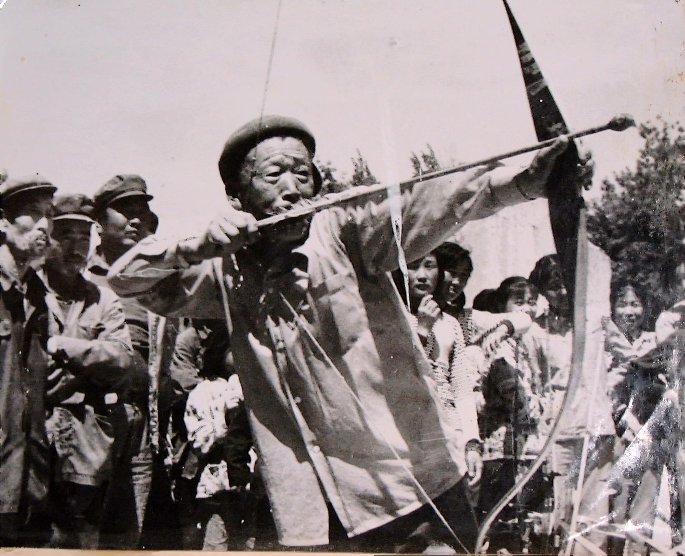
Traditional Xibe archer with a whistling arrow in the 1980s
But archery prowess has never deserted the Xibe. Even today, when a boy is born, a miniature bow and arrow are hung over his cot. Children – boys and girls – learn to shoot young, and every province in China now has at least one archer from the Xibe minority on its provincial team.
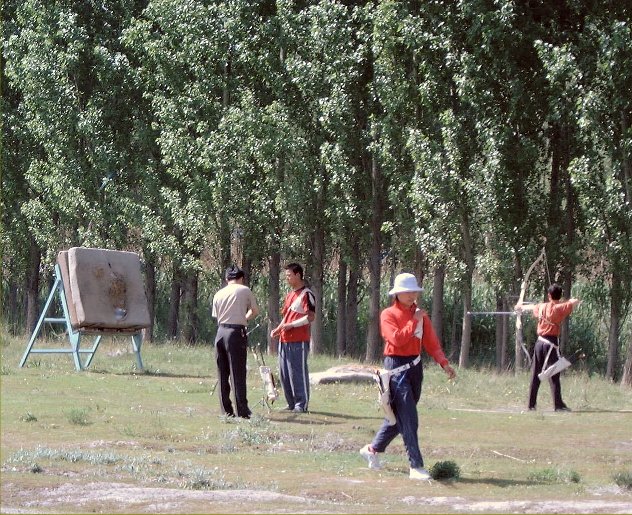
Young Xibe archers practicing
In May 2003, I visited the Xibe at Chapchal and interviewed them about their archery tradition. I presented them with a photocopy of Naran Changgiun’s ‘Shooting the Target’ – a book on archery written in Manchu at the start of the Qing Dynasty, the last remaining copy of which is now kept at the Toyobunko Library in Tokyo. They were amazed and delighted to have it, and vowed that it would be re-printed in their local newspaper.

Chapchal archery coach, Ms Jin.
They have a small local museum of Manchu culture in which they had previously had an old bow on display (until it was clumsily destroyed by a visiting newspaper reporter!) Last year, I sent them an original old Manchu bow to replace it.
Last week, I received a letter from Mr Xu Kaicai – former Chinese national archery coach – who had accompanied me to Chapchal last year: the Xibe have applied to the Central People’s Government to introduce archery into the primary and secondary school syllabus. After consultation with the National Archery Association, it has been proposed that their request be accepted provided that they also include traditional Manchu archery in the syllabus. They will be sent ten of the reproductions of Manchu bows provided through ATARN and generously funded by the Rotary Club of Hong Kong North.
June 2003
Horseback Archery at the Leeds Royal
Armouries, UK
8th, 9th, 10th August 2003
Hilary Greenland, Secretary of the SPTA (The Society for the Promotion of Traditional Archery) writes:
"We will be demonstrating competitive horseback archery as part of a show in the tiltyard at the Royal Armouries during one of their "Sporting Times" series, which feature displays of martial skills which have become modern sports.
"The Armouries itself is well worth a visit with fine displays from the UK national collection of historic arms and armour from around the world: see www.armouries.org.uk. For information on SPTA see www.sptradarch.org
"The displays will be in the Tiltyard, adjacent to the museum and admission to the museum and the display is free.

"Friday 8th is a practice day (from approximately midday) which will be open to the public. The main shows will be at 3pm on Saturday and Sunday.
"Alongside the tiltyard on all three days, SPTA will be putting on an exhibition of composite bow making and horseback archery.
"Please come and meet us, see the display, have a chat with us about all things to do with traditional archery, and visit the Armouries' remarkable collection."
In May 2002, the Bow-makers' guild hall in Beijing was demolished. Already in the Cultural Revolution of 1966, the tale of the invention of the bow by Huang Di, mythical first ruler of China, had been erased from the wall on each side of the ancestral altar. In case it should be forgotten - even though it is not more than a fairy tale -- I hope you will tell it to your children. You can download the story and the drawing as an Adobe Acrobat file to print and distribute to you school class or community group.
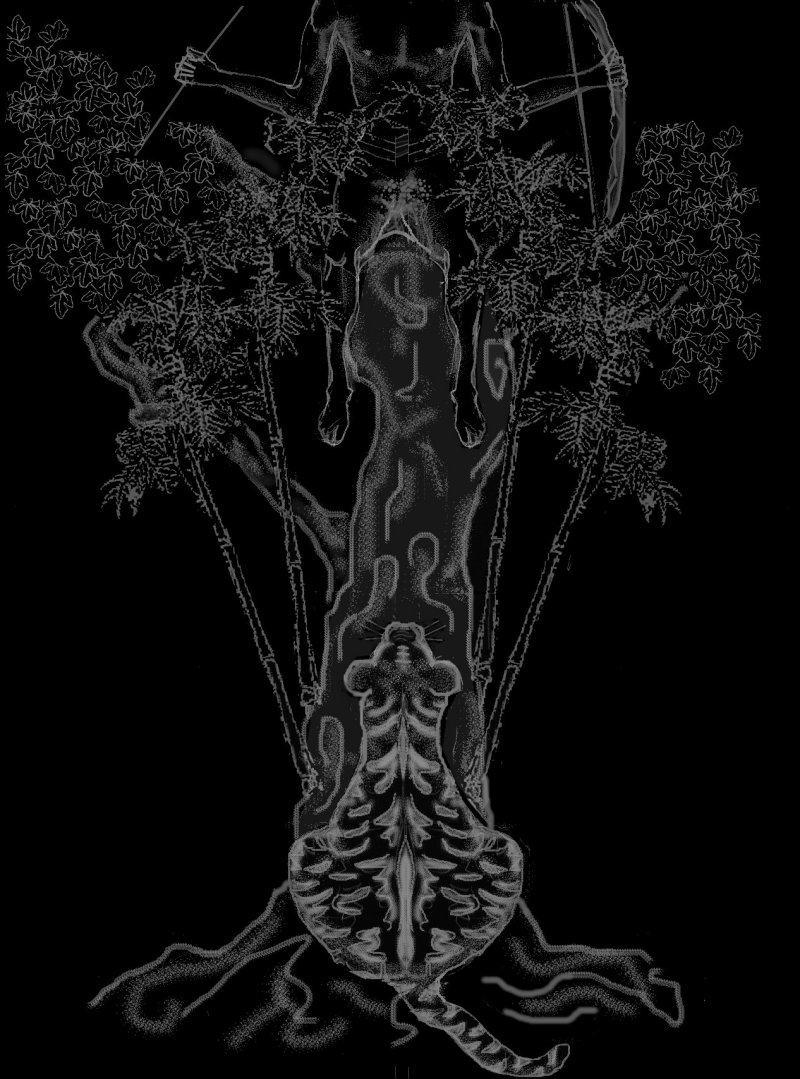 |
How Huangdi Invented the Bow and Arrow ONCE
upon a time, Suddenly,
Being a patient creature, the tiger sat down at the bottom of the tree to seewhat would happen next. Huangdi
saw that the mulberry wood Next
he saw With his bow an
arrow, (Chinese folk tale. Drawing by Stephen Selby 2003) |
On 30 May, the Hong Kong Museum of Coastal Defence opened its exhibition of Asian archery to the public. It has been an exciting experience working with the professional staff of the museum to prepare for the exhibition. I hope that many Members of ATARN will come to the official opening in October.
Meanwhile, for those of you who can't wait, here is a preview. The photographs are published here with kind permission of the Hong Kong Museum of Coastal Defence and are protected by copyright.
Entrance to the exhibition.
"There are thirty six types of weapons, and the bow is king. There are
eighteen martial arts, and archery is the greatest."
Visitors can pull out draws to examine exhibits of arrowheads.
Archery in Chinese legend and ritual
Varieties of Qing Dynasty bows: hunting, examination and military
The bowmaker's craft: tools of the trade and video showing how bows are made
by Ju Yuan Hao.
Life-size figure of a Qing archer (after the 1867 photograph by John Thomson)
The archery traditions of Asia
August 2003
Here I am back in harness after spending a month in England. Apart from riding and doing some archery, I had the chance to visit the Simon Archery Collection in Manchester and the Royal Armouries at Leeds.
In Manchester, Mrs. A. Wendy Hodkinson, Hon. Keeper of Simon Archery Collection, kindly showed me around the new display by . Unfortunately, the reserve collection items have not yet been un-packed, so I shall have to make another visit next year to see them. (Not at all unfortunate, actually.) The items on display are not great in number; but they are well displayed. I would have liked to see a stronger story-line: the main message that came across was that there is great diversity in bow designs, but there is insufficient space to allow visitors to understand the deeper implications of that, and what the reasons might be.
The display also covers crossbows in some detail, including a Chinese repeating crossbow.
If ATARN Members with a specialist interest plan to visit, I strongly suggest making contact with Wendy Hodkinson in advance, as she has a great deal of knowledge and an explanation from her would provide a much-needed supplement to the descriptions shown in the display cabinets. (Manchester Museum also has a fine Egyptian collection. For the second time (in Geneva also), I saw Chinese Warring States period trilobate bronze arrowheads in a Roman era Egyptian collection.
On to Leeds in the North of England where Hilary Greenland of the Society for Promotion of Traditional Archery (SPTA) had organized a traditional archery event at the Leeds Armoury.

Christian Schrade doing a 'Parthian Shot'
Photograph © Caroline Collins 2003
Such fun! First, Hilary had laid on an excellent display of traditional bow-making – concentrating on how horn bows are made. Secondly, there was an exciting display of equestrian martial arts in the tilting (jousting) yard at the Armoury. Apart from mediaeval European tilting, lance and sword work on horseback, there was a comparison of the speed of reloading between a matchlock musketeer and an archer (in Saracen armour). No bets on who won! Then there were displays of Japanese horseback archery (Andrew Bodley) and Kassai-style modern horseback archery (Christian Schrade and Martin Knight).
I thought I knew a lot about Chinese bronze crossbow locks. I have written before on the different types of Chinese crossbow locks that I have encountered. So when Dale A. Proctor sent me this photograph -

I told him that he had an early Warring States bronze crossbow mechanism; but while the sear and trigger are present, the lock and axles are missing.
I couldn't have been more wrong! This is a two-element mechanism: trigger and sear with no lock (although it is still missing the axles.) Dale followed up with these photographs and drawings showing how it works:
|
|
|
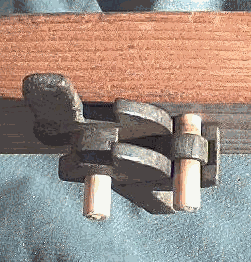
Oblique view
 Locked |
 Triggered |
 Released |
Drawings © Dale A. Proctor, 2003
Dale writes:
“This unusual Chinese crossbow lock consists of only two elements, which can best be described as a sear and a trigger. They would be mounted in the crossbow stock on two axles. The sear is mounted on the rear axle and the trigger on the forward axle. The two sides of the sear are connected together near the rear axle and at the very front. The forward sides of the sear hook under the forward axle and are then connected to each other in front. The portion connecting the two sides of the sear at the front is hollowed to accommodate the eye of the trigger and fit into the notch just beneath the eye. When the trigger is pulled back the sear is released from the notch and rolls around the rear axle, down and forward, releasing the string.
“When cocking, the string is pulled back until it contacts the rearward sighting pin or cocking lever on the sear. This rolls the sear back up to the cocked location and the trigger will fall forward and lock it – even when the crossbow is horizontal. The dog leg in the trigger keeps it out of the way of the falling sear and places the portion you would pull to the rear.
“I presume that there was some kind of stop for the sear carved into the stock, otherwise it continues past the dog leg in the trigger and will jam the mechanism when you try to cock it.
“Some observations which are only my own opinion: I doubt whether it was mounted in a box in the stock, as the catches on such mechanisms usually have a flat portion designed to strike the bottom of the inlet for the box. It could have had a box that mounts on the exterior of the stock – or no box at all.
“In comparison to the more usual Chinese crossbow locks, this one probably has less than half the leverage, making it most suitable for lighter crossbows.
“Some of the proportions and the construction of the sear are so similar to the more usual lock that I strongly feel that the maker made both kinds of crossbow locks.”
This sort of two-element lock is described for European crossbows in Payne-Gallwey: "The Crossbow", Longmans, Green & Co., 1903; but none of the reference materials I have come across describe a Chinese one. From the stocky shape of the sear and trigger, I would date it no earlier than Qin. Crossbow mechanism design had changed radically by the Tang Dynasty, so I would put it as some time between 200BCE and 400CE.
I am looking forward to reading your views on ATARNet.
All photographic records of Qing Dynasty Chinese archery technique are precious, so I was delighted receive this page from 'Asia' Magazine of 1935.

Although the magazine edition dates from 1935, the photograph on the top left, attributed to W. H. Kress, has the archer in Qing military uniform. This certainly would not have occurred in the thick of the Nationalist period, so the photograph must date from the time of the fall of the Qing dynasty. And the top right hand photographs are clearly related to this one. ('Die Grosse Völkerkunde' by Dr. Hugo A. Bernazik, published in Leipzig in 1939.)
I am also able to relate the following, previously unattributed pair of photographs, and thus they must also be by W. H. Kress.
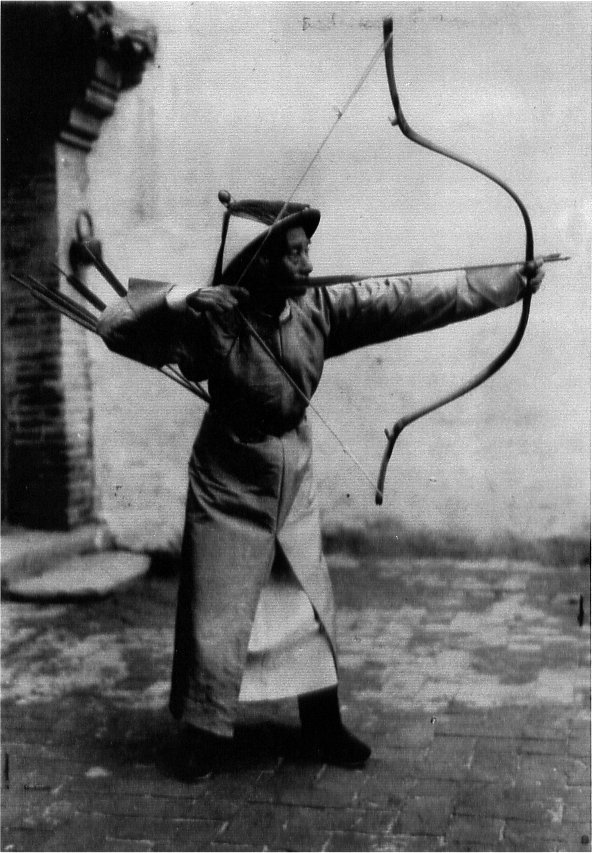
Chinese archer in Qing officer's summer dress.

The follow-through immediately following the release.
Please let me know if you have information about W. H. Kress.
Not long ago, I posed a question to Members about how to shoot a pellet bow. Now Bob Brown has come up with an explanation. Bob is a long-time member of the Soc. Archer Antiques and editor of their newsletter 'Arrowhead'. This explanation is also due to be published later by the SPTA, and I am including it in this newsletter with their kind permission.
SHOOTING A PELLET BOW
by Bob Brown
Following an article in the SPTA Newsletter, I discovered the website for 'ATARN' which have found very interesting. One of the things I spotted was that Stephen Selby was learning to shoot a pellet bow. Done that and got it working, and since I noted that he was coming North to the Horse Archers Event at the Royal Armouries Leeds, I thought I would go over there and show him and see the horse archers too. Alas, the dates clash. I shall be hurtling south to the Antiquarian Shoot of the Society of Archer-Antiquaries as he comes north.
Many moons ago (late 1960s) I saw a TV programme about village life in Southern India. In it there was a boy with a pellet bow shooting clay pellets. During an obviously staged scene, he shot at an eathenware pot slung under the eaves of a hut to keep the contents cool. He shot it from a guesstimated 15 feet and hit the pot nearly dead centre. The pellet went straight through and water fountained out of entrance and exit holes over the elder sitting beneath.
I was impressed by both the power and accuracy of the bow and decided to have a go. About that time I had acquired a beginners recurved bow made from a single flat-sectioned piece of ash with some idea of trying my hand at backing it with sinew. But it was light - about 20 pounds at 24 inches and converted to a pellet bow very nicely. The Indian one shown in the programme was made from a section of large diameter bamboo; about 3 feet long and had a double string with pouch. Pellet bows are known throughout S.E. Asia and China in one form or another.
My string was made from window-sash cord formed into a bowstring-length, endless loop with a bound knot join. Binding the two skeins together below the eyes at each end formed the eyes.
The two skeins were held apart by two (6mm) notched dowel separators about 1" (25mm) long set about halfway between the pouch and the nocks. I reasoned that if things went horribly wrong, I could drive a pellet into my bowhand and decided to set the pouch about 2 in. (50mm.) above my bowhand position (a wise precaution as it turned out). My first attempt at a leather pouch was just the width of the separation and 1" deep. This was too narrow to give a good grip on the pellet. The second attempt worked. This time I cut a much longer strip, sewed it onto one skein and made a pouch, put a pellet in it and held it and measured where it reached the other skein, then sewed that side to the bowstring.
Out to the garden to have a go. A part draw and a twist (to the right) of the bowhand on the loose - smack - the small stone hit the bow. Tried again, with a more forceful twist - the stone careened off the edge of the bow. Retired to house to pad bow with a covering of sisal string and leather for about 4 inches (10 cms.) above bowgrip. After some practice I could get about half of my shots past the bow.
Took it up to the archery club to show off. Several of us had seen the programme. Another chap had made up a pellet bow too. Found the same problem and come up with a solution.
It may not be the only solution or a classic solution but it works.
The trick he developed was to hold the bow firmly so that the bow and string are aligned about 45° to your bow arm.

Drawing © Bob Brown,
2003
The loose was a simple pinch grip. On the loaded (bulging) pouch this was able to be much firmer than on the narrow nock of an arrow on the string. Then draw to the eye - not the side of the face - so that you are looking at the target over the pouch and loose. The pellet then goes round the bow (to the right for a right-handed archer) and the string goes back to the 45° alignment.
The bows didn't seem to suffer from this gross misalignment although I do not know how it would affect Stephen Selby's Chinese pellet bow, which I understand, has siyahs (fixed ears). [Stephen says: 'Actually, my pellet bow doesn't have long, static ears.'] Oriental composite bows with siyahs do NOT take kindly to lateral twists. A lateral twist is multiplied by the leverage of the siyahs, twisting the bow-limbs which take a set (requiring correction). If a set occurs there is the very real danger of the string dismounting from the siyahs, on the loose (dangerous to bow and archer) and the bow becoming unstrung and reversing.
Ammunition. Initially, small pebbles were our ammunition but later we used ½" lead ball cast from a musket bullet mould. The lead ball ammo was splendid and wreaked havoc on tin cans up to about 40 feet (12m.) and that was when there were proper tin cans, not these modem ones you can crush in one hand. With some practice we became very accurate indeed.
As with any form of archery, if you try using a pellet bow, take care. SAFETY IS PARAMOUNT.
October 2003
ATARN's first international 'event' came to a successful end on Sunday, 26 October. That we could carry this off is due to the fantastic support and organization skills of the Leisure and Cultural Services Department of the Hong Kong SAR Government and its Museum of Coastal Defence. Secondly, we received generous support and sponsorship from Mrs. Barbara Park, Mrs. Kirsty Hamilton, Mr. George Magnus, Mr. Anthony Hardy, the Hong Kong First Bus Company, the Hong Kong Jockey Club, the Luk Chi Fu Martial Arts Association, and the Lo Wu Saddle Club.
Before the event, the Museum of Coastal Defence had set up a publicity programme with posters and advertising on in-bus television (yes, in Hong Kong we have a television service that just broadcasts to passengers in public busses!) They also put advertisements into leading local newspapers.

Publicity materials produced by the Hong Kong Museum of
Coastal Defence -
Poster, invitation card and catalogue.
Apart from Hong Kong enthusiasts, we had leading followers of traditional archery from all around the world taking part. Many of them attended at their own expense. From the USA, we had Dr. Charles Grayson, Dennis Connor, Molly and Anne O'Donnell, from Australia, Bede Dwyer, From Bhutan, Tsewang Nidup, from Canada, Jaap and Kay Koppedrayer, from Korea, Prof. (Col.) Kim Ki-hoon, from the Philippines, Peter Cua, from Mainland China, Prof. Yang Hong, Mr Xu Kaicai, Mr Yang Wentong and Yang Fuxi (of Ju Yuan Hao), Yi Degang, Ms Qi Guihua, and six Tibetan archers from Qinghai Province, and from Mongolia, Ms Byambasuren and Mr Battumur. Mr. Turbileg of the Mongolian Consulate in Hong Kong offered his services as an interpreter.
Our first event in the Festival was the opening of the 'Archery Traditions of Asia' exhibition at the Museum of Coastal Defence. This exhibition is what has motivated the Museum to outreach to the Hong Kong public to raise awareness of traditional archery. Because guns and crossbows are strictly controlled in Hong Kong, archery is one of the few practical aspects of military skills in which Hong Kong people can participate. The Museum invited many guests associated with setting up the exhibition, as well as the local press. About 60 people attended the opening. Professor Yang Hong of the Dept. of Archaeology of the Chinese Academy of Social Sciences gave a keynote address.
'Archery Traditions of Asia' exhibition
'Archery Traditions of Asia' exhibition: Qing bows.
On the second day, we held the 'Archery Traditions of Asia' seminar at the lecture theatre of the Museum of Coastal Defence. About 35 people attended, including archery enthusiasts and scholars of Asian fine arts.
|
Speaker |
Details of the speaker |
Topic |
Language |
|
Prof Yang Hong |
Professor, Chinese Academy of Social Sciences, Beijing |
Ancient Chinese Archery and Archery Culture in Asia |
Putonghua |
|
Dr Charles Grayson |
Renowned researcher on traditional archery; Founder of the ‘Grayson Collection’ at the University of Columbia, Missouri |
Three Quarters of a Century in Traditional Archery: Comparisons and Contrasts |
English |
|
Mr Tsewang Nidup |
Expert on Bhutanese Traditional Archery |
The Archery Tradition of Bhutan |
English |
|
Prof (Col) Kim Ki-hoon |
Professor (Colonel), Department of History, Korea Military Academy, Seoul |
The Archery Tradition of Korea |
English |
|
Mr Bede Dwyer |
Researcher and Writer on Asian Archery, Australian Correspondent of the Society of Archery Antiquaries |
A Historical Perspective on Middle Eastern Traditional Archery |
English |
|
Mr Jaap Koppedrayer |
Japanese and Asian bowmaker |
The Japanese Bowmaker’s Craft |
English |
|
Mr Yang Wentong |
Bowmaker, Ju Yuan Hao, Beijing |
The Chinese Bowmaker’s Craft |
Putonghua |
Due to the fact that we had simultaneous interpreters available, we were able to have a good interaction between Chinese and overseas participants. That is not to say that were not problems. I had to give our interpreters a crash course on traditional archery two days before the Seminar, and even then, there are serious problems of terminology between Chinese and Western traditional archery that could not easily be overcome. Given the variety of regional accents and the difficulty of the subject-matter, it was remarkable that our interpreters were able to provide such an outstanding service.
At this time, I have not yet got photographs or publishable papers from the seminar: but they will appear over the coming month. Prof. Yang Yong, Bede Dwyer and Prof. Kim Ki-hoon presented formal papers. Prof. Yang provided a survey of archery development in China from the archaeological perspective. He also introduced the main contexts in which archery has arisen in China - hunting, combat and ritual.
Dr. Charles Grayson shared with us his experiences in traditional archery since he started practicing as a boy (that was a very long time ago!) He introduced the personalities involved in raising interest in traditional archery and its equipment in the West, and showed slides of different traditional bows that had been made by western traditional archers.
Tsewang Nidup used a video recording of a traditional Bhutanese archery competition (using modern bows), providing his own detailed commentary on what was going on.
Col. Kim presented an excellent and detailed paper (that I shall publish shortly) providing a comprehensive historical and social survey of Korean traditional archery in its military, ritual and social contexts.
In an illustrated lecture, Bede Dwyer presented Middle Eastern archery, concentrating on the Mamluk Turks, their equipment and techniques.
The last two speakers provided an interesting change by doing practical presentations of bow-making skills. Jaap Koppedrayer's demonstration (using a small scale dummy bow) of how three strips of bamboo could be shaped into a Japanese yumi, just using a wound cord and wedges, made the audience's jaws drop. People rushed to the front of the theatre to get a close view of what was going on. No-one could have anticipated the simple and elegant solution to introducing a series of complex curves into three straight pieces of bamboo without damaging the valuable fibres of the skin of the bamboo by heating and stressing it.
The final presentation was from Master Yang Wentong of Ju Yuan Hao. He brought dummy Chinese bows at different stages of completion, to demonstrate how the materials were selected, cut and assembled. Master Yang was also mobbed by the audience (including one over-enthusiastic member who tried to draw the dummy bow - with predictable results!)
If the Seminar was intended to allow for academic and specialist discussion, the Carnival on 26 October was the opposite. It was a family event with games games stalls, pony rides, kids' archery singing and dancing in a fairground atmosphere. A free bus services was provided for visitors by Hong Kong First Bus Company; The Hong Kong Jockey Club sponsored the bussing in of the horse and ponies and the Lo Wu Saddle Club supported the hire of horses and supporting staff and equipment with a generous discount.
We estimate that 5,500 - 6,000 people attended the event, which was held in a modern sports stadium at Siu Sai Wan on Hong Kong Island. One popular activity was kids' archery. The arrows had rubber tips and the target was a big Chinese brass gong. The Leisure and Cultural Services Department waived rental for the location. Production of the event was led by Maggie Pang.
ATARN had a stall (kindly manned by Bede Dwyer, Kay Koppedrayer, Joe Lam and Kit Lam Hing-kit.) We displayed information about ATARN as well as other traditional archery associations such as IHAF and SPTA.
Here is a pictorial report. (Photograph credits to Amber Matthews, commissioned by ATARN as photographer for the event.)

The opening ceremony: Dr. Joseph Ting, Chief Curator, Hong
Kong Museum of History,
Stephen Selby, Hon. Timothy Fok Chun-ting, Chairman of the Sports Federation and Olympic
Committee of Hong Kong, China, Mr Yu Kam-ming, Chairman of the Hong Kong Archery Association and Mr.
Johnny Woo Wai-man, Assistant Director, Leisure and Cultural Services
Department.

Jaap Koppedrayer coming to full draw in a demonstration
of
Kyudo. Jaap also performed a Ritual Archery (raisha) shot and a shot into the
air with a whistling arrow to bring good luck to the carnival.
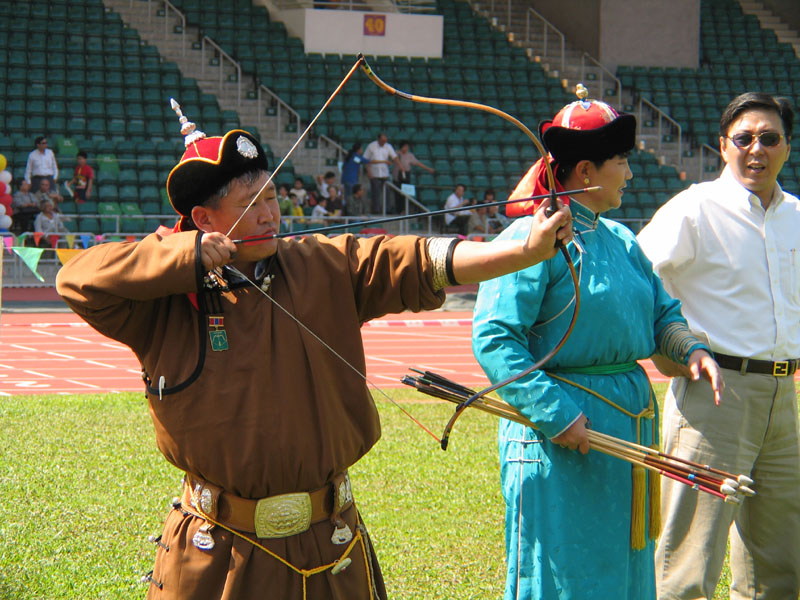
The Carnival was also an opportunity for cultural exchange.
Battumur's first encounter with a Korean bow. Turbileg (right) offered his
services as interpreter for the Mongolian delegation. Byambasuren (General
Secretary of the Mongolian National Traditional Archery Association) is in the
middle.

Col. Kim Ki-hoon demonstrating Korean traditional archery.

Col. Kim Ki-hoon after a successful demonstration.
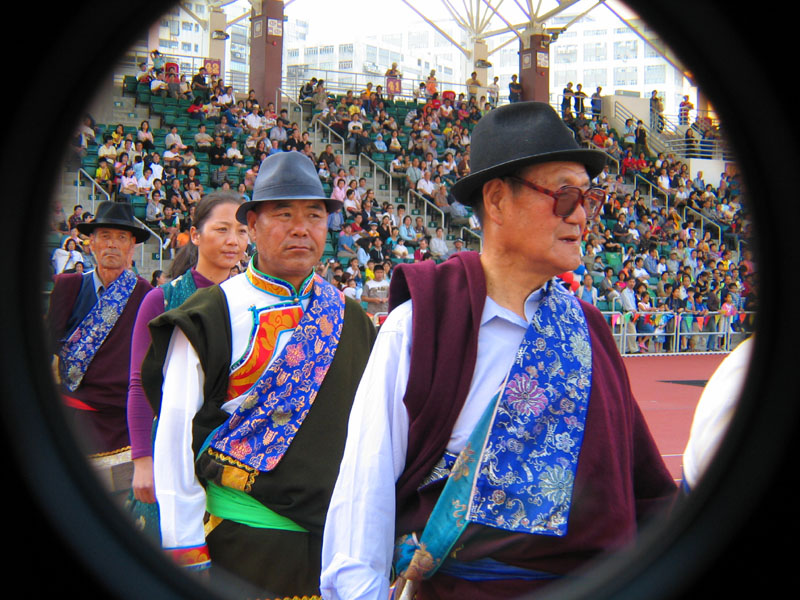
The colorful delegation of Tibetans from Qinghai wowed
spectators with their archery, chanting and dancing. Ms Qi Guihua (Han Chinese Nationality) is a provincial archery coach.
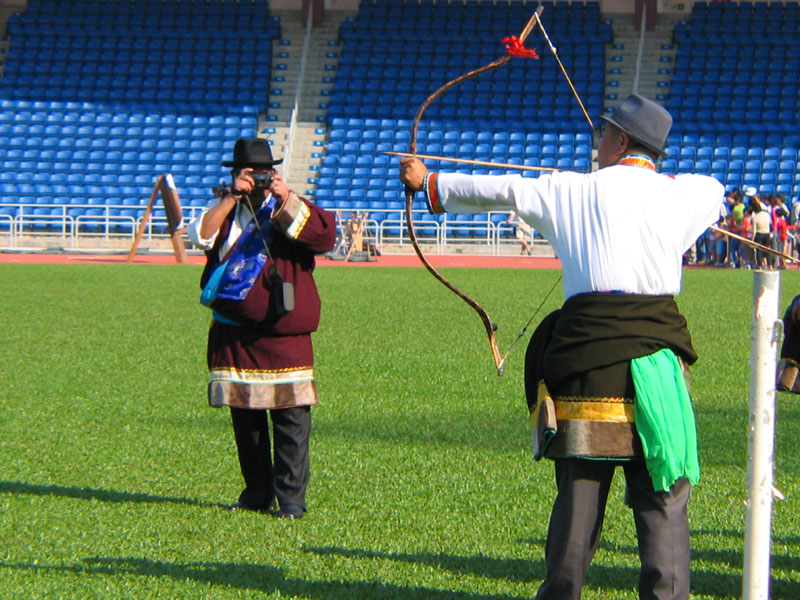
Tibetan archery in Hong Kong - a memorable event to record for the 'folks back
home'.
(Half the stadium was crammed with spectators while the other half was sealed
off to provide a safe area behind the targets.)

Tibetans celebrate every hit on the target with an exuberant
display of traditional singing and dancing.
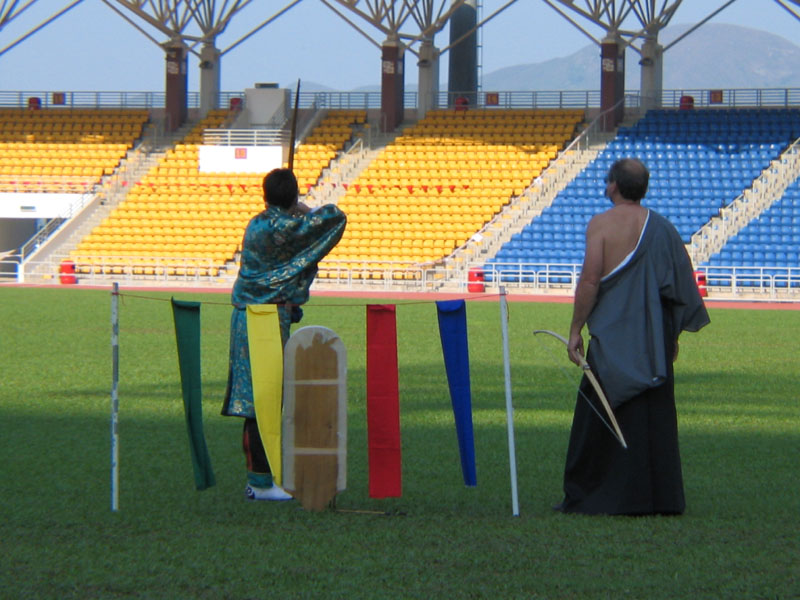
Tsewang Nidup demonstrated Bhutanese traditional archery. Jaap Koppedrayer
decided to have a go, too.

Comradeship: Tsewang Nidup, Col. Kim Ki-hoon and Jaap Koppedrayer.

Battumur demonstrated Mongolian archery as performed at the
annual Nadam Festival. Now you can see how packed the spectator stands were. The
crowd roared with approval each time the Mongolians hit a tiny target over 70
metres away.

Satisfaction at a fine shot: Byambasuren.

We welcomed Hong Kong's modern archers to strut their stuff.
The Carnival did more than promote interest in traditional archery: many people
wanted to know where they could learn the modern, competitive sport.
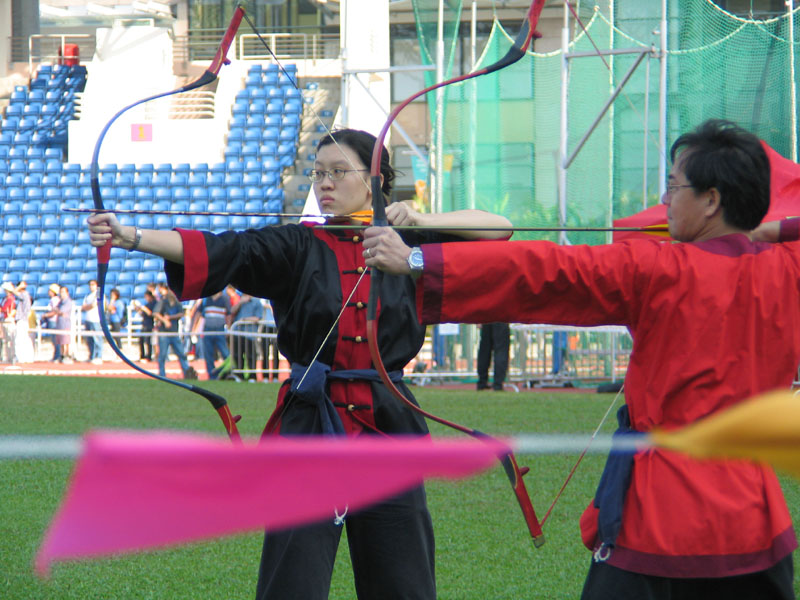
Students of Chinese traditional archery from Hong Kong, Anne
Leung and Li Yuk-fi, demonstrate archery on foot
in the official style for the Qing Dynasty military examination.

To display Chinese military archery, we put on a battle
re-enactment. Villagers fought off marauding pirates using their farming
tools until a Qing army crossbow brigade and cavalry contingent
arrived. The pirates got more than they had bargained for in their encounter
with this feisty villager (Anne Selby).

The Qing infantry (off duty). The Hong Kong Theatre kindly lent
costumes for the re-enactment.
Kirsty Hamilton, Nick Rodgers (Australia), Fung King-on (Hong Kong, who made the
'crossbows'), Emin Vardanyan (Russia) and Steve Chan (Hong Kong).

The Qing army in formation, setting off a deadly fusillade
against the pirates.

The Qing cavalry charges to the rescue! (Tim Selby)
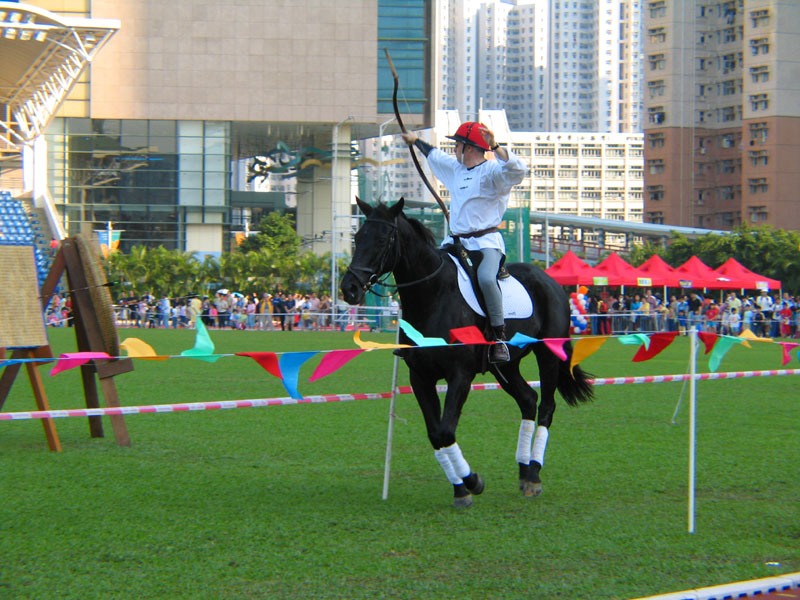
Chinese Qing Military Examination style horseback archery.

Military style Chinese archery - the back shot. (Tim Selby)

The Closing Parade.
These are just the preliminary photographs available now. As more come in, I'll put them up (perhaps streaming video as well.)
What for the future? I think that many people (participants as well as spectators) hope to see this sort of event repeated. Some suggested making every two years (to avoid wearing us all out.) There was a general feeling that this Festival should move to other countries in Asia.
In retrospect, one important point to improve is visibility for the spectators. Archery is not really a spectator sport - especially when watched from a safe distance. Other locations in Hong Kong have monster TV screens where we could give spectators a close-up view of the details.
In contrast to traditional archery meets in the UK (SAA and SPTA) or the US (Denton Hill and Fort Dodge), in the Far East, it is not easy to have large-scale public participation. There are very few experienced archers about, and most of those have never touched traditional equipment. But in the future, an ideal should be to allow the public much greater participation as archers.
Please feed in your views on http://www.atarn.net .
Mr W. F. Lai, Conservator at the Hong Kong Museum of History, has taken some photographs, including X-ray photographs, of a Warring States period crossbow on display in the Museum of Coastal Defence.

Warring States Crossbow : side view.

Warring States Crossbow : oblique view.

Warring States Crossbow : top X-ray view.
November 2003
Born in 1955 in Milan, Italy, Fulvio
Cinquini has been travelling the world of the horse since his twenties. Expert
rider and photographer, Cinquini has ceaselessly explored the domains of the
horse, its geography, its history, its styles of riding, its equipment and its
people, not to mention its legends and its mysteries. He never ceases to record
its beauties.
He has travelled in Tibet, Mongolia, the US,
India and Lesotho and has mounted exhibitions of his photographs in Houston
Texas, Washington DC, Tokyo, Hong Kong and Moscow.
I met Fulvio at his exhibition in Hong Kong,
sponsored by the fashion house Hermès of Paris. My children and I were
enchanted by his work. I urged Fulvio to keep in touch and begged that if in his
travels he encountered horseback archery, he should record what he saw for
ATARN. He promised me that he would.
The Korean Traditional Equestrian Martial
Arts Association (K.E.M.A.) has restored the skills of the former Military
Service Examination of the Cho-sun period, which has not continued in modern
times. They have revived swordsmanship, Gyuk-gu (Korean traditional Polo),
Geobuksun ('turtle boat') Racing and 18 traditional martial arts, and re-enacted
these skills following academic and historical studies.
K.E.M.A. aims to revive the Korean
ancestors’ enterprising spirit and traditional martial arts, in the hope that
they can be handed down to the younger generation. One of K.E.M.A's activities
is study of and training in horse riding martial arts, KI-SA
(horse archery) archery skill on a horseback, which was a compulsory subject in
recruiting military officers in the Chosun Dynasty.
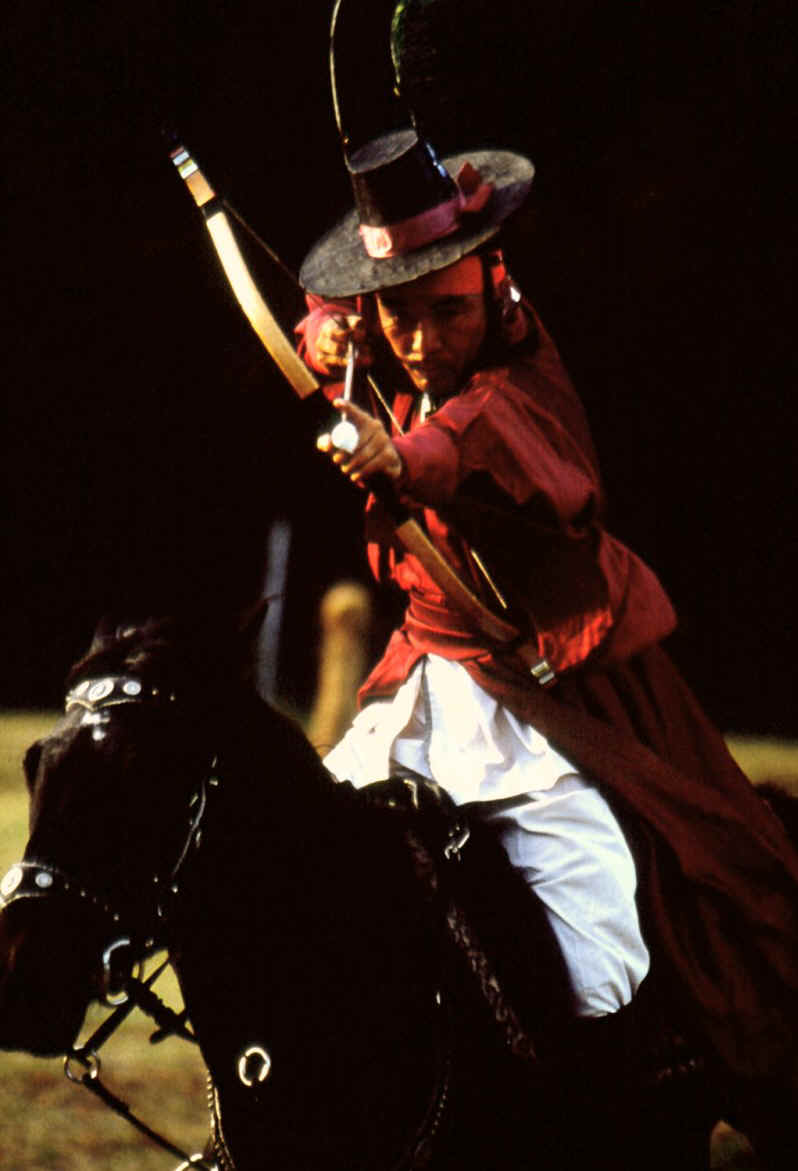
The forward shot. (Note that all these horseback archers use a
western three-finger or two-finger release.)
© Fulvio Cinquini, 2003.

© Fulvio Cinquini, 2003.

The backward shot.
© Fulvio Cinquini, 2003.

© Fulvio Cinquini, 2003.

Chasing the Mo-gu ('fur ball') towed behind a pony.
© Fulvio Cinquini, 2003.
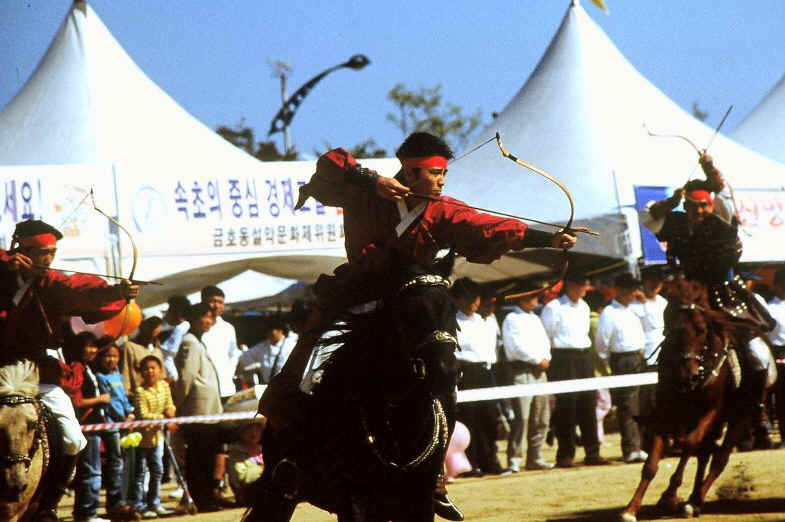
Full tilt chasing the Mo-gu ('fur ball')
© Fulvio Cinquini, 2003.
K.E.M.A. is developing a new practice and performance ground at Sokchu, a resort town on Korea's East Coast. There are a number of different types of competition. The simplest is a single target facing the runway half war down a 150-metre runway. In another, five targets are placed facing the runway at 30-metre intervals. This allows only about 2.5 seconds to re-load and shoot between the targets. In another competition, two targets are placed angled forward and backward halfway down a 150-metre runway.
Finally, there is the game of 'mo-gu', in which three archers chase a ball about one metre in diameter, towed behind a pony. Each archer is allowed three shots and must take one shot forward, one shot sideways and one backwards, all at not less than ten metres from the ball. They shoot using arrows with a soft blunt head dipped in coloured ink, so as to keep track of each archer's score.
Fulvio has just published a book, "Man and Horse: An Enduring Bond", (Pub. Chronicle Books, November 2003 ISBN: 2020593416, price about US$42.) I wish him every success with the book: if his exhibition was anything to judge from, it will be a stunning book! Thanks, Fulvio, for permitting ATARN to publish these photographs.
Cherrie Ann Button of Nottingham England is a former period clothing maker who has worked with museums and
tourist attractions across the UK. Unable to follow her calling due to an
illness, she is planning to take up archery. She has kindly offered to share
with ATARN Members her experience of period clothing and leathercraft in
the form of
illustrations broken down into easy to follow patterns for Middle-Eastern
quivers and bow-cases.
You may save the patterns and copy/enlarge them for the purpose of making the items for your personal use. They should not be used commercially without permission of the artist, Cherrie Ann Button.
Finally, as part of the promotion programme for the Hong Kong Asian Archery Festival, First Place Advertising, Hong Kong, made a short feature in which their presenter , 'Kawai', learns how to shoot a Chinese bow. Although the feature is in Chinese (Cantonese) only, you might get an idea of how to do the thumb draw by looking at it. Thanks to First Place Advertising for permission to web cast the feature.

Windows Media Format streaming video.
And really finally, here is an album of additional photographs of the Asian Traditional Archery Carnival held on 26 October.
January 2004
In December I had the pleasure of making my first visit to Taiwan. Not only was I able to visit the Taipei Palace Museum, the Taiwan Provincial Museum and the Collection of the Academia Sinica, but I was also able to visit ATARN friend, Jang Yokhua.
Yokhua is no stranger to those who frequent ATARNet: he has made a lot of postings and displayed photographs of his bow-making work. Aged 30, Yokhua started shooting seriously at the age of 16 when he was still at secondary school. At that time, American-made hunting bows started to appear in Taiwan and he and some of his friends became interested in them. Several people took up shooting with hunting bows in an indoor range in Taipei. After a while, Yokhua saw an antique Chinese bow in the collection of a friend who collected swords: he realized that horn was used in the construction of the bow; but at that time it did not occur to anyone that sinew was used as well.
Around 1990, after reading articles in some American archery magazines, Yokhua started to experiment with bow making (if you leave aside his first experiments with bamboo bows at the age of 11.) He obtained damaged antique bows from China and cut them up to see how they were made, then he went to the USA to learn from Jaap Koppedrayer, Lucas Novotny and Adam Karpowicz. Armed with his new understanding, he returned to Taiwan and made his first horn and sinew bow.

Jang Yokhua with a recently-sinewed Turkish style bow in
Taipei, Taiwan
Yokhua has devoted himself to making Turkish bows. I asked him why he had not naturally turned his hand to making Chinese bows.
"In China, the traditional bow-makers are not so open about sharing their knowledge," he replied. "Also, it's hard to lay my hands on good materials there. In any case, bows have taken many forms throughout Chinese history: there is no need to make long-eared Manchu bows just because I am a Chinese. The Ming bow design was actually very close to the Turkish form."
Yokhua is interested in horse riding and show jumping, but he hasn't ventured into horseback archery yet. He is keen to find out construction details of other forms of old bows, and perhaps make reconstructions of other historical bows such as Sindh bows, flight bows and the Khotan bow. He also wants to teach other people who wish to learn the craft. As far as his own technique is concerned, he is satisfied with the results he has obtained in sinewing bows, but says that he lacks skills in doing the final decoration.
Next month, Yokhua will be in Hong Kong on a return visit, so I hope he will find things to interest him here.
With kind co-operation from the Taiwan Provincial Museum in Taipei and the collections of the Department of Ethnology of the Academia Sinica, I was able to do a simple survey of the bows of the aboriginal tribes of Taiwan. Before the arrival of large numbers of Chinese ion the Ming Dynasty, Taiwan was mainly inhabited by a number of tribes such as Tsou, Atayal , Paiwan and Saixiat, who may have ultimately be connected to the Nanyue tribes of the Han Dynasty. The tribesmen were head-hunters right up until the 1930s. Many tribes were cruelly massacred during the Second World War for opposing the Japanese.
Early 19th C. European engraving of an Taiwanese Aboriginal
A good description of the archery equipment of Taiwan's aboriginal people can be found in Chen Chi-lu: "Material Culture of the Formosan Aboriginies". Taipei, 1988. There are good drawings on pages 150-151.
Most of the bows and arrows are close to the following form:

Atayal bow (un-braced) and arrow. Bow length 1.2m. Arrow:
90cm.
I had a chance to look at about 20 such bows, mainly from the Atayal and Paiwan people. The general design is as follows: the majority of the bows were made of hard wood - probably black palm. Some were made of bamboo. The string is fixed permanently at one end to a thickened bow-tip which is frequently furnished with an iron ferrule. The other tip has a peg for attachment of a loop at the other end of the string. The strings were all made of plant fibre. At the back of the grip of the bow was a wooden build-out with a carved vertical groove. When unstrung, the string is reversed on the bow-stave and slotted into the groove, which acts as a string keeper. The unstrung bow thus doubles as a staff. When strung, this string keeper is on the back of the bow and does not interfere with the grip. All the arrows were bamboo, self-nocked, and many seemed to have been unfletched, although some fletched arrows were present. Arrowheads were mostly iron and designed for fishing (hence, presumably, the absence of fletching.)
An interesting departure from this standard design was a bow of the Atayal people, on which the 19th Century engraving above was presumably based. There are good drawings in Chen Chi-lu's book. I was unable to find an example other than a single bow that had been converted into a crossbow prod. (Actually, although in the collection at the Provincial Museum the crossbow stock and bow are presented together, I have some doubts about whether they were associated originally: the bow does not fit the rectangular hole in the stock.)

Atayal recurved bow modified as a crossbow prod. (?)
Collected during disarming of Taiwanese villagers by the Japanese Army at a
Saixiat village in the 1930s.
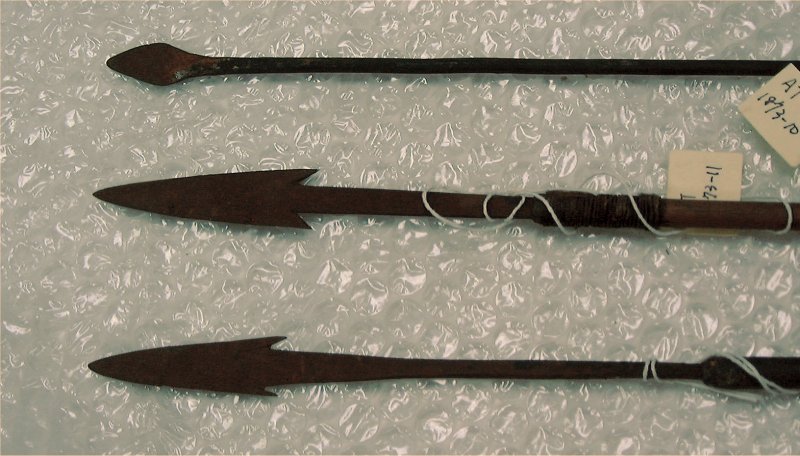
Paiwan Iron Points

Bow-tip with braided loop and arrow nocks: Paiwan tribe.

Quiver: Paiwan Tribe. Collected at Kulalao Settlement, 1930

Atayal archer, C. 1931.

Tsou villager with braced bow and arrows. 1916
(Courtesy Academia Sinica, Taiwan)

Paiwan Villagers, c. 1904
(Courtesy Academia Sinica, Taiwan)
 "Sui"
was the term used in the Chinese Zhou period (about 1100-771BCE) archery rituals
to denote a bracer. Originally, the character was used for a drainage channel
laid along the side of a road. No mention can be found of what these bracers
looked like: indeed we only have the word of Han dynasty commentators writing
much later that this was what the word 'sui' meant.
"Sui"
was the term used in the Chinese Zhou period (about 1100-771BCE) archery rituals
to denote a bracer. Originally, the character was used for a drainage channel
laid along the side of a road. No mention can be found of what these bracers
looked like: indeed we only have the word of Han dynasty commentators writing
much later that this was what the word 'sui' meant.
However, recently I have had a chance to acquire some objects that have been described in catalogues as 'arm-guards used by falconers.' That such objects were arm-guards is likely; but after discussing with falconers attached to the Leeds Armoury in the UK, it is most unlikely that such small, hard and slippery objects would have been a good perch for falcons. I now hold the view that these objects are in fact 'sui' - the bracers used in the Zhou archery rituals. The one illustrated below is a fine specimen made of greenish-white nephrite jade. It is extremely thin (2-3mm), 9cms long and 7.5cms wide. The outer surface is finely carved with cloud scrolls, and 'pan' dragons. It has two rectangular piercings to take a main band to secure it on the lower arm, and four smaller piercings to take thin threads.
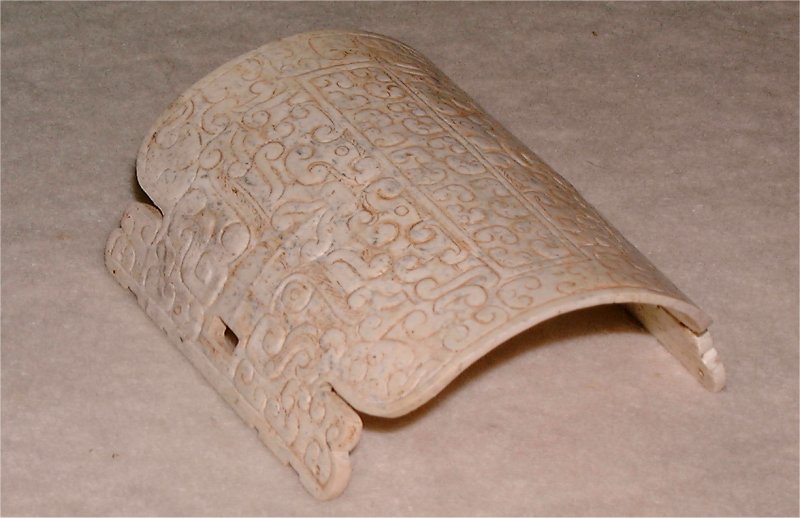
Spring and Autumn Period 'Sui' Bracer in Nephrite

Side view

Inside of bracer (also carved with rough, geometric designs.)

End view

Top view

Bottom (inside) view
I believe that falconry is only depicted in China from the Tang Dynasty. There is no mention of it in early Chinese literary texts. It was prevalent by the Liao (Khitan) Dynasty (907-1125) and it is therefore not surprising that items similar to the one shown above, excavated from Liao burials, are also interpreted as being arm-guards for falconry. But given the very close similarity to the Zhou 'sui', it is worth considering whether the latter objects were not also bracers. I illustrate one in ivory below. (The blue stain is caused by association with copper objects in the grave.
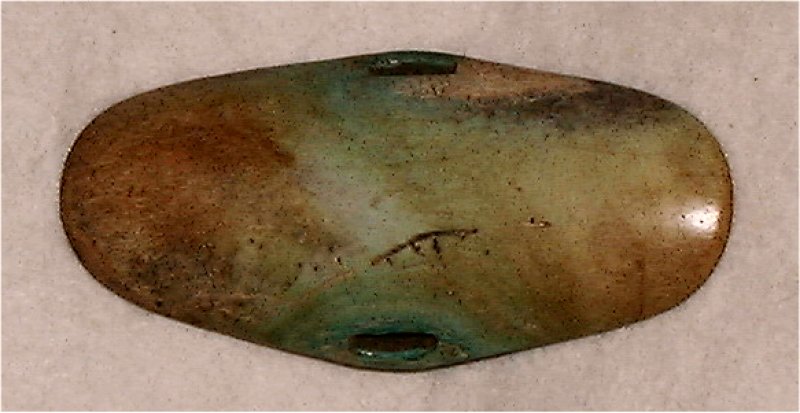
Ivory bracer (?): outside view (Liao). 8 cmx5cm
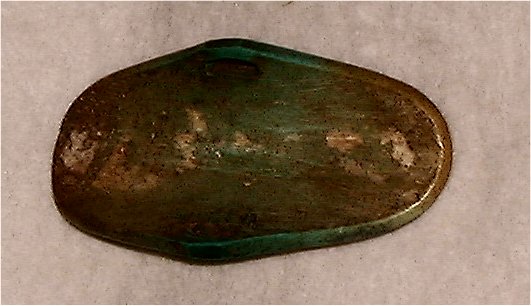
Ivory bracer: inside view (Liao)
I look forward to reading your comments on ATARNet.
March 2004
Chapchal in Yili, Xinjiang, is home to several thousand of the Xibe nationality. The Xibe were a branch of the Manchus, and the present inhabitants of Chapchal are descended from a Manchu banner who were ordered by the Emperor Qianlong to defend China's western borders.
Today's Xibe in Chapchal are the only remaining Manchus who still speak and write their language. Chapchal has its own, Manchu language newspaper and radio broadcasting station. The Xibe are renowned as archers and every provincial archery team in China seems to have some Xibe among their members; yet they have completely forgotten their traditional archery skills and now only practice western-style archery.
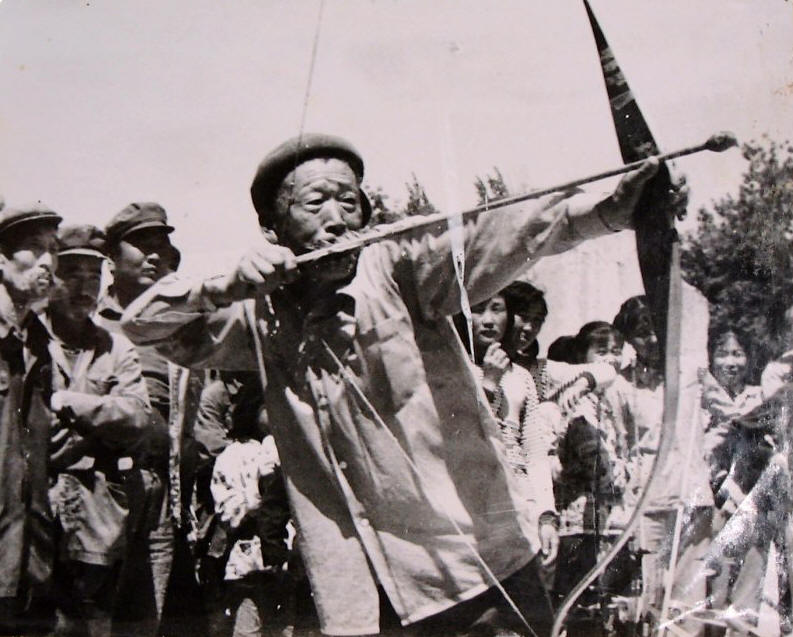
Xibe Archer, c. 1970.
This year, Chapchal Xibe Autonomous County will celebrate its 50th anniversary. At their request, ATARN is donating US$1,300 to purchase reproductions of traditional Manchu bows from Ju Yuan Hao, and I have been invited to hold a two-day traditional archery training course there. They will demonstrate traditional archery together with many other traditional arts at the celebrations from 29 - 31 August 2004. The Xibe have been authorized by the Central Government to start teaching traditional archery as part of the primary school syllabus.
Please let me know if you would like to contribute towards this ATARN sponsorship. (I have already paid the full amount.) And I am sure that any ATARN Members who want to go to Chapchal to join in the celebrations would be welcome.
I have come across three interesting items that can throw some light on archery equipment and techniques in previous ages in China.
|
|
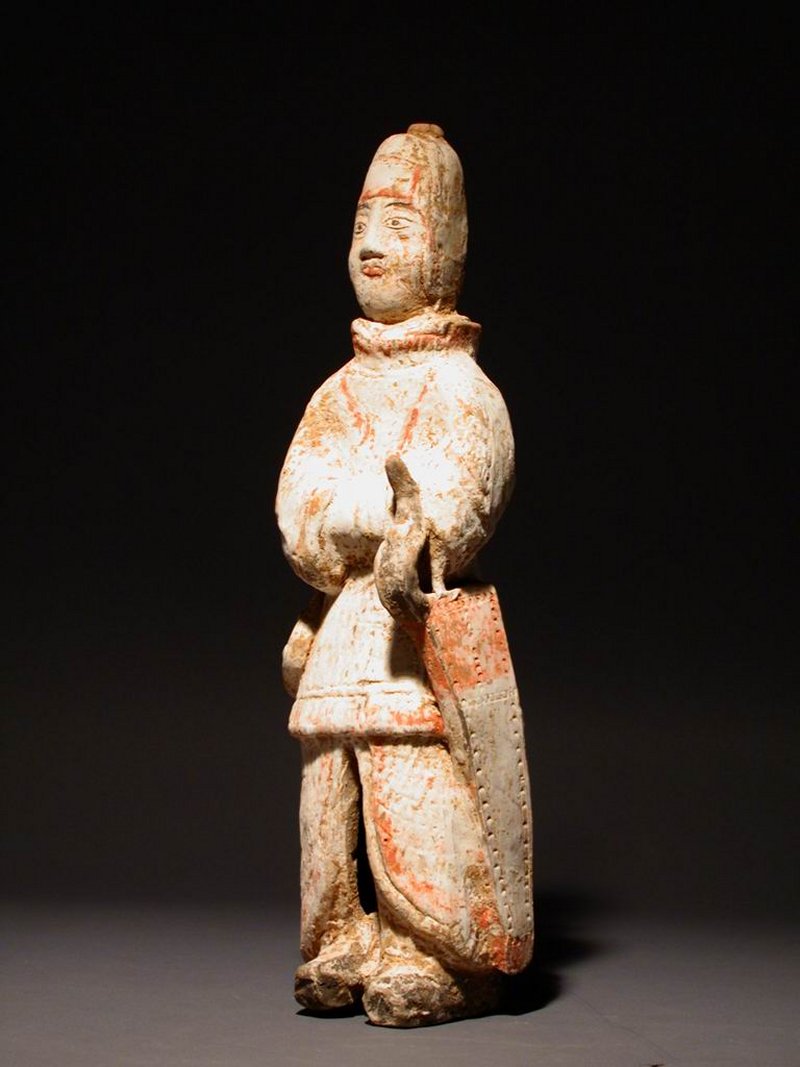 |
Photographs courtesy of Dragon Arts, Hong Kong © Dragon Arts , Hong Kong, 2004
|
|
|
This pottery figure dates from the Northern Wei Period (386CE – 534CE). During the Northern Wei, the north of China was ruled by the Xianbei (also known as the Särbi people - ethnically the precursors of the Xibe!) The Xianbei were originally nomads and were devout Buddhists, who put their prisoners of war to work building Buddhist sculptures in the rock faces of Datong and Luoyang. Their military ranks included women fighters. Hua Mulan was a Xianbei.
Pottery figures of warriors are common burial items in the tombs of the Northern Wei aristocracy; but depictions of archers are rare. This one is well-preserved with its original pigment.
The bow seems to be a composite recurve with broad limbs and short siyahs. Nothing conclusive could be said about the relative length of the limbs; but the bow case is of such exaggerated length that it is tempting to wonder whether the limbs were not very asymmetrical. There appears to be an attempt to show a concave profile of the broad back of the bow-limb.
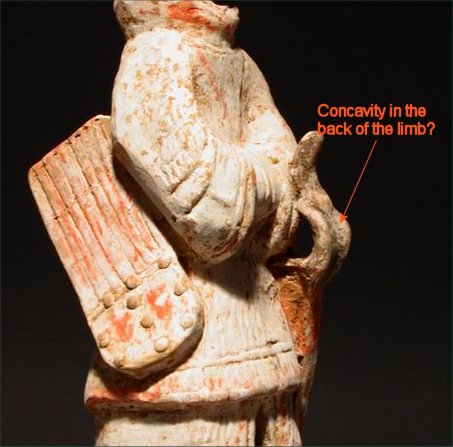
The quiver also brings immediately to mind the quivers used by the Manchus. It is compact and box-like, able to carry a large number of arrows gripped between two felt pads. The design can be clearly contrasted with the wooden back-quivers of the Han, and the closed quivers favoured by the following Tang dynasty.

This gentleman is an archer from the Five Dynasties or Ten Kingdoms Period (907-979CE). He is carved on a tomb door panel from Shaanxi Province. His bow is not a typical Tang design. Behind his left elbow you can see the gaping fish's mouth of his bow case. At his right elbow is the top of a close quiver. We would expect to see the arrows with point upward, but in this carving, the fletching is clearly shown at the open top of the quiver.

Here I have maxed out the contrast so that you can see the detail. The technique of holding two arrows in the draw-hand while nocking the third is reminiscent of some forms of kyudo today.

This archer dates from Northern Song Dynasty (960 – 1127). Both the Song panel and the previous one give the subject matter the same treatment, as both are tomb door panels to frighten away tomb raiders. (They failed.) The Song panel is more schematic and it would be difficult to say much about archery equipment or technique from looking at it.
Page last up-dated on 18 March, 2004